|
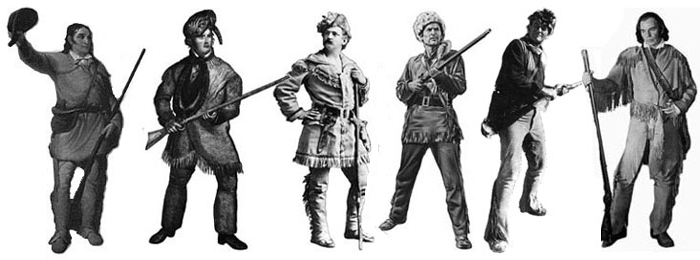
"RING-TAILED ROARER"
Davy Crockett On Stump, Stage and Screen
Excerpts from the upcoming book by Jeff Hause
"Almost all non-literate mythology has a trickster-hero of some kind. ... And there's a very special property in the trickster: he always breaks in, just as the unconscious does, to trip up the rational situation. He's both a fool and someone who's beyond the system. And the trickster represents all those possibilities of life that your mind hasn't decided it wants to deal with. The mind structures a lifestyle, and the fool or trickster represents another whole range of possibilities. He doesn't respect the values that you've set up for yourself, and smashes them."
—Joseph Campbell, interviewed by Michael Toms in "An Open Life" |
"Movies are hardly ever about what they seem to be about. Look at a movie that a lot of people love, and you will find something profound, no matter how silly the film may be."
—Roger Ebert, "Life Itself" |
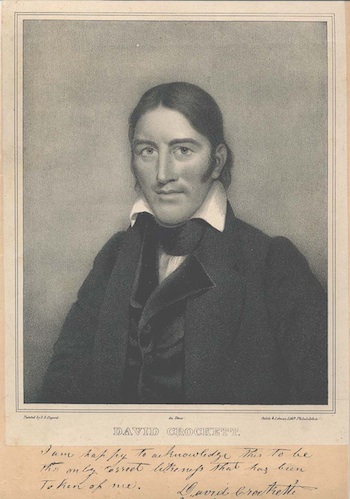
Portrait of David Crockett (1786-1836) painted by S.S. Osgood. Writing at bottom with signature and inscription: "I am happy to acknowledge this to be the only correct likeness that has been taken of me." Image: Tennessee State Library and Archives, 403 Seventh Avenue North Nashville, TN 37243. |
David Crockett was born first on August 17, 1786, in North Carolina, near the mouth of Limestone Creek on the Nolichucky River—the fifth son to John and Rebecca Crockett. I wrote "born first," because several decades later, he was born again—this time to "Davy Crockett senior," who could "grin a hail storm into sunshine," and his momma, who could "jump a seven rail fence backwards and dance a hole through a double oak floor." This Crockett was raised in cradle made from the "12-foot shell of a 600-pound snapping turtle," varnished with the oil of fifteen rattlesnakes, and covered in wildcat skins! A hundred years later, Crockett was born yet again—this time on a mountaintop in Tennessee, and he "kilt him a bear when he was only three." The first scenario is biographical fact, the second is taken from an almanac written twenty years after the first Crockett's death, and the last was written into a film script during the mid-20th Century, at the dawn of the New Frontier. All are as truthful as they need to be.
The real David "Davy" Crockett was a soldier, a U.S. Congressman, and died heroically at the Alamo, but his greatest contribution to the American culture was that he inspired the first truly unique, nationally-recognized comic character. The real Crockett was brash, cocksure and adventurous, and he symbolized the ever-expanding West. Since then, however, Crockett has been portrayed in remarkably diverse ways—interpreted by succeeding generations in terms that made sense to those particular times. As a result, each "Davy" representation will tell you more about the period the portrayal was created in than about the real David: In the years after his death, Crockett lost his anti-Jackson political affiliations and was characterized as a brash, uncouth "yaller flower o' the forest"—based on a fiction that the real Crockett helped popularize. Then in the latter part of that century, as the frontier began to disappear, Davy became a sentimental figure—a noble, illiterate backwoodsman still living with his mother. In the Twentieth Century, Davy kept the world safe for white women in producer D.W. Griffith's racist Alamo silent picture... and then Disney came along and cleaned him up for the kids. After that, John Wayne made him political again, even gave him a Mexican love interest, and played him as, well, John Wayne; Brian Keith played him as... well, I have no idea what Brian Keith was thinking. In 2004, Billy Bob Thornton's Davy was seen as a man trapped in a fiction; a celebrity Crockett for the star-obsessed twenty-first Century when people were just 'famous for being famous'.
As Michael A. Lofaro put it on Crockett's 200th birthday: "One of the primary reasons that assures the continuance of Davy Crockett as a quintessential American hero is his ability to be nearly all things to all people. So great a quantity of primary material from the popular press and media exists that when eager readers or critics delve into the various 'autobiographies,' tall tales in newspapers and especially almanacs, dime novels, plays, movies, and television shows, they invariably manage to discover a good deal of evidence to support the virtues or vices, the significance or lack of it, that they think or hope they might find in his character."
This book considers the evolution of Crockett in performance. Most enduring fictional characters change with the actor and the times. But David Crockett was real, and different aspects of the actual man were exploited or discarded with each succeeding generation over the course of 200 years—nearly the entire history of the United States. Some portrayals, like Fess Parker's and John Wayne's, became sensations and their characterizations say a lot about the culture of the time. Of course there will be portrayals listed in this book that didn't catch on—but that says something about the culture of the time, too.
The real David Crockett's story ended on a cold morning in 1836—but his legend has proven to be much more resilient, and much more malleable to fit the times. Therefore, this isn't just the story of David Crockett—this is the story of a country, and of us.
1: THE STUMP
"When I set out electioneering, I would go prepared to put every man on as good footing when I left him as when I found him. I would therefore have me a large buckskin hunting shirt made, with a couple of pockets holding about a peck each ... in one I would carry a big twist of tobacco, and in the other my bottle of liquor; for I knowed when I met a man and offered him a dram, he would throw out his quid of tobacco to take one, and after he had taken his horn, I would out with my twist and give him another chaw. And in this way he would not be worse off than when I found him; and I would be sure to leave him in a first-rate good humour."
—"A Narrative of the Life of David Crockett of the State of Tennessee" by David Crockett (with Thomas Chilton) |

Image from "Life of Davy Crockett, the original humorist and irrepressible backwoodsman." Philadelphia: Porter and Coates, 1865. |
The first person to play Davy Crockett onstage was... well, Crockett himself. Therefore, any examination of the growth of the legend must begin with the real man—or at least the man Crockett portrayed.
A poor farmer (but a great hunter), he told tall tales about himself and became famous enough to get elected to Congress three times.
David first campaigned for the Tennessee state legislature in 1821. At debates, he always waited to speak until after his opponents, so that he could learn the local issues on the fly. If he was forced to talk first, he would tells a few jokes, then invite everyone to the nearest bar—with the drinks on him. (This is a tactic he would employ many times during his political career.)
In 1823, David was convinced to run again for the legislature in a much larger district, and was looking for a hook in order to reach more voters and make a name for himself. Crockett reinvented himself politically as a wild backwoodsman. He claimed to be "half-horse and half-alligator," and that he waded the Mississippi with a steamboat on his back. "I don't want it understood that I have come electioneering. I have just crept out of the cane, to see what discoveries I could make among the white folks," David said.
David was easily elected, now representing ten different counties. Known throughout the state, David was urged to run for the U.S. Congress.
A better-funded opponent narrowly beat Crockett in the next election, so he attempted to improve his financial lot and started a stave business. Between bear hunts in the spring of 1826, David attempted to run two boats of 30,000 staves to New Orleans, but they sank in the Mississippi River. Crockett was nearly drowned, until pulled from below deck of the sinking ship. Stranded in Memphis, David met wealthy Marcus B. Winchester,¹ who took immediately to David and urged him to run for Congress again. Winchester bankrolled Crockett's next political campaign with a loan of $250. While electioneering, Crockett began using the "brag and boast" hyperboles of the Mississippi flatboatmen that he had met while operating the stave business. He appeared all over the state, stumping with his usual tales of grinning animals to death and jumping rivers. David's opponent, Colonel John W. Cooke, attacked David on the grounds of decency (namely drunkenness and adultery). But for every charge Cooke made, David would make up a worse charge about Cooke. Eventually, Cooke planned to trap Crockett by presenting witnesses to refute him at their next debate. At the event, Crockett stepped up first, out-doing himself with slanderous accusations, then starts to sit... but suddenly he stepped back onstage, announcing that he knew his opponent was planning to trap him: "Fellow citizens, I did lie. They told stories on me, and I wanted to show them, if it came to that, that I could tell a bigger lie than they could. Yes, fellow citizens, I can run faster, walk longer, leap higher, speak better, and tell more and bigger lies about my competitor, and all his friends, any day of his life!" David then proposed that both sides drop all the accusations, and invited the crowd to the local tavern for a drink before Cooke could rebut, leaving to cheers. Cooke withdrew from the race, saying he would not consent to represent people who would applaud an acknowledged liar.
So in 1827, David was elected the House of Representatives, serving in the Twentieth Congress. The Jackson Gazette reported that he, quote, "arrived in Washington City on the 8th day of Dec. and took his seat. It was reported before his arrival there, that he was wading the Ohio towing a disabled steamboat and two keels." (In reality, Crockett arrived in Washington after a recurrence of malaria. Several bloodlettings, the accepted frontier cure at the time, left him in worse health than the sickness.)
David's rustic appearance caused a buzz in Washington. He was ridiculed by his political enemies as a vulgarian. Rumors even circulated that he mistakenly drank out of a finger bowl at a White House dinner for President Adams—which became so talked about that he had to have it rebutted in newspapers. But a strange response occurred: The attacks made David more popular! The generation of Americans inheriting the country from the Founding Fathers, the first to be born in an independent nation, was looking for a new kind of hero to represent that independence. David, the trash-talking son of poor squatters who had risen to the heights of Congress, became the confident, outspoken symbol of the new society—using the distinctively bawdy, humorous language of the frontier. Politics would never be the same.

David's notoriety and political career were still growing (he was called the "gentleman from the cane" as an insult, but it caught on). His main ambition in Congress was to pass a land bill that would help the poor squatters in his constituency obtain land for a reasonable price, by allowing for transfer of the federal lands in Tennessee to state control—and their sale by the state to the public at pennies on the dollar. But Crockett found it hard to navigate the back-room games and compromises in Washington, and the bill stalled.
In 1829, Crockett was re-elected to serve in the Twenty-first Congress while his general in the Creek War, Andrew Jackson, was elected President. Promoting himself as the leader of the common man, Jackson invited "the people" to eat at the White House and celebrate his victory. To Jackson's regret, thousands of revelers swarmed into the White House, wrecking furniture, smashing several thousand dollars worth of china and glassware, and generally destroying the place. Finally, to draw the crowd outside, tubs of liquor were placed on the lawn. Jackson snuck out of the place through a back window. He then slept in a hotel while repairs were made to the residence. While it isn't known if Crockett attended, it wouldn't be surprising if he did.
While Jackson was sleeping in that hotel, Crockett took up residence at the boarding house of Mary Ball. Boarding houses were a common dwelling for 19th-Century politicians to eat and sleep. Congressmen typically chose which Capitol Hill boarding house they would lodge in based on their state or on their political affiliation, and these groups were known as "messes." Crockett was lodged in the same room at Mary Ball's as a new Representative from Kentucky, named Thomas Chilton (1798-1854). The two men rapidly became friends and would spend the better part of the next six years as political allies, and Chilton would be instrumental in the creation of the Crockett legend.²
"I have no other feelings towards Colonel Crockett than those of pity for his folly."
—James K. Polk |
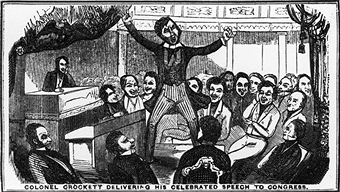
Image from a Crockett Almanac |
On May 19, 1830, David proved his independent nature—being independent both of political parties and his constituents: He spoke out fiercely against President Jackson's 'Indian removal bill'—virtually the only Congressman to do so. The bill was to move all Native Americans from their homes, to lands west of the Mississippi. But Crockett represented many Indians who had settled in his districts and even married into established families. In a speech to Congress on May 19, 1830, according to the record: "Mr. C said that four counties of his district bordered on the Chickasaw Country. He knew many of their tribe; and nothing should ever induce him to vote to drive them west of the Mississippi." Disgusted by the government's handling of Native Americans, David said that he had remained a Jackson man—even though Jackson hadn't, and declared he would "set up shop for himself." Still, David had to suppress the record of his speech, because his constituency (most of who want the cheap Indian land as well) was for Jackson and the bill.
In 1831, David ran for reelection, and the Jackson political machine set out to destroy him: They successfully conspired to table his land bill in Congress (thus destroying the dreams of many of their own citizens in the process, but hey—that's politics), then published his speech against Indian removal all over the state. "It would seem that the sufferings of a hungering people excites no pity with our President," Crockett wrote in a February 1831 campaign circular, "and that all the miseries of famine, brought on by his own acts, are to be used as the instruments for their extermination or removal."
David fought back as best he could as he ran for re-election, but the attacks were fierce. The Missouri Republican newspaper printed this supposed campaign speech by David: "Friends, fellow citizens, brothers and sisters: Governor Carrol's a statesman—Jackson's a hero and Crockett's a horse!!! . . . they accuse me of adultery, its a lie. I never ran away with any man's wife that wasn't willing in my life. They accuse me of gambling; it's a lie—for I always plank the cash. Finally . . ., they accuse me of being a drunkard; it's a damned lie, for whisky can't make me drunk!"
During the course of these attacks against his ethics, David seems to have lost his most valuable asset—his sense of humor. In Paris, Tennessee, he threatened to thrash political opponent William Fitzgerald in public for saying that he rarely showed up for roll calls in Congress. Fitzgerald stood to speak, saying he'd prove his charges, and Crockett angrily rushed the stage to fight. In response, Fitzgerald pulled a pistol from under a handkerchief, aiming it at Crockett's chest. Crockett sat back down, humiliated in front of the large crowd. While it was probably a smart move for David to back down, it wasn't what the public expected or even wanted to see from "Davy."
So, very un-heroically, David lost the election—due to both his opposition to Indian removal and his support for high tariffs and for internal improvements (sorry, all you Conservative Davy-lovers who think he stood for smaller government)—all highly unpopular in Tennessee . . . And along with his loss, Tennessee citizens continued to lose their land, the 'Indian bill' passed, and the Trail of Tears began. Driven out of Congress and still deeply in debt, David went home—a failure once more.
While "Old Hickory Face" had driven David out of office, he was not out of the public's eye. On April 25, 1831, James Kirke Paulding's play The Lion of the West opened at the Park Theater in New York City. James Hackett played the hero: Nimrod Wildfire, a colonel, a congressman, a great hunter, and a "gentleman from the cane." He wore an outrageous animal pelt on his head and made fanciful boasts, repeating many of the things David had said. Crowds immediately made the association, and the play was a huge success for both Hackett and Crockett.
2: THE STAGE
"It is time that the principal events in the history of our country were dramatized, and exhibited at the theatres on such days as are set apart as national festivals."
—Andrew Jackson, quoted in 'The Making of the American Theatre,' by Howard Taubman, published New York: Coward McCann, Inc., 1965, p. 71-72 |
"What a pity it is that these theatres are not contrived that everybody could go; but the fact is, backwoodsman as I am, I have heard some things in them that was a leetle too tough for good women and modest men; and that's a great pity, because there are thousands of scenes of real life that might be exhibited, both for amusement and edification, without offending."
—'An Account of Colonel Crockett's to the North and Down East, in the Year of Our Lord One Thousand Eight Hundred and Thirty Four,' by David Crockett (and William Clark). Philadelphia: E.L. Carey & A. Hart. 1835 |

Image from "Scribners" (Collection of the author) |
There were various theatrical representations of Crockett while he was in Congress. Songs about Crockett were performed all over the country in concerts and minstrel shows. (See Appendix C.) For instance, J.C. Mossie was touring the theater circuit in a show that featured his impressions of Crockett, Clay, Webster, and Van Buren. In the show, the Crockett monolog was titled, "Crockett's protests against the dandified, the soft talkers, and the effected." (Massachusetts Salem Gazette, May 6, 1834)
Still, the most popular stage characterization based on Crockett during his lifetime was named Nimrod Wildfire, an uncouth Congressman from out of the West. He even drawls when he writes: "I'm half horse, half alligator, a touch of the airth-quake, with a sprinkling of the steamboat! 'If I an't, I wish I may be shot. Heigh! Wake, snakes, June bugs are coming.' Good bye. Yours to the backbone. Nim Wildfire." The character was originated by James Henry Hackett (1800-71), a New York-bred actor and manager. He had studied law and went into business before making his acting debut at the Park Theater in 1826. Hackett was considered the finest Shakespearean comedian of his day, but to most playgoers he was a favorite because of his Yankee characterizations.
On Saturday, November 27, 1830, Hackett announced the winner of a play competition he had created for "an original comedy whereof an American should be the leading character." The prize was $300, and William Cullen Bryant, Fitz-Greene Halleck, James G. Brooks, James Lawson, Prosper M. Wetmore, and William Leggett were the judges. The winner was one of the foremost figures in American literature at the time—James K. Paulding. The bigger winner, however, would be David Crockett. In 1830, Paulding asked well-traveled painter John Wesley Jarvis to supply "a few sketches, short stories & incidents, of Kentucky or Tennessee manners, and especially some of their peculiar phrases & comparisons... If you can, add or invent a few ludicrous Scenes of Col. Crockett at Washington." (Crockett was then serving his second term in the House of Representatives.) Paulding used them to invent the character of Colonel Nimrod Wildfire of Kentucky, a harsh-talking Congressman, "half horse, half alligator."
Two days after the announcement, the New York Courier and Enquirer said Paulding hoped the play "might come to be relished by an American audience, and at length become the vehicle of national character and national feeling," and that the hero was "a member of Congress from Kentucky, full of amusing eccentricity of character and peculiarity of expression."
Everybody knew who the hero was based on: He was then serving his second term in the House of Representatives. Word in newspapers of the work, and word of mouth from the public, immediately connected the character to Crockett. Not wanting to offend, Paulding sent Crockett a message on December 15, 1830, through Congressman Richard Henry Wilde of Georgia: "You will also I hope do me the favour to assure him, provided your knowledge of me will justify the assurance, that I am incapable of committing such an outrage on the feelings of any Gentleman." Crockett wrote back, assuring him no offense was taken, thanking him for his "civility in assuring me that you had no reference to my peculiarities." Crockett biographer James Shackford speculated "a literary hoax which may have been an essential part of the whole wig campaign to make David a more powerful anti-Jackson weapon in the hands of the friends of the U.S. Bank."
Paulding started a campaign of his own, as well. The New York Mirror reported the week before the opening: "The prize play, the 'Lion of the West,' will, we understand, be brought out on Monday evening next, for the benefit of Mr. Hackett. The manner in which this piece has been announced in some of the newspapers, with the most friendly intentions certainly, is, we think, calculated to excite expectations which will not be realized. It may, therefore, be proper to state, in justice to the author, and we do so at his request, that it does not aspire to the rank of a regular comedy. It was written with the desire to introduce Mr. Hackett to the public in a new character, and to aid in producing a taste for dramatic performances, founded on domestic incidents and native manners. The author had no idea of becoming a candidate for the prize offered by Mr. Hackett, but circumstances induced him to consent that it should take that course. Another error has likewise been propogated through the same medium. It has been stated that the principal part was designed to represent a member of congress, somewhat noted for his eccentricities. The author disclaims such an intention." (4, p. 335)

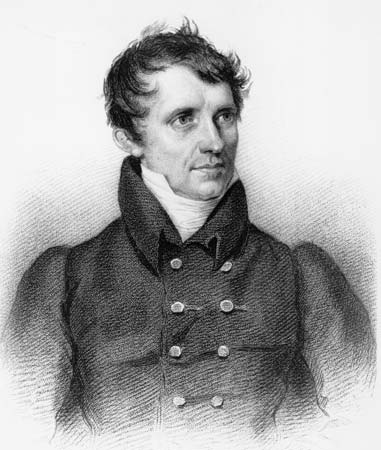
James Kirke Paulding (Collection of the author) |
Paulding used stories like this to invent the character of Colonel Nimrod Wildfire of Kentucky, a harsh-talking Congressman, "half horse, half alligator." Brash, cocksure and adventurous, he symbolized the ever-expanding West. Crockett had risen to a position of true power in government that had never been possible for someone from his station before, using that very character—and Crockett's influence made the character even funnier. This was a new, very American phenomenon in which a poor Tennessee farmer could promote himself to a level in society previously reserved for the very wealthy or through supposed divine right... it was a naturally funny, fish-out-of-water situation, and it was real, damn it!
But not everybody was in on the joke. French philosopher Alexis de Tocqueville visited the country in 1831 to research his book De la Démocratie en Amerique (1835). After meeting Crockett, he pondered the problem with letting the lower classes vote: "Two years ago the inhabitants of the district of which Memphis is the capital sent to the House of Representatives in Congress an individual named David Crockett, who had received no formal education, could read only with difficulty, had no property, no fixed dwelling, but spent his time hunting, selling his game for a living, and spending his whole life in the woods."
The play was the first American-made blockbuster, with Hackett averaging a nightly box-office take of $900 during November of 1831. However, while the character of Wildfire was a hit, the play was not satisfying to Hackett and Paulding, so it was immediately withdrawn for revisions, which Paulding allowed John Augustus Stone to write. Stone retained only the basic plot and the character of the Congressman, and then added a reserved British woman named Albina Towertop for contrast to Wildfire. Hackett then took The Lion of the West on a national tour throughout 1831 and 1832. Afterwards, new material by Paulding was incorporated after a series of newspaper columns he had written in July and August for the New York Mirror, in which he satirized Mrs. Frances Trollope, British author of a travel book entitled Domestic Manners of the Americans.³ The articles told of an imagined meeting between her and Wildfire, "one of the most decidedly celebrated and popular men in America." The character of Albina Towertop was then changed to Mrs. Amelia Wollope from England, whom has come to New York to "ameliorate the manners of the Americans."
In the new story, Wildfire hears that she's in New York and offers to visit. He is told to send up a card, and he sends up a king of clubs. Finally, they meet:
MRS. WOLLOPE: May I offer you a cup of tea?
WILDFIRE: Much objected to you, madam. I never raise the steam with hot water—always go on the high pressure principle — all whisky.
MRS. WOLLOPE: A man of spirit! Are you stationed in New York, sir?
WILDFIRE: Stationed—yes! But don't mean to stop long. Old Kaintuck's the spot. There the world's made upon a large scale.
MRS. WOLLOPE: A region of superior cultivation—in what branch of science do its gentlemen excel?
WILDFIRE: Why, madam, of all the fellers either side of the Alleghany hills, I myself can jump higher-squat lower-dive deeper-stay longer under and come out drier.
MRS. WOLLOPE: Here's amelioration! And your ladies, sir?
WILDFIRE: The galls! Oh, they go it on the big figure too-no mistake in them. There's my late sweetheart, Patty Snaggs. At nine year old she shot a bear, and now she can whip her weight in wild cats. There's the skin of one of 'em. [Takes off his cap.]
Hackett then took the show to Covent Garden in London, and he had it rewritten by William Bayle Bernard, cutting it down from three acts to two. It was re-titled The Kentuckian, or a Trip to New York, and the character of Mrs. Wollope was changed to "Mrs. Luminary," as not to offend British audiences. Completely rewritten twice, the only constant in the play was the character of Colonel Nimrod Wildfire.
Enter servant, with letter.
SERVANT
A letter, Mr. Freeman.
FREEMAN
Ha, from my nephew, Colonel Wildfire.
MRS. FREEMAN
Indeed!
FREEMAN
It is dated Washington, and he is now on the road to New York to spend the summer with us.
MRS. FREEMAN
I regret to hear it.
FREEMAN
Regret!
MRS. FREEMAN
Unless he has corrected that barbarity of which I have heard such descriptions.
FREEMAN
Come, come—consider the circumstances of his education. My sister emigrated to the heart of the Backwoods when they were much less settled than at present. This Nimrod was born a thousand miles from good society, and if his manners are abrupt, they convey a native humour which I think highly entertaining. Listen to this letter.
(Reads.)
"Uncle Peter—Washington, July 1st. Here I am, only two day's journey from New York! The very day I got your coaxing letter I packed up my shirts and some other plunder and set right off a horse-back under high steam. On my way I took a squint at my wild lands along by the Big Muddy and Little Muddy to Bear Grass Creek, and had what I call a rael roundabout catawumpus, clean through the deestrict. If I hadn't I wish I may be te-to-taciously ex-flunctified."
MRS. FREEMAN
There, Mr. Freeman, what do you term that?
FREEMAN
The veritable Kentucky vocabulary. Stay—hear the conclusion.
(Reads.)
"But, Uncle, don't forget to tell Aunt Polly that I'm a full team going it on the big figure! And let all the fellers in New York know—I'm half horse, half alligator, a touch of the airth-quake, with a sprinkling of the steamboat! 'If I an't, I wish I may be shot. Heigh! Wake, snakes, June bugs are coming.' Good bye. Yours to the backbone. Nim Wildfire."
Despite their assurances to each other that no connection should be inferred between Wildfire and Crockett, both David and Hackett obviously loved the attention the association brought. Shackford wrote that the play "tremendously nationalized and pictorialized the name reputation of David Crockett, and precipitated about his name much of the current tall-tale legend of the West."
By 1832, David's fame was growing wildly... even though he was not taking part in it. Around this time, Matthew St. Clair Clarke, a rich eastern Whig who worked as the Clerk of the House of Representatives, visited Crockett at his home in Weakly County, Tennessee. Clarke reportedly found Crockett living alone, deeply in debt, sleeping on the earthen floor of his cabin in animal skins, and eating meals of bear meat with a Bowie knife and cane fork. Clarke informed Crockett that the Whig Party was looking at him as their answer to Democratic President Andrew Jackson — as the true representative of the "common man" — and that the party was interested in backing Crockett as their candidate in the next Congressional election.
To energize David's campaign, they agreed to publish a book of his exploits (and possibly to pay back some of the Whigs that have been loaning David money). St. Claire Clarke returned home and either wrote or commissioned (depending on whose account you believe) The Life and Adventures of Colonel David Crockett of West Tennessee, by "Anonymous." The book was later re-titled Sketches and Eccentricities of Colonel David Crockett, and its authorship was attributed to Whig writer James Strange French. When the biography was re-published by a larger company out of New York it became immensely popular, although David received no royalties from the sales. It is part biography and part humor book, with several chapters being folk tales written in a thick Dutch accent (which is a popular form of storytelling at this time on the frontier). David now became the second most famous man in the country — after Andrew Jackson. But David's fame wasn't based on war heroics or political achievement — it was based on his personality. He became the first man in American history to be famous just for being famous — the first "celebrity."
STAGE VERSION: "I'm half horse, half alligator, a touch of the airth-quake, with a sprinklin' of the steamboat! 'If I an't I wish I may be shot! Heigh! Wake snakes, June bugs are coming.'"
—"The Lion of the West" (1831) |
BOOK VERSION: "I am that same David Crockett, fresh from the backwoods, half-horse, half-alligator, a little touched with the snapping turtle; can wade the Mississippi, leap the Ohio, ride upon a streak of lightning, and slip without a scratch down a honey locust; can whip my weight in wild cats, --and if any gentleman pleases, for a ten dollar bill, he may throw in a panther,--hug a bear too close for comfort, and eat any man opposed to Jackson."
—"The Life and Adventures of Colonel David Crockett of West Tennessee" (1833) |
Strangely enough, David's notoriety was growing so quickly that it began to fold in on itself: In creating dialogue for David in the book, the writer incorporated dialogue from The Lion of the West (which had, in turn, incorporated dialogue from David's speeches). Suddenly the real David and legendary Davy are stealing from each other, several times over.
Crockett was supposedly outraged by the caricature that the book presented of him, but found once again that it made him even more popular. Thanks to the media blitz of books and plays, he was now one of the best known men in the United States. The Whigs then backed him for reelection. Whig leader Nicholas Biddle, who ran the United States Bank, even loaned David money, then struck the debt from his accounts.
"I have seen a great man. No less of one than Col. Crockett. I . . . sat close by him so I had a good opportunity of observing his physiognomy. . . . He is wholly different from what I thought him. Tall in stature and large in frame, but quite thin, with black hair combed straight over the forehead, parted from the middle and his shirt collar turned negligently back over his coat. He has rather an indolent and careless appearance and looks not like a 'go ahead' man."
—Seventeen-year-old Helen Chapman to her mother in 1834, in a letter which she tells of seeing David Crockett in New York City. |

Chapman's portrait of Crockett |
In 1833, David ran again for the Twenty-third Congress, and won. Now he played to his legend completely, posing for several portraits, but complained they made him look like "a sort of cross between a clean-shirted Member of Congress and a Methodist Preacher." In an attempt to create a painting that is more in line with his image, David posed for a full-length portrait with hunting dogs (he wanted mutts that looked like their tails had been bitten off by bears), a linsey-woolsey hunting shirt, broad rounded hat (no coon-skin), leggings and moccasins — none of which he personally had, and rounded up from all around Washington. Painter John Gadsby Chapman attempted to write David's name on his hunting knife as an engraving, but could only fit in enough letters to spell "Crocket." David approved of the spelling, saying the second 't' was totally unnecessary.
Chapman wrote that Crockett "rarely, if ever, exhibited either in conversation or manner, attributes of coarseness of character that prevailing popular opinion very unjustly assigned to him." One day they met on Pennsylvania Avenue, as Crockett was coming out of a long congressional debate, looking "very much fagged." Chapman said, "You look tired, Colonel, as if you had just gone through a long speech in the House." Crockett answered, "Long speech to thunder ... there's plenty of 'em up there for that sort of nonsense, without my making a fool of myself, at public expense. I can stand good nonsense — rather like it — but such nonsense as they are digging up yonder, it's no use trying to — I'm going home."
Finally, Hackett brought the show to the nation's capital in 1833, when Hackett played Wildfire scenes from the play in a command performance for the Washington elite, with David Crockett himself in attendance:
The New York 'Spirit of Times', reported on 21 December 1833:
| "The Washington Correspondent of the Patriot, says: "Col. Crockett made a prodigious figure last night at the Theatre. Hackett was to play Nimrod Wildfire — and Col. Crockett attended by invitation. A whole box was assigned the Colonel, —and the Col. bowed and Nimrod Wildfire bowed, both at each for a long time, as if old acquaintances, —while the Theatre rung with the cheers of the multitude assembled." |
Francis Hodge's Biography of a Lost Play, 'Lion of the West', noted that "the line between the man in public life and the nineteenth-century actor was not clearly discernible, and as far as the public was concerned the actor frequently took second place in the continuing competition between the platform and the stage."
During his tour of the Eastern states in 1834, Crockett also visited theatres in New York, Baltimore and Philadelphia that had featured the play, and he began to feel exploited. In New York in 1834, "I found a bill for the Bowery Theatre; and it stated I was to be there. Now I knew I had never given the manager any authority to use my name, and I determined not to go. After some time, I was sent for, and refused; and then the head manager came himself. I told him I did not come for a show; I did not come for the citizens of New York to look at, I come to look at them. However, my friends said it would be a great disappointment, and might harm the managers; so I went, and was friendly received. I remained a short time, and returned. So ended the first day of May, 1834." The theatre was featuring a play at that time about Major Jack Downing, "a sort of Yankee Davy Crockett," and Crockett's name was likely placed on the bill by the Whig politicians who were promoting his East Coast tour through April and May, and the managers knew his "real life" appearance would be publicized more than any stage actor portraying a folk hero.
The character of Wildfire was such a success that Laurence Hutton wrote, "many contemporary imitators, who copied his dress, his speech and his gait and stalked through the deep-tangled wildwoods of East Side stages for many years, to the delight of city-bred pits and galleries." But none of those characters could match Nimrod Wildfire.
During 1834, in an effort to correct the image of him presented in both the play and in Sketches and Eccentricities of Colonel David Crockett (and after seeing how much that book was making while he received no royalties), David worked with fellow Congressman Thomas Chilton on a new book, part life-story, part campaign literature, entitled A Narrative in the Life of David Crockett of the State of Tennessee. Why did Crockett need a co-writer? The following correspondence should tell you — it's a letter David sent to publishers Carey and Hart on February 23rd:
| "Gentlemen: For Some days I have been anxiously expecting the arivel of a Copy of my book which you had the goodness to promis to Send me So Soon it was finished. But as you were mistaken in its length when you Stipulated the time at which I would receive a Copy I Suppose its completion has been probably delayed by that Circumstance I desire it early as may Suit your Convenience." |
But illiteracy has never been much of a stumbling block in national politics. David was given a tour of the East and New England, where huge crowds greeted him. (Before leaving, he met with former Tennessee Governor Sam Houston, who has just returned from years in seclusion living with the Cherokee. Sam was hoping to obtain a grant to sell land in Texas, a province of Mexico, and told David of the huge tracts of game-filled land, available for very little money. David was intrigued, and began writing of Texas more and more in his correspondence.
But Texas is a long way off—David is placing himself in position to run for President of the United States, touring the Eastern states. David is showered with gifts and praise, and is starting to believe his own press. He wears a fashionable wool overcoat presented to him by a Boston manufacturer. Philadelphia presents him with a beautiful rifle he names "Pretty Betsey." and two more books quickly follow—an account of his tour of the Eastern states and a biography of Martin Van Buren), but both are ghost-written by other authors, with Crockett supplying notes. David enjoyed his notoriety and began to dress and act like a cultured, refined man—which is, of course, just what the public didn't want. They wanted "Davy"—and if David wouldn't give them that, there were plenty of hack writers who would.
Davy Crockett almanacs started appearing—entirely devoted to tall tales of him. Readers were told they were printed in Nashville, under his authorship, but in fact were created back East, and David has no control over them, or their content. The early editions just copied tales from his books, but soon the real writers were creating newer, more outrageous adventures that had nothing to do with the real man. The language grew cruder and less literate. The Davy of the almanacs crowed: "It isn't every member of Congress that knows how to authorise as well as to speechify. And it remains to be larnt whether I shall go down to posteriors with most credit as a Congressman or a writer." (1836 Almanac, page 2). As a result, David became the butt of the joke as often as he was the hero. He waded the Mississippi in stilts to keep his feet dry and his whiskey undiluted; he was caught naked while sleeping with the wife of a stage driver, and had to subdue the husband with a fireplace poker, thrusting it down his throat. The stage driver was so impressed by David's fighting prowess that he promised to vote for him in the next election. To help the realism, Davy adds: "This adventure I never told to Mrs. Crockett" (1836 Almanac, pages 33-34).
David's legend was now growing apart from him, and even beyond him. He began to grow tired of meeting people who were shocked, quote, "at finding me in human shape, and with the countenance, appearance, and common feelings of a human being." But he could do little to stop it: When Halley's comet appeared; it was said that his political nemesis, President Andrew Jackson, has commissioned him to climb the Alleghenies and wring its tail off in order to snap a cold spell:
"One winter, it was so cold that the dawn froze solid. The sun got caught between two ice blocks, and the earth iced up so much that it couldn't turn. The first rays of sunlight froze halfway over the mountain tops. They looked like yellow icicles dripping towards the ground. Now Davy Crockett was headed home after a successful night hunting when the dawn froze up so solid. Being a smart man, he knew he had to do something quick or the earth was a goner. He had a freshly killed bear on his back, so he whipped it off, climbed right up on those rays of sunlight and began beating the hot bear carcass against the ice blocks which were squashing the sun. Soon a gush of hot oil burst out of the bear and it melted the ice. Davy gave the sun a good hard kick to get it started, and the sun's heat unfroze the earth and started it spinning again. So Davy lit his pipe on the sun, shouldered the bear, slid himself down the sun rays before they melted and took a bit of sunrise home in his pocket."
—Folktale re-told by S. E. Schlosser |
In real life, Crockett said he'd rather wring Jackson's tail than Halley's, and then "authored" another book—this time a mock biography, trumpeting Jackson's protégé, the bald Martin Van Buren, as "hair-apparent" to the presidency. In response, Jackson killed off David's land bill one last time, hoping to finally rid the Congress of "Crockett and company." The Jacksonians conspired to make sure that David can't get a single bill on the floor of the House. They use David's new image to ridicule him, calling him "the Western David," and "David of the River" (shades of "gentleman from the cane"). David's Whig friends didn't help, either — their policy was not to give away public lands in small tracts to the poor, but to give it away in large tracts to themselves. They also concluded that Crockett was too unpredictable to make a useful president, and let him flounder alone.
Despite being a legend in his own time, the real David was now fighting for his political life. He ran for reelection against Adam Huntsman, a one-legged man due to a wound he received during the Indian wars. Huntsman calls David's Congressional record sorry—for six years he's sat in Congress, accomplishing nothing. In three terms, he's failed to get a single bill passed. David's land bill has fallen again with a loud thud. Huntsman points out that Crockett's tour of the East to promote his autobiography took place over three weeks at the height of the Congressional session, when David should have been working. He also accuses David of neglecting duties, womanizing, and being a drunk.
David was eventually defeated by "the timber-toe" in his bid for reelection. As far away as Arkansas, the Jackson press celebrates Huntsman's victory over "the buffoon, Davy Crockett." David discovers too late that being a ring-tailed roarer makes him nationally known, but it doesn't make him a successful Congressman. The American people want Davy Crockett exploring the wilderness, not spewing useless Anti-Jackson rhetoric on the floor of the House and watching Bills die in Congress. And David's not that excited about it anymore, either.
Politics had finally succeeded where poverty, malaria, and Indian wars could not—the "Go Ahead" man finally gave up. David stated he was tired of the constant campaigning, the arguing, the partisanship, and most of all, the compromise. He was even tired of Tennessee. He decided to start over yet again. He headed off for a fresh start in a new country—the unspoiled paradise in Mexico that Sam Houston told him about in 1834: Texas.
"My friends, I suppose you all are aware that I was recently a candidate for Congress. I told the voters that if they would elect me I would serve them to the best of my ability; but if they did not, they might go to hell, and I would go to Texas. I am on my way now!"
—David Crockett to former constituents at McCool's Saloon, 1835 |
The Lion of the West and its various incarnations outlived Crockett himself, who was brutally killed on a cold March morning in 1836. Nimrod Wildfire was still bragging, flag-waving and entertaining while David was left to die outside of the United States, out of bullets, and out of brag. Still, there were reports of Crockett surviving the battle and being held prisoner while working in Mexican mines appearing every so often in newspapers. Eldest son John Wesley Crockett even had one of the reports investigated, but it proved to be untrue. (The rumor would go on to inspire at least three film projects in the 1980s and 1990s. Much like the resurrected Crockett, the films never materialized.)
Hackett toured with The Lion of the West for decades after Crockett's death. It played in England, Ireland, and all over the United States. It was in Chicago as late as 1858. It became the most-often performed play on the American stage until Uncle Tom's Cabin.
But 200 years later, the only surviving document of this Southwestern frontier archetype was actually written by a British playwright. Now that's funny...

"Although Crockett was once an actual entity he is now no more than the immaterial excuse for an infinity of legend."
—"Scribner's Monthly," Vol. XVIII, No. 3; July, 1879. "The American On The Stage," by J. Brander Matthews |
"Melodrama exalted the traditional values to which people clung in the face of fundamental change, audiences credited melodrama with being more real than reality, a higher truth that transcended everyday experience. An ideal statement of the way life ought to be, melodrama made evil and corruption easy to identify and solutions easy to find; it made heroes of common, simple people; and it made virtue and the virtuous triumph."
—Robert Toll, "On with the Show! The first century of Show Business in America" (p. 147) |
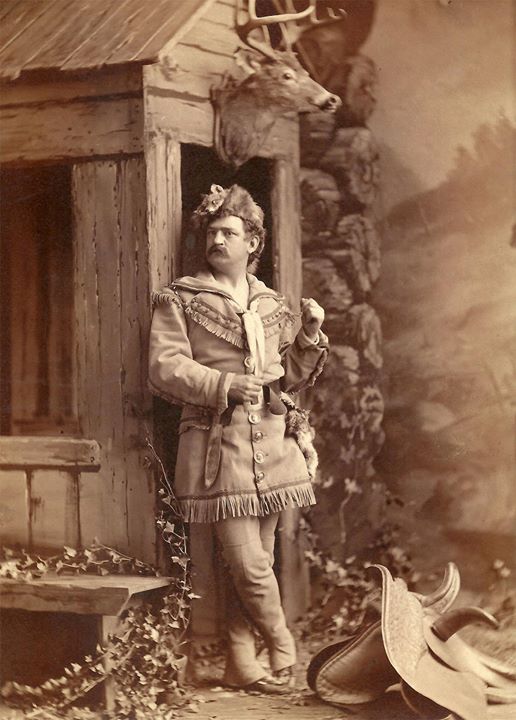
Cabinet photo of Mayo in costume. Collection of the author |
After Crockett's death, his political clout was felt everywhere: In 1840, the Whigs' presidential candidate William Henry Harrison won the presidential election with a "log cabin and hard cider" campaign, wearing a fur cap and pretending to be a frontiersman. The Whigs pushed him as a man of the people and "backwoods democracy," ala their former hero, Crockett. He even became the first presidential candidate to make stump speeches around the country, ala David... But he was no Crockett — after riding into Washington on a white stallion, he caught pneumonia and died. The Whigs died soon after, folding into the Republican Party.
In 1841, David's son, John Wesley, was elected to Congress. Calling on the memory of his father, John Wesley finally passed the long-stifled land bill, completing David's dream. (It became what is now known as the Homestead Act.) John Wesley told Congress: "You have doubtless seen the account of my father's fall at the Alamo in Texas. He is gone from among us, and is no more to be seen in the walks of men, but in his death like Sampson, he slew more of his enemies than in all of his life. Even his most bitter enemies here, I believe, have buried all animosity, and joined the general lamentation over his untimely end."
As the 19th century progressed, the wild frontier became more of a memory than a reality. Farms replaced forests, towns replaced settlements, trains replaced wagon trains, and bragging, slave-holding Southern backwoodsmen were relaced by surrendered ex-Confederates. The national character known as Davy Crockett had to be tamed just like the wilderness he lived in, and underwent his own Reconstruction. Davy became a cleaned-up version of what was being lost — not a "screamer," a buffoon, or a politician (is there a difference?). Davy became nostalgia, representing a sentimental, even romantic figure. In the most famous play of the period, Davy Crockett, he was portrayed as a noble, romantic backwoodsman who was unlucky in love. This Davy has almost no relation to the real man: He is 25 and still living with his mom (the real Crockett was married and working on his third child); he still hunts — but killing the creatures makes him "shudder." Despite the time frame of the play being before the Civil War, and written just a handful of years after the conflict, there are no slaves in the play, let alone African-Americans. Manifest destiny, wars, slaves, and the brags all disappeared, replaced by a simple cabin in the woods, peaceful homesteaders, and humility that even a mother could love.
The star of the play, Frank Mayo, was one of the few native-born American actors who rose to fame in the last half of the nineteenth century. Born on Essex Street in Boston on April 18, 1839 with the birth name of Frank Maguire, he came out to California during the Gold rush, then ended up in the theater. Mayo made his speaking debut at the age of 17, as a waiter in Raising the Wind at the American Theater in San Francisco. Mayo had been employed in various minor capacities at Maguire's Opera House (peddling peanuts, captain of the supers, and the like) when he became star struck. He headed for New York in July of 1865.
Author Frank Hitchcock Murdoch crafted the play from the outset as a nostalgic look back at a frontier that had started disappearing fifty years before. In opposition to the Buffalo Bill-style westerns of the day, and completely different than the farce Lion of the West, this play was a romantic melodrama in a lush, romantic wilderness. Unfortunately he didn't live to see its success. Scribners reported that, "The author of the 'Davy Crockett,' Mr. Frank Hitchcock, had taken the pen-name of Murdoch, borrowing it from his maternal uncle, Mr. James E. Murdoch, the Shakespearian reader and actor. He had written other plays, one of which, called Bohemia, was brought out at the Arch Street Theatre, in Philadelphia, and was so hardly handled by the critics that the author lost faith and hope and died at the early age of thirty." After the disastrous run of Bohemia in Philadelphia, Murdoch wrote to Mayo of the reviews and said, "they have struck home." Within two days, he was dead from "brain fever." So Murdoch never even saw the premiere of Davy Crockett... but J. Brander Matthews wrote in Scribner's, "Perhaps it is well that he did not,—for the play failed dismally when first acted. But the actor had more healthy obstinancy ; he believed firmly in the piece, and he soon found the public beginning to appreciate it."
Davy Crockett was first produced in Rochester, New York, where Mayo was the manager. He played the role of Davy for the first time on September 15, 1872. Mayo had faith in the piece and kept rewriting it himself. He designed it to attract a female audience as much as the male. In his book, Performing the American Frontier, 1870-1906, Roger A. Hall writes the play "was constructed from its inception with romantic, poetic, and artistic aspirations, looking back to a hero whose time had already passed."
The sentiment of those lost good ol' days on the frontier are really driven home by Davy's entrance: after hearing his voice offstage, "as clear as a bell and as sharp as the crack of a rifle," says his friend, Yonk—the song Auld Lang Syne swells in the background as we see Davy himself in buckskins, 25 years old (according to the opening night program), carrying a two-year-old buck over his shoulder — his 42nd of the season, although killing the creatures makes him "shudder." His mother, Dame Crockett, informs him that his childhood sweetheart, Little Nell, has come back from a long stay abroad with her now-deceased father. Little Nell now calls herself by her proper name, Eleanor Vaughn, and she brings with her, her uncle and guardian Major Hector Royston, and her fiancé, Neil Crampton. Davy, of course, distrusts them immediately. He resolves to follow them and see what they're up to, proclaiming his motto, "Be sure you're right, then go ahead!"
They are headed for the estate of Neil's uncle, Oscar Crampton. Davy is quick to sense something is wrong. He decides to run ahead and offer the party the shelter of his hunting hut, since it has started to snow. The decision proves wise, for Neil has been hurt and his blood has attracted wolves. Davy helps them inside the cabin — he has to carry Eleanor, "fainted and freezing," then while Neil sleeps off a fever, Davy warms the cabin by burning the wooden log used for barring the door in the fireplace, and Eleanor reads him Sir Walter Scott's poem of Lochinvar. The scene goes like this:
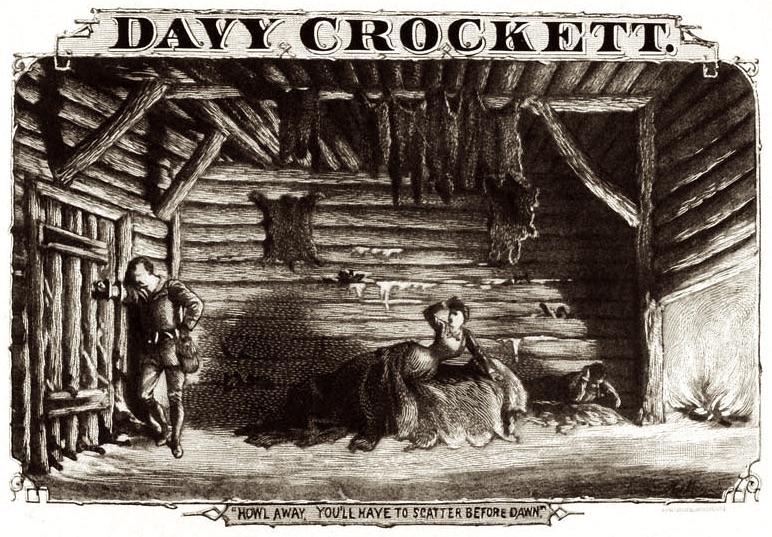
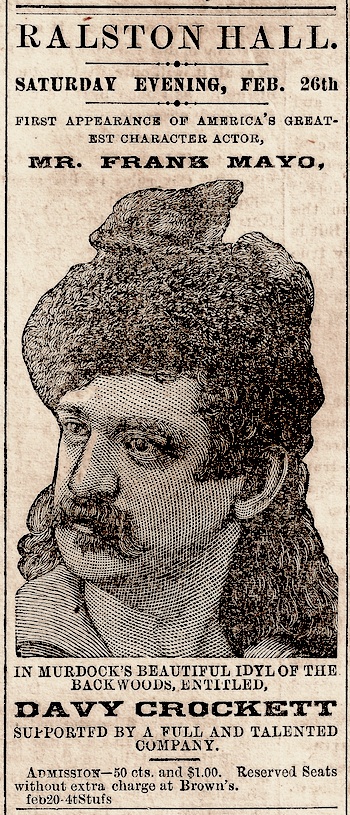
Front-page ad from the Macon Ralston Hall Theater in the "The Macon Telegraph and Messenger" newspaper, dated February 22, 1876. Collection of the author. |
ELEANOR
How good you are, Mr. Crockett!
DAVY
Don't say that, miss, for what I did for you I'd have did for any living soul that came to my door in a storm like that. But you are safe, and I thank the eternal for that.
ELEANOR
How strange we meet again!
DAVY
Yes, 'tis kind of singular.
ELEANOR
Is this your hunting lodge?
DAVY
Yes, this is my crib. This is where I come and bunk when I'm out on a long stretch arter game. Miss, here's something that belongs to you—
(hands her book)
You left it at my mother's house—
ELEANOR
Oh, Marmion!—it's dear Sir Walter's book.
DAVY
Is it? I allowed it was yours.
ELEANOR
Yes—I mean—thank you very much.
DAVY
Oh, you're right welcome—what is that, sermons?—No?—Law, maybe—No? Well I guess I allowed it was, 'cause that's what your lawyer and parson needs.
ELEANOR
Yes, and very good reading it must be. But this is lighter.
DAVY
Is it? Yes, that's right, light—I've seen weightier books than that.
After reading the poem, they discover that they have been tracked to the cabin by a hungry, menacing foe:
DAVY
That's wolves.
ELEANOR
Wolves—!
(Screams)
DAVY
Don't be skeered.
ELEANOR
But—is there no danger?
DAVY
Ain't I here?
ELEANOR
Yes, but they are so dreadfully near.
DAVY
Yes, they tracked you in the snow, and smell blood.
ELEANOR
Blood!
DAVY
Take it easy, girl. This door is built of oak. I built it—and—blazes, the bar's gone!
(Warning curtain)
ELEANOR
Gone!
(Wolves howl all around cabin)
DAVY
Yes, I split it up to warm you and your friend. Rouse him up. The pesky devils is all around the house.
ELEANOR
(Goes to Neil)
Neil—help!
(Wolves throw themselves gainst door. Bark)
DAVY
Quick, there. I can't hold the door agin 'em—
NEIL
I tell you, Uncle, if the girl says no, there's an end of it—
ELEANOR
My God—he is delirious!
DAVY
What!
ELEANOR
'Tis true, nothing can save us!
DAVY
Yes, it can!
ELEANOR
What?
DAVY
The strong arm of a backwoodsman.
(Davy bars door with his arm. The wolves attack the house. Heads seen opening in the hut and under the door)
TABLEAU
The Third Act begins right where the Second Act ended: Crockett is still bolting the door with his arm as Eleanor sleeps, and he utters the immortal, hilrious line: "This is getting kind of monotonous, this business is."
The group is saved, and when the party finally reaches old Crampton's estate, the uncle is revealed as a villain who is blackmailing Royston with forged papers and forcing his nephew to marry. Davy, like young Lochinvar, arrives to rescue his sweetheart. He takes her home and marries her, then destroys the uncle's papers while she gives the old man her inheritance in order to settle his debts.
Critics were as ecstatic as the audiences: The New York Herald critic said on March 10, 1874: "Mr. Frank Mayo as Davy Crockett plays with care and a fidelity to sense that captivates. He allows nothing to tempt him into rant. He is the nearest approach to true American comedy acting that has been yet seen.” The New York Spirit of the Times (August 30, 1879) said, Mayo "gave us a fresh, breezy picture of a new life, and was by turns friendless and vigorous, humorous and tender, always truthful." On March 23, 1875, the New York Herald called the play, "immeasurably the best of the American dramas."
On March 1, 1878, Alamo survivor Susannah Dickinson (then named Hannig, being remarried to a local cabinet maker) attended a performance of the play at Austin Opera House in Texas. Almost exactly 42 years before, she had stared down at Crockett's mutilated corpse in the Alamo, expecting a similar fate for herself. What thoughts must have gone through her head? Did Mayo's character seem related at all to the man she knew? Did she think, "That's funny, Mr. Crockett never mentioned Eleanor, Sal, Yonk, or Omnes?" Was she pleased by the fiction of it, or angry? We'll never know, because she didn't tell anybody what she thought of the play. If it did bother her, she probably felt that she had experienced enough conflict around the Alamo, already, and let the matter drop.
Mayo continued to tour with the play until his death in 1896, having performed the part over 2000 times-including a performance two days before his death. Mayo left behind a wife and three children-including son Edwin, who continued to perform as Crockett after his father's death. The play served as a beloved reminder of the frontier for decades, playing on stage and silent screen, culminating in a big-budget (for the time) film in 1916 that was written by Edwin's son, who inherited both his grandfather's name, Frank, and his profession as well.
3: THE SCREEN. The End of the Frontier; Mexican-American War
What is a politician without a voice? Davy Crockett was the subject of many silent films, but his personality was muted: A good Crockett brag would never fit onto a single title card in a silent movie! So his character had to be refitted as a strong, silent type and he was relegated to action films or simplified retellings of Mayo's melodrama.
Unfortunately, our knowledge of these films comes mostly from contemporary trade magazines and newspapers, as the majority of them are now considered lost. Only a fraction of the American films created during the first four decades of the motion picture still survive in the United States—probably fewer than 20 percent. There are many reasons for this: Films were made quickly, sent into distribution channels and mostly forgotten soon after their first runs. Due to the high cost of film, and the fact that one print could be shown to thousands of people, films prints were produced in small quantities, and prints were often destroyed when they had worn out. Surviving prints were stored haphazardly, if at all. Archiving films was too expensive, so prints were destroyed to save on storage costs. Then with the advent of the talkie era, silent films were considered worthless, and many of the companies that distributed them went out of business. Even for the studios that survived, a silent film's potential as long term sources of revenue was unknown to early movie industry executives. So many films were deliberately destroyed. The importance of archiving silent films wasn't realized until after it was too late, and many classic films were lost forever.
Furthermore, it was dangerous storing silent films. Cellulose nitrate film was used for the majority of films—a highly flammable compound, and many prints were lost in fires, as were many projectionists. Even if the film stock didn't burst into flames, it only had a life of between thirty and eighty years. The decomposition of nitrate film is impossible to stop, and the films all eventually melt into sticky cannisters full of goo in storage. Some films were recycled for their silver content or simply thrown away to save space. So unless new prints were made, what we have today for the most part from silent films are posters, stills, reviews... and a lot of guitar picks.
While most early films featuring the character of Davy Crockett no longer survive, we know the first was filmed in 1909. It was the year that Theodore (Don't call him "Teddy") Roosevelt, the 26th President of the United States, left office after declining to run again. Roosevelt had formed the Boone and Crockett Club, a conservationist organization named in honor of Roosevelt's heroes, Crockett and Daniel Boone, whom the club's founders viewed as ethical hunters and honest men who loved the outdoors and earthly pursuits. Roosevelt had written of Crockett: "He was the most famous rifle-shot in all the United States, and the most successful hunter, so that his skill was a proverb all along the boarder." [Stories of the Great West, by Theodore Roosevelt. The Century co (1909). p.99]


James French, later in his career. He would go on to appear in more than 240 movies between 1909 and 1945. |
The first known film to feature Crockett, released by the New York Motion Picture Co. under the "'Bison' Life Motion Pictures" brand, was called 'Davy' Crockett—In Hearts United. There's no Alamo in this film (a good thing, as it was filmed on a small set in New Jersey). It's a reworking of the Mayo play, starring and written by Charles K. French (who was still paid ten bucks for the story). The filmmakers borrowed a wolf skin rug from a taxidermist for the scene where Davy and Eleanor are trapped in the cabin by wolves. Beyond French, it starred Evelyn Graham, Charles Bauman, Charles W. Travis and Charles Inslee. The film was directed by Fred Balshofer and was commercially released on June 4, 1909 in the United States.
Organized by Balshofer, Adam Kessel, and Charles O. Baumann, the New York Motion Picture Company had released its first film, Disinherited Son's Loyalty, just a month earlier on 21 May 1909, also under the Bison brand. Like most early film studios, NYMP filmed its western subjects in New Jersey. Balshofer, the company's official director and cameraman, became dissatisfied with the look of these films and determined that the Bison brand needed to be filmed with real western backdrops. Later in 1909, he and a troupe of actors traveled to Los Angeles and established a base of operations in Edendale.
The plot of the film, according to Moving Picture World (May 8, 1909, p. 609), opens with a young beauty named Anna and her gentrified fiancé Blake (replacing the characters of Eleanor and Neil in the play), approaching the Crockett home with a broken saddle girth, asking for help. Rough-hewn Davy mends the saddle as Anna reads him the poem of Lochnivar. They fall in love (no time for backstory or character development in a one-reeler). Then Anna and Blake leave the cabin but get lost in the stormy woods, where they are chased by wolves, but frontier-savvy Davy rescues them. Later, Anna is about to be married to Blake on her father's front lawn when Davy rides up on horseback ala Lochnivar, scoops Anna up, and whisks her away—sort of an early 20th Century, backwoods version of The Graduate. They ride to the country parson's house, marries Anna, takes her home to his own cabin, and says, "Mother, I have brought you a daughter."
The film was a box office hit, according to Terry Ramsaye's book, A Million and One Nights: A History of the Motion Picture Through 1925 (New York: Simon & Schuster Inc., 1926, p. 491). Unfortunately the film is now lost. French was the father of B-Western regular Ted French (1899-1978) and grandfather of Little House on the Prairie star Victor French (1934-1989).
What's interesting about the Mayo play and the filmed reinterpretations is that Davy himself is not a legendary hero—he hears the story of a legendary hero and aspires to become heroic, finding the courage and self-confidence to achieve his dream at the end of the story. He has virtually nothing in common with the real man except a name and a humble background.
The real Crockett was disappearing. Like other legendary figures: Mike Fink, Robin Hood, King Arthur (and yes, Lochinvar), he was becoming myth with no relation to the actual person—at least it looked that way, until the movies rediscovered the historical figure. One man started this rediscovery. He was a great stage actor, a writer and soon to be a director. His name was Hobart Bosworth, and he starred in the next Crockett film...
"This film proves to be strongly effective in all three necessary particulars—acting, scenery and story. The plot departs from the old stage version, but it is in the direction of consistency."
—"New York Dramatic Mirror" review of Selig's "Davy Crockett" (4/30/10, p.21) |
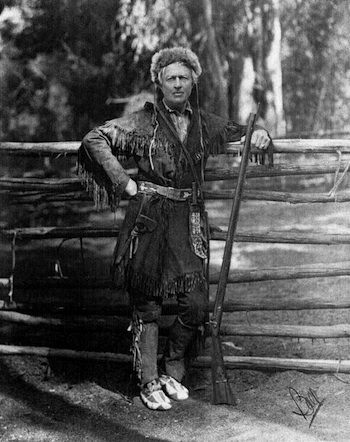
Hobart Bosworth in his Crockett garb. Bosworth is holding a gun that supposedly once belonged to the real Crockett. |
Davy Crockett in Hearts United must have been a big hit, because just a year later the Selig Polyscope Company produced a remake for their theaters, simply called Davy Crockett. Selig wanted a short (1000-foot) version of the Murdoch-Mayo play, but Hobart Bosworth, who wrote the scenario as well as starred as Davy, made some subtle but important changes.
A more perfect man could not have been chosen to fill out the story than Bosworth, because discovering the real Crockett was his life-long obsession... and it can all be traced back to the simple purchase of an antique rifle. And like Lochinvar, Hobart swooped in and saved the historical Crockett from cinematic oblivion.
Bosworth was a Broadway star who was forced to give up the stage due to respiratory illness, when he lost seventy pounds in ten weeks, as well as his voice. Bosworth moved west, and was forced to remain in the warm climate to prevent a relapse. But it was there that he found the only job an actor with a compromised voice could work in: silent films. In 1908, he was contracted to make a motion picture by the Selig Polyscope Company. Shooting was to be done in the outdoors, and he did not have to speak at all. Bosworth once said, "I believe, after all, that it is the motion pictures that have saved my life. How could I have lived on and on, without being able to carry out any of my cherished ambitions? What would my life have meant? Here, in pictures, I am realizing my biggest hopes."⁴
Although Bosworth based the story on the fictional Murdoch/Mayo play, he inserted authentic historical events and characters, using Crockett's own Narrative as the main source. The female lead in the Mayo play, "Eleanor," daughter of an aristocrat, was replaced by "Mary"—modeled after David Crockett's first wife, Mary (Polly) Finley, the daughter of a mountain trapper. In this new twist to the play, Davy courts Mary but her parents, "particularly the mother, are favorable to another suitor," mirroring Mrs. Finley favoring another suitor in the autobiography. Just like in Crockett's autobiography, Davy romances his sweetheart at a frontier frolic. He then "sees her home," but walking through the woods, they are menaced by a pack of wolves. (In the Narrative, Crockett was on a wolf hunt when he found Polly lost in the woods, and they spend the night on the porch of a cabin).
The film then reverts to the events of the fictional play: once at the deserted cabin, the wolves attack, trying to break through the door like in the play. Davy stands all night barring the door with his arm, until they are rescued that morning. David nurses his swollen arm as Mary is taken home, where she is "upbraided by her mother for her love for Davy." The film then jumps to the scene in the play where Mary is forced into marriage with her mother's choice of suitor. Davy rides up just as the nuptial services are ready, "lifts her up into his saddle and gallops away with her in true romantic fashion, emulating Lochinvar's ride." (Even though he hasn't read the poem in this version.) Mary is spirited off, "happy in her thought of wedding the man she loves." (The Moving Picture World, 4/23/1910, p. 657).
Still, the most important connection to the real Crockett was that Bosworth used a special rifle in the film: Long, sleek and beautiful, but with notches and other battle scars noticeable in the wooden stock... and, according to Bosworth, it was the actual gun that David Crockett had used at the Alamo. Bosworth's connection to the rifle began in 1903, when he was touring in a play. While shopping during his off-hours in Joplin, Missouri, he found a beautiful antique 5'-long, twenty-pound rifle in the possession of an old jeweler, who claimed it had been Crockett's rifle at the Alamo. The jeweler said he had purchased it from an old Mexican soldier who had pulled it from the dead Crockett's hands on the Alamo grounds. Was it really Crockett's? Who knows, but it certainly spurred Bosworth's interest in Crockett and infused his work on the film, which according to critics of the day was a wonderful job (it's a lost film, so that's all we have to go by).
Out of Selig Polyscope's hundreds of movies, only a few copies and scattered photographic elements of their films are known to survive. Unfortunately, Davy Crockett is not one of the surviving films. All we have today are contemporary accounts.
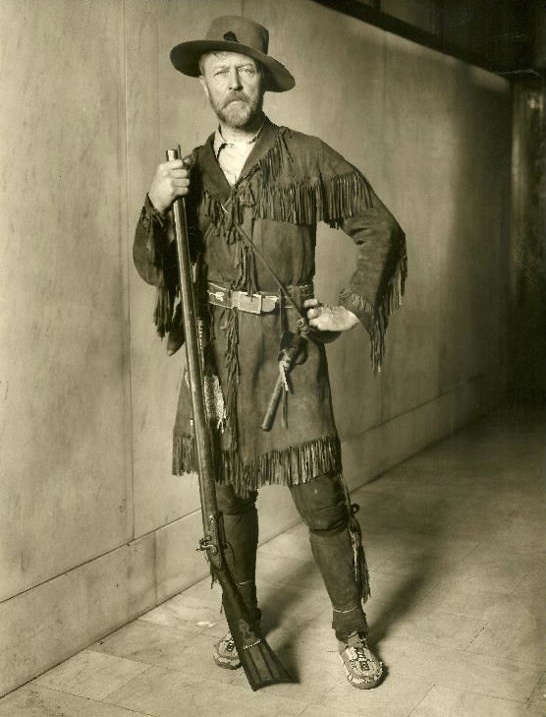
Bosworth wearing his Crockett hunting garb and rifle as "Old General Sutter" at a Rotary Club Luncheon in 1922 to promote the "Days of Gold" celebration in Sacramento. "The gun is a muzzle loading rifle that carries a 32 caliber ball and is authenticated by the U.S. Government as being the great Davy Crockett's gun, the one used in the incident that every American school boy knows when the coon in the tree said: 'Don't shoot Davy, I'll come down.'" (Published in the "San Francisco Chronicle," Tuesday evening, May 23, 1922) |
David Crockett had always stood bravely against formidable adversaries—and while Creeks, Andy Jackson, and Santa Anna were worthy foes, he now faced a brand new threat: film critics. Fortunately, they were kind to him in this film:
"In this film, a reproduction of striking scenes in the life of a historical character, the Selig players have accomplished something worth while. ... A historic character adequately presented is well worth the consideration of every serious person. Selig, in this presentation, may well claim the right to feel proud of what a motion picture can be made to say," said The Moving Picture World review (4/23/1910, p. 737).
Variety said: "Davy Crockett, according to the Selig 'story man,' falls in love with a frontier belle. The pioneer has a rival and several scenes are shown in which they display their bitterness toward each other. Both attend a corn-husking and after a tiff with Davy's rival the girl agrees to be escorted home by the pathfinder. Pretty winter scenes are shown as the couple journey to the girl's home. The scene shifts and a pack of dogs, looking wonderfully like wolves, are seen racing madly across the snow, presumably in chase of Davy and his sweetheart. Davy hears them approach and the pair make for a deserted hut, getting under its welcome shelter just in time. The "wolves" spring against the door and try to force their way in, but Davy is there with the brawny arm. He makes a bar of his arm and through the cold, long night holds the door shut against the ravenous pack. A popular picture, which was probably the base of this story, shows Davy in this pose. In the morning the girl's mother rouses the settlers with the news that daughter has not returned. Frontiersmen track the pair and finally release them. All is not yet over. The girl is forced into marriage with Davy's rival. Everything has been prepared for the ceremony. Even the minister is present. The latter personage is about to tie the knot (strangely enough in the open air during what appears to be a severe winter) when Davy gallops up on horseback and, snatching the bride-to-be carries her off while his friends keep the rest of the wedding guests from interfering. The wolf incident is admirably worked out and the reel is a capitol scenic series. RUSH.—(April 30, 1919, p. 16.)
All of this critical praise would naturally lead to a sequel, so Bosworth wrote a scenario for a sequel that stayed truer to the historical character. It begins: "Davy Crockett: Frontiersman, Patriot, Truest Type of the Men Who Made America What It Is."
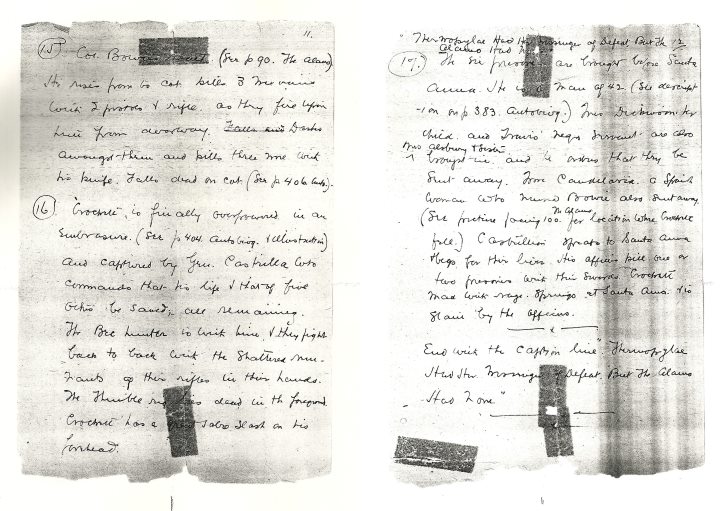
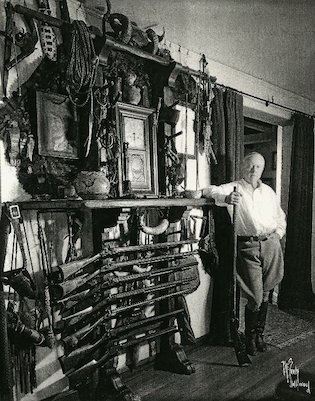
On March 4, 1928, Bosworth appeared in the 'L.A. Times' with his gun collection. He holds the Crockett rifle, and painted the portrait of Davy that hangs on the wall... Caption: "Hobart Bosworth's collection of old rifles is famous. The one in his hand belonged to Davy Crockett, and was found beside his body in the Alamo.—Photo by (Walter Fredrick) Seely." |
Unlike the fictional romantic melodrama that the character of Davy Crockett had been consigned to for forty years onstage and in film, this scenario, titled Davy Crockett, 2nd Series and written by Bosworth in longhand, is based on a real man and is framed by war. The story begins with, "An Incident in the Battle of Taladega, Dec. 7, 1813," and ends with the battle of the Alamo. In fact, the final scene would have been the first filmed dramatization of Crockett being captured and executed:
(Page 11) Crockett is finally overpowered in an embrasure [see p.404 Autobiography and illustration) and captured by General Castrilla (sic) who commands that his life and that of five others be saved, all remaining. The Bee hunter is with him and they fight back to back with the shattered remnants of their rifles in their hands. Then Thimblerig lies dead in the foreground. Crockett has a great saber slash on his forehead.
(Page 12) The six prisoners are brought before Santa Anna. He is a man of 42 (see description on p. 383 Autobiography) Mrs. (Dickinson) her child and Travis's Negro servant are (inserted: also Mrs. Alsbury and sister) brought in and he argues that they be sent away. Mdm. Candaleria, a Spanish woman who (nursed?) Bowie also sent away. (See ___ ___ for location where Crockett fell) Castrillon (speaks?) to Santa Anna begs for their lives. His officers kill one or two prisoners with their swords. Crockett mad with rage, springs at Santa Anna and is slain by the officers.
—————x—————
End with caption line: "Thermopylae Had Her Messenger of Defeat. But The Alamo Had None."
But plans for this sequel were interrupted on October 27, 1911, by more tragedy when studio caretaker Frank Minematsu went berserk and shot and killed Davy Crockett's director, Francis Boggs in the Selig offices. In the struggle to retrieve the gun, Selig himself was shot and wounded in the arm. Minematsu whom the Los Angeles Times dubbed "The Gentleman Janitor," claimed he shot Boggs because he was a "bad man." — it was the first celebrity murder scandal. On December 13, 1915, Bosworth reminisced about Boggs to the Woodland Daily Democrat, saying, "Francis Boggs was a great man in all ways. He had breadth, the big view, splendid initiative and great business capacity that was developing into great executive ability, and too little credit is given him as a pioneer in our new art. Time and time again I have seen credit given to this man and to that for inventions such as dissolves, close-ups, silhouettes and many other things which Mr. Boggs used before they appeared elsewhere. He had difficulty at first. The Chicago office objected to these innovations. Mr. Boggs had to make over many scenes because 'Chicago' declared they were 'too close to the camera.'" Minematsu was sentenced to life in prison and tended the gardens of San Quentin, even refusing parole back to Japan in order to care for the plants until his death. (July 28, 1937 Ukiah Repubican Press)
Bosworth would spend the rest of his life promoting and attempting to prove the legitimacy of the "Crockett rifle." He told the Bosworth Bulletin in 1932 that the rifle "has been authenticated to the satisfaction of the War Department as Davy Crockett's famous 'Betsy.' Not having been there personally at the Battle of the Alamo, I can't say definitely. But it is a splendid specimen of the drop stock, converted flintlock rifle of about 1820." Bosworth donated his incredible rifle collection to the Southwest Museum of Los Angeles in 1929... everything but the Crockett rifle, anyway. It's still in the family over a hundred years after Bosworth purchased it, and they're still trying to prove its provenance. Me? I'd just be happy to find the film!

The Immortal Alamo was the first Alamo movie, shot in San Antonio (although the actual Alamo was not used in the film), and released in 1911. It's lost now, so the only way we know Crockett was even in it is that he's mentioned in an ad for the film. At the time of this film, Mexican/American relations were foundering. With the outbreak of revolution in northern Mexico in 1910, federal authorities and officials of the state of Texas feared that the violence and disorder might spill over into the Rio Grande valley. The Mexican and Mexican-American populations residing in the Valley far outnumbered the Anglo population. Many Valley residents either had relatives living in areas of Mexico affected by revolutionary activity or aided the various revolutionary factions in Mexico. The revolution caused an influx of political refugees and illegal immigrants into the border region, politicizing the Valley population and disturbing the traditional politics of the region. Some radical elements saw the Mexican Revolution as an opportunity to bring about drastic political and economic changes in South Texas.
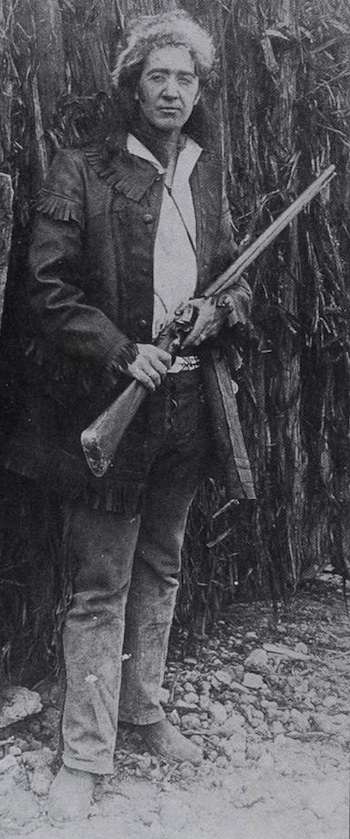
Ray Myers in "The Siege and Fall of the Alamo" from 1914. It was the only Alamo film to ever get made inside the real Alamo (but seeing as most of the Alamo fort was destroyed by then — except for the chapel — it was probably the least accurate representation of the battle ever made. |
The Siege and Fall of the Alamo (1914) is the only known Alamo film that was actually filmed at the Alamo. The entire production was shot on location near San Antonio, Texas. The film was first shown at the Royal Theater in San Antonio, Texas, on 1 June 1914. "The greatest day's business in the history of the Royal Theater is what the management reports for yesterday. It being the first day of the 'Siege and Fall of the Alamo,' the made-in-San-Antonio picture play of that great historical event. The morning and afternoon shows drew tremendous houses, but at night they were forced to stop the sale of tickets on two different occasions. The picture is a splendid piece of photography, clear in every detail, and the acting is perfect. The leading characters, Travis, Bowie and Crockett, being excellently portrayed, and the make-up of the artists playing the parts perfect. The play seems to please the patrons and is pronounced by historians as a great reproduction. It will be repeated again today and tomorrow."
The idea of a battling Mexicans must have been popular with audiences at the time becauae relations between the US and Mexico had reached another low. Mexican President Francisco I. Madero was assassinated in 1913 after a counter-revolutionary coup called the Ten Tragic Days, and the United States rejected the legitimacy of General José Victoriano Huerta Márquez's regime, which U.S. President Wilson called a "government of butchers" and demanded in Mexico hold democratic elections. After U.S. navy personnel were arrested in the port of Tampico by Huerta's soldiers, the U.S. seized Veracruz, resulting in the death of 170 Mexican soldiers and an unknown number of Mexican civilians. Huerta was forced to resign and flee the country in 1914, after 17 months as president. While attempting to intrigue with German spies in the United States during World War I, Huerta was arrested in 1915 and died in U.S. custody.
Looking at the 100 year-old scenario, below (words than have disappeared from holes or tears are in parentheses), it appears that there was no attempt to build a reproduction of the fort-the defenders just sealed themselves in the chapel and created a stockade in back of the building.
"This motion picture shows the collection of Texas forces at the Alamo. The approach of the Mexican forces and the demand by Santa Anna to surrender the guns owned and held by the citizens of Gonzalez. The refusal of the Texans. Preliminary fight in which the Texans are victorious. The surrender and abandonment of the Alamo by the Mexicans. The occupation of the Alamo by the Texans. Approach of Santa Anna and his army and demand by him for an unconditional surrender of the Alamo. Refusal by the Texans. Fight for possession of the fort. Fight and protracted struggle; the fort finally (conquered(?) by the Mexicans I consequence of the killing of all the Texans."
THE SIEGE AND FALL OF THE ALAMO; STORY OF THE HEROISM OF TRAVIS, CROCKETT, BOWIE AND BONHAM AND THEIR GARRISON, AND THE BATTLE OF SAN JACINTO, IN MOTION PICTURES.
SYNOPSIS
A picket guard reports to Colonel Travis, commander of the Bexar garrison, that the Mexican general, Almonte, with troups (sic) is approaching the town. Travis hurriedly sends the report of the picket to Colonels Crockett and Bowie and Bonham, who are in command of small details, stationed in different parts of the village. The details and [????] their commanders march toward the Alamo mission building, all coming together in a street leading to the building. Several of the party, seeing some cattle grazing on the commons, leave the crowd and go out, herding the cattle in front of the marching men. Driving the cattle into the stockade, or enclosure, in the rear of the building, about 147, strong, enter the mission and take up positions in the windows and doors of the building; all armed with rifles and knives or sabers;
The Mexican army, under the command of Gen. Almonte, arrives and pitches camp near a stream several hundred yards of(f) the mission building. A Mexican courier from the Almonte army arrives at the Alamo building with a demand for the surrender of the garrison; this demand is refused; the Mexican returns to his army, and a small party of Mexican soldiers makes a charge on the building. They are repulsed. Almonte orders his men to place a cannon near the Alamo building; they make effort to carry into effect this order, but are driven away by the shots from building. Other attempts are made to place the cannon, but all fail. Mexicans abandon the ground and retire to the main army.
As night comes on the Mexicans in small parties make charges on the building but are repulsed by shots from the garrison of Texans. When daylight comes the Texans discover that the Mexicans have succeeded in placing the cannon on the disputed ground.
About ten o'clock in the morning, the garrison in the building hear cheering in the Mexican army. The Texans rush to their posts in the building, guns in hands, and, looking out towards the southwest, they see a marching army; cheering continues in the Mexican camp until army seen approaching arrives, then loud shouts are heard by the garrison; Santa Anna, commander-in-chief of the Mexican army, with re-inforcements (sic) has arrived. A council of war is held in the Mexican army, officers attending; a courier is dispatched to the Alamo with demand for surrender; the courier returns, and a cannon shot is the answer of the Texans in the garrison. Charges are made by the Mexicans against the building; they are repulsed; they charge again, and are again repulsed; ladders are secured and Mexicans in front of army are ordered to scale walls of building. A fusillade of shots come from the building; Mexicans fall from ladders; others take their places. Another attempt is made; Mexicans enter the building through windows, shooting and hand-to-hand fighting takes place. Bowie, one of the commanders of the garrison, is shot by Mexicans as he lay upon a cot. He shoots several Mexicans; they fall near the cot. Mexicans swarm through the building, shooting Texans. Crockett, with several men are fighting Mexicans in stockade; several Mexicans fall; Crockett and his men fall. Bodies of Texans are scattered about the building and enclosure.
Cast
Colonel William B. Travis, Commander of Bexar garrison, San Antonio.
Lt. Colonel David Crockett, second in command of garrison.
Lt. Colonel James Bowie, third in command of garrison.
Lt. Colonel Bonham, fourth in command of garrison.
Mexican genrals (sic), Santa Anna, Almonte, Cos.
Mexican soldiers.
Texan soldiers
-@-@-@-@-@-@-@-@
Scenarie.
1. Bexar (San Antonio) garrison; small village, with Mexican huts, Alamo mission building.
2. Mexican army marching; Texans in garrison, about the streets, rushing here and there, very much excited; details of Texans seen coming together; cattle driven in front of marching men; men enter Alamo mission building; cattle in stockade.
3. Mexican soldier enters building with note; hands to Col. Travis, who shakes his hand, and men about him cheer. All armed go to windows and peer out; shoot their rifles.
4. Col. Travis draws line in room on floor; men cross the line; Col. Bowie, sick on cot is moved across the line, by those men.
5. Mexican soldiers shooting, some carrying ladders rush against walls of building, Alamo, fall back, rush again, and fall back. Ladders placed against walls. Mexicans enter building, shooting pistols and rifles. Man on the cot is shot.
6. Officers of Mexican army arrive; walk about bodies. Retire, and Mexican army [load Texans onto] carts carry bodies to prairie; [set] afire with brush. Mexican general at head of army marches away.
7. General Houston with army of Texas, camped on prairie; two men ride away from army with axes; return waving hats and shouting. Houston rides in front of army and makes a talk. Army, 750 strong, moves forward (sic). Guns are fired, met Mexicans; Mexicans shoot, run, fall down, and plead for lives.
8. Santa Anna is captured in high weeds by three Texas soldiers [??? ????? ????] one of the troopers and all return to General Houston's camp; Houston is reclining under tree as three troopers with prisoner come up. Mexican prisoners shout and wave their hands. Santa Anna dismounts with the troopers and is taken to Gen. Houston. They talk, papers are signed, and Santa Anna is waved aside by Houston.
9. Texas soldiers are feasting on captured supplies amid great rejoicing of soldiers.
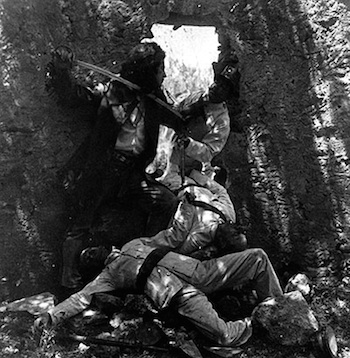
"Crockett, with several men are fighting Mexicans in stockade; several Mexicans fall; Crockett and his men fall. Bodies of Texans are scattered about the building and enclosure." |
Of course, the chapel itself had even changed in the 70 years since the battle. The distinctive central hump on the Alamo's façade makes it one of the most recognized buildings in the world. But when the Alamo defenders died there, the hump didn't exist. It was added in 1850, after the U.S. Army took over the compound and renovated the church (not to make it into a shrine, but instead, a warehouse. The army isn't very sentimental).
Crockett was played William Raymond August "Ray" Myers, who was born in Hot Springs, Arkansas on June 21, 1889. According to "Who' Who In Film," he got his start in musical comedy onstage, beginning in 1906. "After spending two years in retirement on his ranch in Arizona" he joined the Kalem Company in 1910, playing "heavies." After that he wrote and appeared in War On the Plains for the New York Motion Picture company, assisted by Thomas Ince. He reamained in the Bison fold for two years until signing with Universal, where he acted and served as a co-director with Francis Ford under the "Nestor" brand. Myers appeared in 43 films between 1912 and 1924, and also directed five films between 1910 and 1915, including his sojourn in Texas to write, star and direct this film with the financing of the State. Between film roles (and not "in retirement on his ranch in Arizona"), he supported his wife and three kids with jobs as a car dealer and as a dock policeman on Terminal Island during World War II. Originally released on the 1st of June in 1914, The Siege and Fall of the Alamo is now considered a lost film. Except for four production stills and a small review buried in the Library of Congress and the scenario cited above, that is all that is known for certain about this lost independent production. Myers died in Los Angeles, California on November 4, 1956.
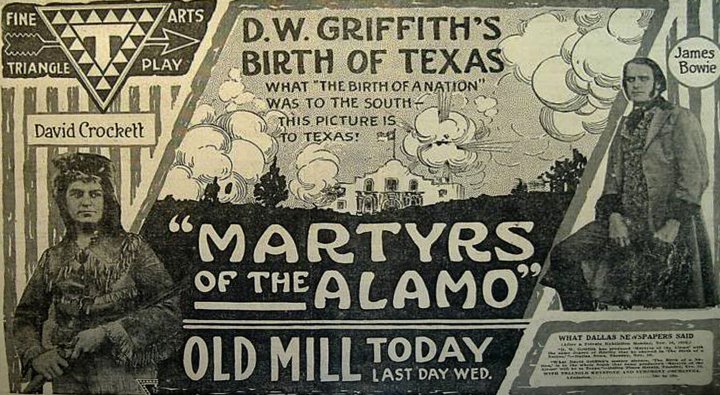
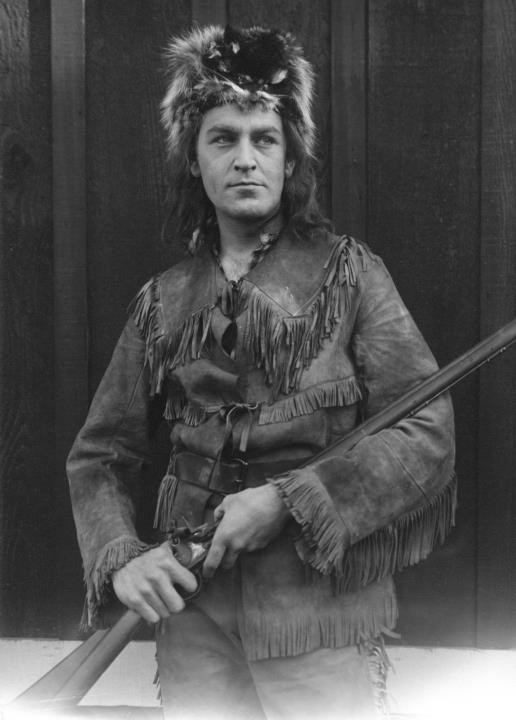
Image Source: Wisconsin Center for Film and Theater Research |
The Martyrs of the Alamo, aka The Birth of Texas was released in 1915 by Triangle Films. The men responsible for Davy Crockett In Hearts United, Adam Kessel Jr. and Charles Bauman, set up Triangle Films with Harvey Aitken in 1915. The studio released the films of D.W. Griffith's Fine Arts Company, as well as Thomas H. Ince's Kay Bee Productions and Mack Sennett's Keystone Comedies, thus creating the three corners of the Triangle.
The Martyrs of the Alamo was produced by D. W. Griffith right after he finished the infamous The Birth of a Nation—and unfortunately it was just as racist. In fact, Allan "A.D." Sears was promoted to the co-star role of Crockett after playing an uncredited Klansman in Griffith's film. African-American stereotypes are still on display in this film — for instance, Jim Bowie's slave is actually a white actor in minstrel show makeup, who is always seen sitting at Bowie's feet. (The slave was rumored to be played by Douglas Fairbanks, who had signed with Triangle that year.) However, most of the racism is directed toward Mexicans.
Director William Christy Cabanne was an officer in the marines when he was hired by Griffith as a military consultant for the film The Unchanging Sea in 1910. He then found work as an actor before being hired by Griffith as an assistant. Cabanne directed a number of shorts and features in the years leading up to Martyrs, including a job shooting documentary footage and dramatizations of the famous Mexican bandit and rebel, Pancho Villa on location during the Mexican Revolution. This became a silent biographical action-drama film starring Pancho Villa as himself, called The Life of General Villa in 1914. The movie incorporated both staged scenes and authentic live footage from real battles. The film was also produced by D.W. Griffith and featured future director Raoul Walsh as the younger version of Villa. Walsh wrote extensively about the experience in his autobiography Each Man in His Time, describing how the peasants would use rocks to knock the teeth out of corpses from firing squads in order to harvest the gold fillings, which had the projectionists vomiting in the screening room back in Los Angeles. The film was successful enough to give Cabanne his next directing assignment, Martyrs of the Alamo, and Villa's influence is visible in the dress of the caricatured Mexicans in San Antonio.
Adding to this was the "Plan of San Diego," a revolutionary manifesto supposedly written and signed at the South Texas town of San Diego on January 6, 1915. The plan, actually drafted in a jail in Monterrey, Nuevo León, provided for the formation of a "Liberating Army of Races and Peoples," to be made up of Mexican Americans, African Americans, and Japanese, to "free" the states of Texas, New Mexico, Arizona, California, and Colorado from Anglo-Texans. The liberated states would be organized into an independent republic, which might later seek annexation to Mexico. There would be a no-quarter race war, with summary execution of all white males over the age of sixteen. The revolution was to begin on February 20, 1915.
Federal and state officials found a copy of the plan when local authorities in McAllen, Texas, arrested Basilio Ramos, Jr., one of the leaders of the plot, on January 24, 1915. In July, a series of raids in the lower Rio Grande valley were connected with the Plan of San Diego. These raids were led by two adherents of Venustiano Carranza, revolutionary general, and Aniceto Pizaña and Luis De la Rosa, residents of South Texas. The bands used the guerilla tactics of disrupting transportation and communication in the border area and killing Anglos.
In response, the United States Army moved reinforcements into the area. Raids originated on both sides of the Rio Grande, eventually assuming a pattern of guerilla warfare. During this revolutionary chaos, Mexican bandits raided the Southwestern U.S., which resulted in a lot of resentment against Mexican-Americans, and it spilled over heavily into this film.
In The Martyrs of the Alamo Davy is played as a genial white trash bad-ass, saving the white women from the evil Mexicans—in this film, the cause of the Texas revolution is Mexican soldiers flirting with a white woman. One title cards reads: "Under the dictator's rule the honor and life of American womanhood was held in contempt."
Reviewers ate it up, and Sears stole the film: "The insolence of the soldiery toward the American women and men is brought out early and Davy Crockett in his masterful devil-may-care conduct is made to live again — to actually live, it seems, on the walls of the Alamo. This will appear to be doubly true to San Antonians familiar every day of their existence with the old courtyard walls of adobe which have been reproduced with such verisimilitude. For Crockett and the others are shown often on the narrow streets, under the arches, by the ornate entrance of the ancient church, the outlines of which are so deeply graven on the brains of San Antonians." ("Birth of Texas" Makes Crockett Seem Here Again, published in the San Antonio Express, Wednesday, January 5, 1916.)
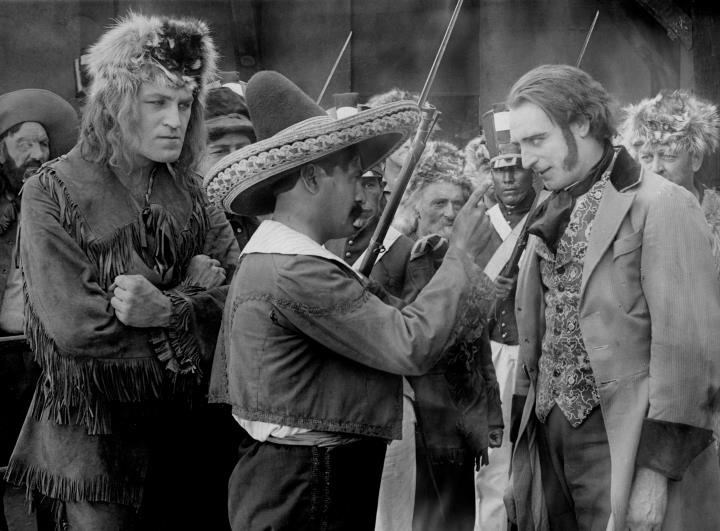
A Dec 26 1915 ad proclaimed: "3000 people and 500 horses in the thrilling battle scenes. A picture that will stir the blood of every true Texan." It definitely confused the true Texans, because the Alamo films were piling up on each other. January 4, 1916 ad: "This is not 'The Fall of the Alamo' that was made in San Antonio." Sub-heading: "Not 'Fall of the Alamo.'" The film was showing 4 times a day at the Grand in San Antonio, starting at 10am, but potential customers apparently thought The Siege and Fall of the Alamo was still running: “Owing to some confusion about the film 'The Birth of Texas' or 'Martyrs of the Alamo' Sidney Weis, manager of the Grand...states that the picture was made less than three months ago in California by D.W. Griffith...and was released to theatres on November 21. For some reason, the public has confused the feature with 'The Fall of the Alamo' which was made in this city. The story of 'The Birth of Texas' is different, in fact, there is hardly a scene like the scenes in 'The Fall of the Alamo!' Manager Weis also announces that the Daughters of the Republic of Texas will be his guests Tuesday evening and he has arranged to have special seats reserved for them."
The film was re-released in 1921 as The Birth of Texas, and Mexican-Americann audiences across the Southwest boycotted the film. But it did play in the Glendale Theater in Southern California for a time in 1923, and made a large impression (both good and bad) on a young high school student named Marion Robert Morrison-one day to be known by a new stage name: John Wayne.
Fortunately (or unfortunately, if you're easily offended), this film still survives. In the 1970's, a 35mm print was found by film historian Tony Rimmer in the basement of a house in Austin, Texas. "When I crawled in and saw those cans sitting there, it was as if there was a halo over them," he told the San Antonio Express News in 1977. It was more pristine (and longer) version of the film than the only other known print in existence, housed in Washington DC by the American Film Institute. This 35mm print had been used as a "roadshow" film in the 20's and 30's by a man named Elmo Hagen, an Austin theater manager. He had hauled the film around Texas in the 1930's, selling it as an educational tool to schools (!). Usually, it went over well, but he remembered one instance in Baytown, Texas, in which the predominantly Mexican audience walked out en masse. The Austin print also showed some use of tinting. Battle scenes were tinted red, evenings a cold blue and romantic scenes a sepia—but it was impossible to tell if this had been done by Griffith or by a duping technician sometime after the film's release. The combined prints now exist in the Library of Congress film archive.
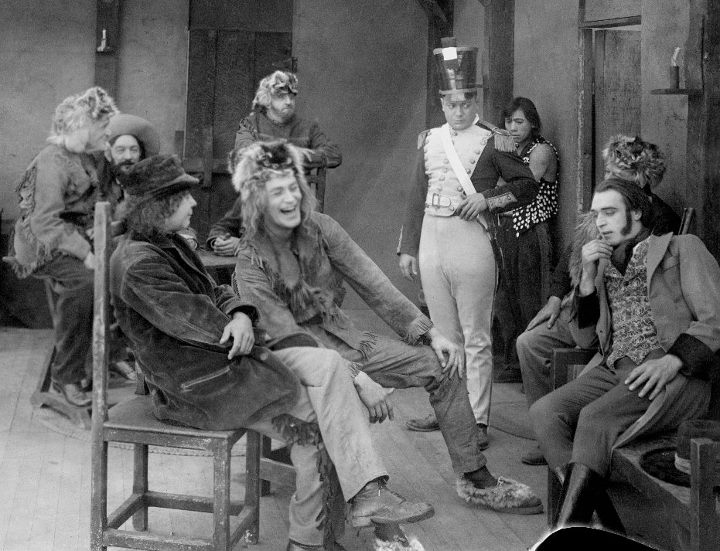
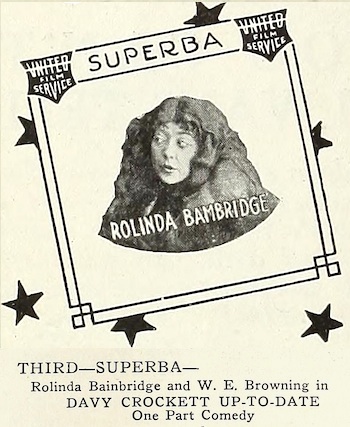
About the only image we have of "Davy Crockett Up-To-Date," an ad featuring Rolinda Bambridge (or is it 'Bainbridge'? Take your pick). Source: 'Motion Picture News,' Apr-Jul 1915 |
As a respite from the ongoing troubles with Mexico and the war looming overseas, on 18 May 1915 the Murdoch/Mayo play was revived once again on film — this time as a slapstick farce — in Davy Crockett Up-To-Date. It was produced by the Superba Film Company and released by United Film Service. (The film is now considered lost.)
In this version, the character of Eleanor is now a single, unnamed "blonde young lady" (played by Rolinda Bainbridge) who is walking alone in the woods, when she is "surprised and kissed by one of her red-skinned lovers." She becomes "so indignant that she stops to thrash him." The rest of the offender's marauding Indian band attempt to scalp her, but end up with only a forelock of her hair as she escapes. She is then rescued by Davy (W.E. Browning), who leads her to his cabin. The Indians lay siege to the house, but are fought off with her hardtack biscuits in lieu of bullets. (Moving Picture World, May 22, 1915, p. 1261, 1336)
This film fit neatly into the mood of the country, which was watching a horrific war develop overseas: In January of 1915, the Royal Navy battleship HMS Formidable was sunk off Lyme Regis, Dorset, England, by an Imperial German Navy U-boat, with the loss of 547 crew, then German Zeppelins bombed the coastal towns of Great Yarmouth and King's Lynn in England. People were in no mood to watch bloody battles onscreen. As reports of the brutal fighting and massive loss of life came in from overseas, they preferred nostalgic, insular light entertainment that stayed within the borders of the country. This inspired one last (straight) re-telling of the Mayo-Murdoch play onscreen:
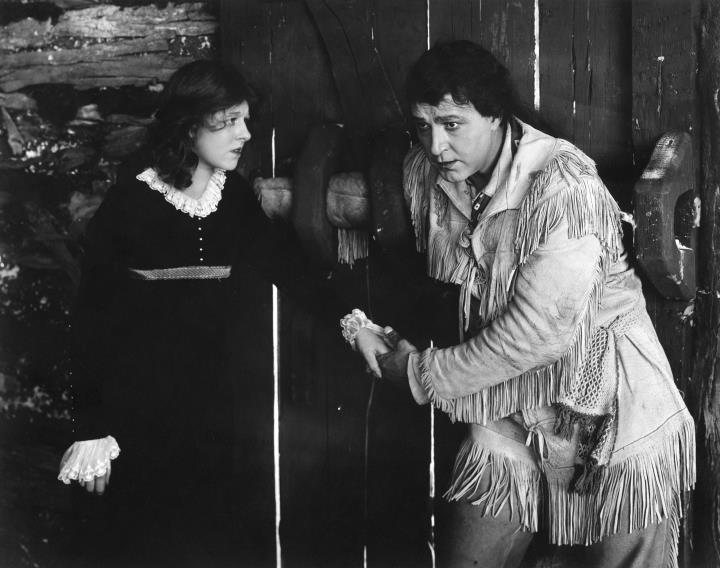
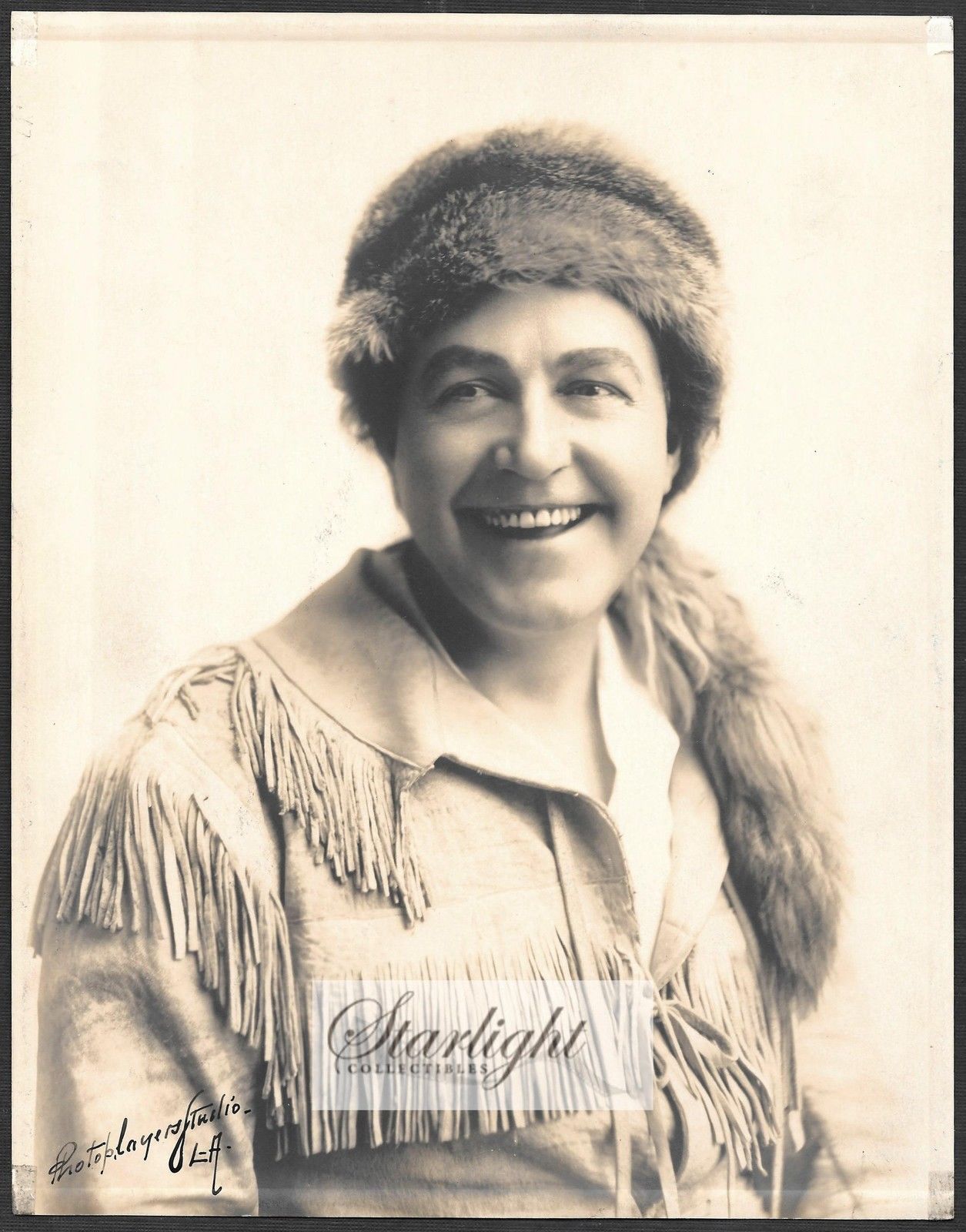
Collection of the author |
The next film—now lost—was reportedly one of the most beautiful of the silent era. Davy Crockett was the last film to be based on the Mayo play, and starred heartthrob Dustin Farnum. He was 42 years old, but was a pretty successful matinee idol, so nobody seemed to mind watching a hero in his forties who was still living with his mother. A notoriously conceited actor, Farnum once bragged to writer Oliver Hereford, "I had the audience glued to their seats." Hereford responded, "How clever of you to think to do that."
This was to be the last filmed version of the famous play (at least to date), and this time it was a full-scale film interpretation (this time 5 reels, according to the Library of Congress), filmed at Big Bear Lake in California. Davy (Dustin Farnum) once again saves the girl (played by Farnum's third wife, Winifred Kingston) by barring the door against wolves with his own arm. "Dame" Crockett finally makes an appearance, as well, played by Lydia Yeamans Titus.
So Davy returned to the innocent, frontier hunter of the late 19th Century. Davy Crockett (released by Pallas Pictures/Paramount) was yet another film based on the Frank Mayo stage characterization — and written by none other than Mayo's grandson (also named Frank), who was working as an actor in Hollywood. In fact, he first appeared onstage at the age of six with his grandfather in Davy Crockett. (Stars of the Photoplay, 1924.)
The younger Frank saw audiences thrill to the character of Davy Crockett. But after the old man's death, little Frank was shipped East to live with his actor father, Edwin, who had taken over the role of Davy Crockett from his father. He attended military academy as his father toured, up until Edwin's death, when he moved to England with his mother. He studied theater and acted in London, and did his first film work with the London Film Company, but his first love was theater and the spoken word, and dreamed of mounting plays once more like previous Mayo generations. Eventually, he moved back to the United States and married actress Joyce Moore. They settled in the Long Beach, California "bungaloafer" colony where he continued to act, direct and write. In 1916, Frank's career came full-circle, when he was able to mount his grandfather's play in its complete form for the first time on film with one of the most famous western stars of the day.

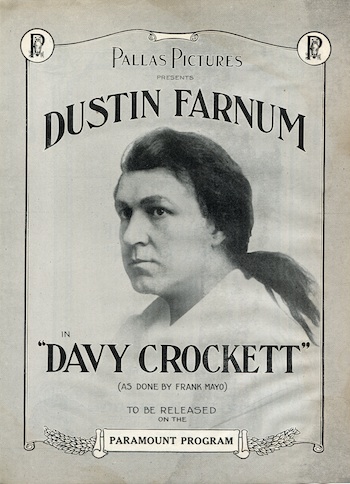
Collection of the author |
In the photo, above, Davy breaks into the wedding and walks off with the girl—after apparently walking through a time warp to the 1700's, with everyone wearing powdered wigs and fancy leggings. The costumes were probably left over from "David Garrick," which the crew had filmed the week before. (Image Source: Academy of Motion Picture Arts and Sciences: Margaret Herrick Library; Fairbanks Center for Motion Picture Studies)
Farnum actually had to play the hero in real life, too. When filming began in early spring, 1916, at Strawberry Flat (now Twin Peaks) near Big Bear Lake in California, the crew encountered a snow blizzard, and Farnum had to rescue two female hikers near the Arrowhead Springs Hotel, then saved co-star Winifred Kingston when she lost her footing in the stream. "We were completely snowbound eight days," Kingston told Photoplay. "And we found in the snowdrifts the body of a man who had been frozen to death. I fell into a swirling mountain torrent, and the nerve and quick wits of Dustin Farnum saved my life. It's all part of the day's work, and wonderfully fascinating. But goodness gracious, that water was cold!" There were also problems with Bessie, the 480-pound bear used in the film, who left Kingston with a "long, red and rather severe scratch on the fore-arm," and then broke away from her keeper and tried to escape across Big Bear Lake. Kingston said by the end of the film, Bessie hand she had become great friends and was able to ride on her back!
Farnum would eventually divorce his wife and marry co-star Winifred Kingston. They had acted together a year before under the direction of (former Crockett) Hobart Bosworth for Captain Courtesy, a romantic melodrama set in old California. Dustin was married three times, always to his co-stars.
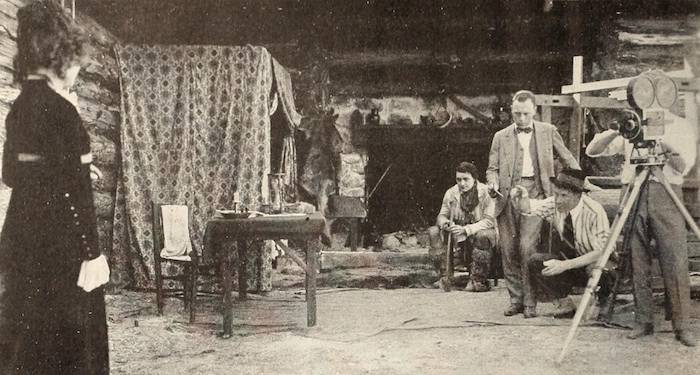
William Desmond Taylor directs Winifred Kingston as Dustin Farnum relaxes. (From the fan magazine "Film Fun" in 1916)
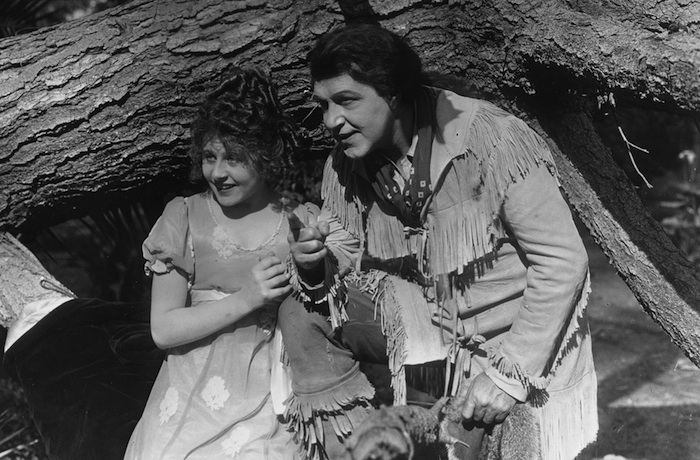
Wisconsin Center for Film and Theater Research |
Now almost forgotten, William Desmond Taylor was one of the great silent directors. He was born William Cunningham Deane-Tanner in Carlow, Ireland on April 26, 1872. He left home at the age of 18 after a falling-out with his father. Taylor immigrated to the United States working as an engineer, gold miner in Alaska, and an actor in New York.
In 1901 he married Ethel May Harrison. Daughter Ethel Daisy Deane-Tanner was born in 1903. Not able to support his family as an actor, Taylor worked as an antique dealer in a business financed by his father-in-law. In 1908, he went to lunch and never returned, walking out of his wife and daughter's lives without a word.
In 1912 he arrived in California and began his career in silent films. He left Hollywood briefly to serve in the British Army during World War I and returned to his career as a director. His most famous films were based on literary works such as Tom Sawyer (1917), Anne of Green Gables (1919) and Huckleberry Finn (1920).
On February 1, 1922, Taylor and silent film comedienne Mabel Normand enjoyed Orange Blossom Gin cocktails, discussed Nietzsche, Freud and movies. Mabel played comic riffs on the piano. At about 7:45 p.m. he walked her to her car leaving the door open or unlocked to his exclusive Alvarado Street bungalow. As her chauffeur drove off, they blew kisses at one another. That was the last time anyone saw Taylor alive (except for his killer, who wasn't talking). A framed photo of Winifred Kingston was hung on the wall nearby. Taylor's murder remains officially unsolved. Between his murder and Boggs', directing Crockett in silent films was apparently a dangerous business.

This still shows Davy (Cullen Landis) on the right being welcomed to the Alamo. The guy on the left is Lige Beardsly ("the champion spitter in the South"), who spends the entire battle spitting on Mexican soldiers from the top of the Alamo walls. Standing behind them is "Pinky Smith," played by Bob Steele—who became a regular in the TV Series F Troop, in which he played the character of Trooper Duffy, who claimed to have been "shoulder to shoulder with Davy Crockett at the Alamo." And at least in one sense, he really had... (Collection of the author)
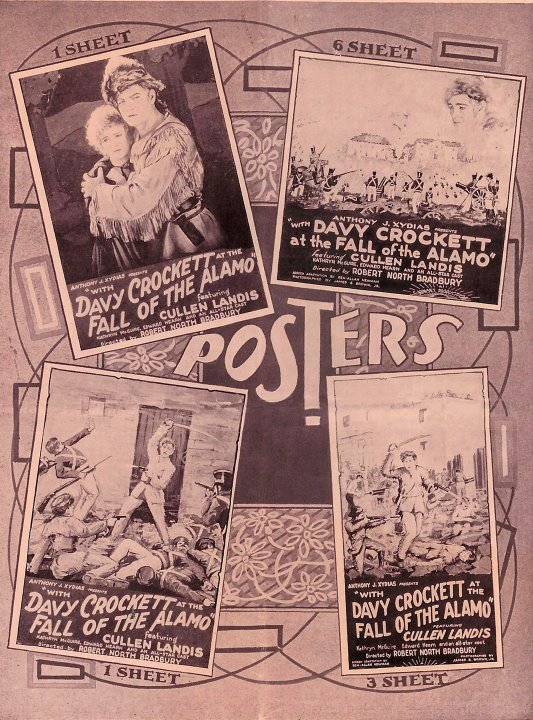
Image Source: Frank Thompson |
The United States entered a devastating World War after the release of Davy Crockett, and a year later Prohibition (sometimes referred to as the "Noble Experiment") was mandated by the Eighteenth Amendment to the Constitution. First proposed in thr Senate on December 18, 1917, it was approved by 36 states, and ratified as the 18th Amendment on January 16, 1919. A national ban was enforced on the sale, manufacture, and transportation of alcohol. Between devastating wars and a ban on liquor, a hard-drinking boastful fighting man was not a popular subject matter for films in the United States, anymore.
It took another seven years before Davy would appear onscreen again. After having to describe so many lost silent films, I can say that this one, unfortunately, survives. The film's press book was very impressed with itself, however: "The screen version of the great epic, 'With DAVY CROCKETT at the FALL of the ALAMO,' deals with the life of this hero from the time of political defeat in Tennessee until he lay a ghastly martyr to the sacred cause of liberty.
"Scattered in the dust of decades are the ashes of Davy Crockett, but in the story he lives again with his kindly aiding grace toward others and his willingness to die for an ideal."
In 1926, the United States was 150 years old. Through wars, expansion, abolition, and reconstruction, the country had reinvented itself many times over. It had also reinvented its heroes in the process. When we had last seen Davy Crockett onscreen, some ten years earlier, he was a noble 26-year-old virgin, living with his mother in a humble cabin, deep in the woods. As technology changed society, the widerness disappeared, and the country was heading towards a world war, Davy Crockett had looked back nostalgically on a less confusing, uncomplicated time. In the ensuing ten years since that film, America had tipped the scales in the outcome of a World War, and was now a major power.
It had become a proud country—the Great Depression hadn't arrived yet, and the people of the United States had a confidence in their vision of themselves. The heroes of the past were looked on with pride, admiration, and thanks. Their values and integrity were never questioned. Therefore, it was the perfect time for the historical Crockett to reappear: The politician, patriot and war hero (minus the hard-drinking, of course—there was still Prohibition).
Director Robert North Bradbury had toured San Antonio as a stage actor early in his career, and spent a day going through the Alamo and learning its history. He was inspired to create a play from the story, but it never materialized. Moving into the film business, he pushed the idea around town, but was told it was too expensive. Somehow, it ended up with the cheapest producer in Hollywood: Anthony J. Xydias (1882-1952).
Despite (of perhaps because of) his Greek origins, Xydias made a career out of producing cheap, quickie American history films. He had opened a theater in Dallas, Texas in 1906, which quickly became a chain. Wanting to make his own films to express himself artistically (okay, he wanted to keep all the money instead of giving distributors all the earnings), Xydias then founded Sunset Pictures in 1922 to produce cheap Westerns with rodeo rider Jack Hoxie. The films were successful enough that Hoxie left for a better deal with Universal Pictures after just six films. Xydias replaced him with J.B. Warner, who promptly died of tuberculosis. Xydias then produced a series of frontier films. If it wasn't hard enough to spell "Anthony J. Xydias Presents" on a theater marquee, these films had some of the longest, least-grammatical film titles ever: With Kit Carson Over the Great Divide (1925), With Buffalo Bill on the U.P. Trail (1926), With Daniel Boone Through the Wilderness (1926), With General Custer at Little Big Horn (1926), and this film, also in 1926 (another film, With Sitting Bull at the Spirit Lake Massacre, opened and quickly closed in 1927).
Xydias announced in 1925 that an actor named Ray Stewart would play Crockett in an Alamo film that was to be shot in San Antonio, called With Davy Crockett at the Fall of the Alamo. Stewart (October 17, 1883 - April 26, 1933) appeared in 138 films between 1915 and 1933, primarily westerns. His most prominent role was with Mary Pickford in Sparrows. In 1926 alone he starred in two of Xydias's pictures, entitled, With Buffalo Bill on the U. P. Trail and General Custer at the Little Big Horn. Stewart must have been overbooked, because he didn't end up playing the part.
Xydias then agreed to pay for a legitimate silent film actor to star (or at least the brother of one). Cullen Landis was the brother of actress Margaret Landis. He went to Hollywood in 1917 after a short theatrical career, planning on becoming a director. But instead his good looks got him acting roles as a leading man in over 100 films, most of them romances and domestic melodramas.
With Davy Crockett at the Fall of the Alamo was the most elaborate of all of the Xydias films (read: the least cheap-looking). Bradbury was a decent director who truly cared about the subject. "It is a pleasure to be able to realize an ambition of this kind," Bradbury says in the film's press kit, "and to feel that after many years an early dream of dramatic possibilities has been given to the silver sheet."
Early scenes set in Tennessee show Crockett as top-hatted gentleman, with the title card reading: "Davy Crockett—Woodsman, statesman and one of the most gallant fighters ever enlisting in America's cause." Crockett is informed by his friend Lige Beardsly ("the champion spitter in the South") that the "Election's gone ag'in you." Crockett is visibly shaken, but says, "It's just as well, Lige—I'm through with politics—and Texas needs me." Lige clears his mouth of mucous long enough to say, "Wal' Davy—as you allus say: Be sure you're right, then go ahead—an' if you say 'go'—we'll jog along too."
Next comes an important scene in the history of Crockett films. Crockett sees his buckskins hanging in his cabin. Smiling, he begins removing his city attire and says, "TEXAS MUST BE FREED FROM MEXICAN RULE!" He puts on buckskin & coonskin hat and prepares to travel west for the Alamo.
It also may be the only Crockett film to show him as a slave owner. As Crockett's friends leave, a black man approaches Crockett and says, "Marse Davy—can't you take old Mose along — to fight for Texas?" Crockett puts a hand on Mose's shoulder and says, "No, Mose-I'm trusting you to stay-and guard the women." (That idea wouldn't have been a popular idea with Martyrs of the Alamo producer D.W. Griffith.)
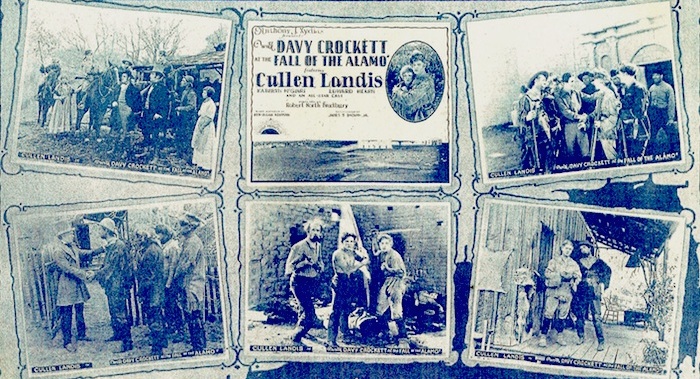
Reviews were actually kind (for a Xydias picture, anyway). Moving Picture World reported, "This is the only one of the so-called Sunset Specials that was worth running. This one does very well. However, it is not a special, only in price. Tone, yes. Appeal, some." The film may be more notable for what it tried to do than for being a successful film. Historian Peter C. Rollins wrote in his book The Columbia Companion to American History on Film: How the Movies Have Portrayed the American Past that, "Davy Crockett at the Fall of the Alamo proved significant because it argued (accurately) that the annexation of Texas was as much for the expansion of slavery as it was the extension through Manifest Destiny of the territorial holdings of the United States." (Columbia University Press, 2003. 671 pages, p. 143) The film was influential in other ways, as well. One patron who saw the film at the Loew's Theater in Los Angeles would be very important in the cinematic history of Davy Crockett: He was a young actor named John Wayne. Bradbury would then direct Wayne in Riders of Destiny in 1933 (the Duke played "Singin' Sandy Saunders"). They collaborated in no less than six films the next year, and five more in 1935, and you can be sure the topic of the Alamo was discussed, as it soon became Wayne's obsession.
Fortunately, a partial print was found in recent years by film collectors, and it can now even be purchased now on DVD. Another copy resides at the Library of Congress, containing one more reel than the DVD release (it involves mostly a love story with supporting characters, including the Bee-keeper). Although uneven and downright boring in parts (and that's with two reels missing), this film is a crucial link to the Crockett films of the fifties, and makes a serious attempt to portray the historical character (with the best information they had at the time). In 1928, Landis would star in Warner Brothers' first feature-length talkie, Lights of New York, but his studio career didn't last into the sound era. He moved to Detroit where he created industrial films, military training films and documentaries (all hopefully more accurate than With Davy Crockett at the Fall of the Alamo).
Several other Crockett projects were announced in the twenties, but were never made. On September 10, 1926, writer Isadore Bernstein put an ad in the trade The Film Mercury announcing that a "photoplay manuscript" was available called Remember the Alamo, "portraying adventures of David Crockett, Sam Houston and Jim Bowie in their desperate struggle for the freedom of Texas." Nothing came of it. In 1927, Paramount announced that Fred Thompson would play the title role in Davy Crockett. J. Warren Kerrigan went inside the Alamo itself in April of 1925 to announce that he would star in yet another version of the play Davy Crockett. "From the time I first saw old Frank Mayo as Davy Crockett in the stage play of that title, I've been determined to play him too." Kerrigan recalled watching his sister, an actress, playing opposite Mayo in the play during his childhood in Illinois. "I remember Mayo, as Crockett, standing at the log cabin door, his mighty arm thrust through the iron cross-bar sockets on the door to hold it against a pack of snarling wolves. To me, Mayo was superb. Then, too, he was doing it to save the heroine, my sister. The scene fired my boyish imagination." Kerrigan really played it up. Wandering through the Alamo's chapel he cried out, "So this is where they found him, behind a breastworks of the bodies of his foes ... In one hand a dripping Bowie knife and in the other the wreck of the Philadelphia rifle. What drama! I'm going to do 'Davy Crockett' for the pictures, and I'm going to do it in San Antonio!" Sadly, he didn't.

One last silent film was made with Crockett, actually appearing after the advent of sound films: The Alamo: Shrine of Texas Liberty is a 1938 American black-and-white war film directed by Stuart Paton, best known for silent films like Twenty Thousand Leagues Under The Sea (1916). The film was a two-reel short produced in a couple of weeks in San Antonio, and released soon after the centennial of the Alamo. The film was an educational reenactment of the siege done in pantomime by local actors, and audio was done by narration and organ music. Although shot in the same city as the Alamo, the filming location was actually Misión San José y San Miguel de Aguayo, a few miles away. The mission was established in 1720 and wasn't designated as a National Historic Site until 1941, so the filmmakers could still use it as they pleased. Santa Anna actually has prisoners executed after the battle in this film (played by men snatched out of the city unemployment line), but Davy isn't one of them.
One problem with all of the Crockett silent films is that they couldn't convey his wit, and confined his character to melodrama. That all changed with sound.
4: THE ITERNERANT AND THE WASTREL
The 1930s were a time of poverty and dissatisfaction with the government. Itinerant workers searched the country for work, and there was a mass exodus west from the dust bowl. People were looking for something, anything, better.
Meanwhile, there were great advances in film during the 1930s, like color and sound, but storytellers were struggling to connect with a culture that was imploding from the Great Depression and its after-effects. Screenwriters looked for characters in their films to connect with audiences in different ways than they had in the Roaring Twenties. Suddenly a poor, unschooled, disadvantaged hero seemed like a suitable hero in a film.
The advent of talkies would have seemed to provide filmmakers with the missing piece to the Crockett persona: his wit. Davy could be funny now, and was rescued from the melodramatic mire that he had been forced into when lacking a voice. The real Crockett's trademark was his frontier brag, which had only survived in books. But no such productions materialized in early Thirties, as the mood of the Depressed nation wasn't very self-assured and boastful (besides, early talkies had no action, because the microphones were ungainly and primitive and had to be used on indoor soundstages). Interest in Crockett — at least from film studios — appeared to be waning.
However, once talkies could leave the soundstages in the later Thirties, filmmakers seized on the wandering ways of frontiersman Davy Crockett. In these films he was stripped of his political career (congressmen were not exactly popular during the Great Depression) and he became the frontier embodiment of the vagabond migrant worker, moving west as a scout or explorer on a quest for a better life.
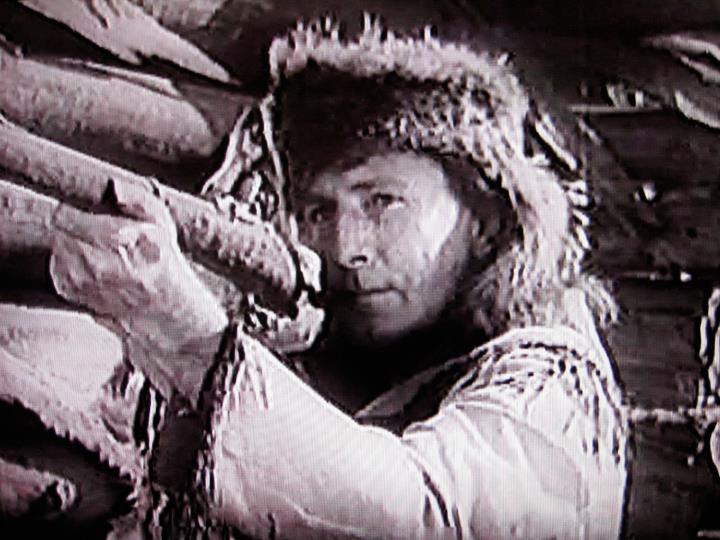 |
The first talking Davy was played by Bud Geary in The Miracle Rider (1935), the last film by Tom Mix, once the greatest cowboy star in silent film. Mascot Pictures Corporation lured the 55 year-old Mix — dyed hair, arthritic back, broken jaw, dentures and all — out of retirement in 1935 for an $80,000 super-serial (over double their usual budget). Half of that budget went just to paying Mix — $10,000 a week for four week's work. Mix needed the money, too — he had to bankroll alimony payments, court fees, a full touring circus, and a $250,000 mansion with a large neon sign on top that flashed "TOM MIX" all night, every night. Being a modern folk hero was expensive!
Crockett is only in the prologue for the 45-minute first chapter, "The Vanishing Indian" which places Mix in a natural progression of frontier heroes like Daniel Boone to Crockett, to Buffalo Bill, to Mix, and traces the U.S.'s westward expansion across Native American land in North America. In the year 1825, when a couple of trappers approach the cabin of "DAVY CROCKETT who later became a hero of the Alamo" (Bud Geary), although the real man was entering his first term of Congress during that year, not living in a cabin on the edge of Native American lands. The character of Crockett speaks his first words onscreen, injecting a crucial element missing from silent films — verbal wit (or at least taking a stab at it):
COPELEE
(offering hand)
My name's Copelee.
CROCKETT
(shaking hands)
They call me Davy Crockett.
COPELEE
I've heard of you! They say you're a good shot. I'm pretty good myself...
(points to a fur hanging on the door)
I'll shoot you for that skin you got hangin' there...
Crockett eyes the second trapper, waiting at the foot of his property.
CROCKETT
If I was a gamblin' man you'd lose, Copelee...
Crockett aims his rifle, and shoots the pipe of the second trapper off its stem.
COPELEE
(humbled)
I, aw... Are there any beaver up ahead?
CROCKETT
Plenty. But that's Indian country. We don't trap on their land.
COPELEE
"We" don't?
(pokes Crockett with his finger)
Listen, I trap anywhere I please!
CROCKETT
(inspecting Copelee's scalp)
Is your hair on pretty tight?
COPELEE
Aw, my hair's all right...
(more poking)
... Let me tell you something! I've been killin' Indians for the past twenty years. I can do a little scalping, myself!
Copelee picks up his rifle and storms off.
CROCKETT
You'll have to kill a lot more of 'em to do any trapping where you're heading!
Copelee and his buddy are killed in the next scene. We then go on to see footage of a Huron attack on a wagon train was actually lifted from Mascot's Last Of The Mohicans, with aging former-Crockett, Hobart Bosworth, as Chingachgook (called Sagamore in the film), used to spice up the action. But this was the beginning of a trend in which Crockett is a wandering frontiersman to the exclusion of his political career.
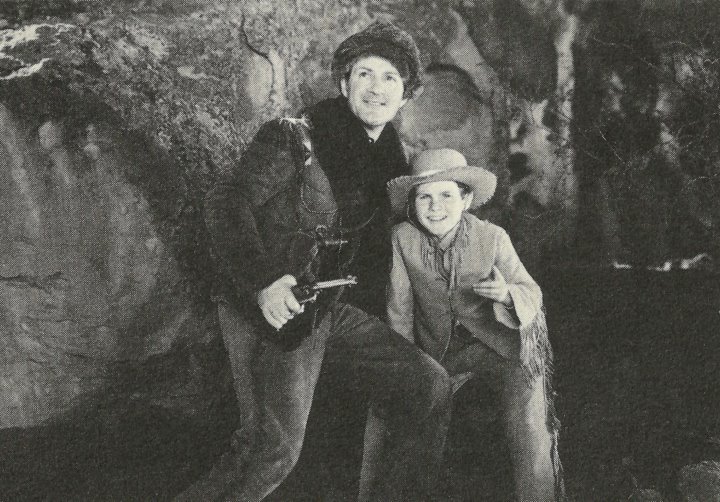
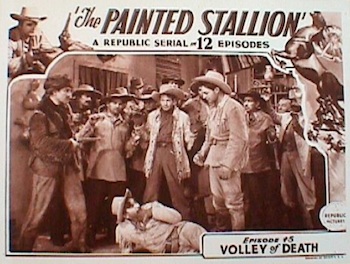
Thinking quickly, Davy fires off a six-gun pistol thirty years before it was invented. (Collection of the author) |
The oddest-looking Davy ever (did he steal his mom's mink stole?) was played by Jack Perrin in 1937's The Painted Stallion, a 12-chapter serial by Republic Pictures, in which Davy plays a more prominent (if less historically accurate) role. In this story, he's a "reckless adventurer of the plains" in New Mexico in the early 1830's — about the time the real Crockett would have been speechifyin' in Washington. He's now a scout touring New Mexico saloons with drinking buddies Clark Stuart and Jim Bowie — about the time that the real Bowie would have been killing a man in the sandbar fight in Mississippi. The three scouts teach a young Kit Carson (Sammy McKim, pictured above) how to beat up bad guys — about the time the real Carson would have already reached manhood. Obviously, this is not one of the more thoroughly researched Crockett films, but it's a lot of fun.
This has to be the worst looking Crockett character yet. Instead of buckskins, he wears a dark fur coat with fringe and a dark animal skin cap-the outfit looks like belongs on an Eskimo, not a frontiersman. Bowie (who strangely enough wears a proper fur cap and buckskins instead of Crockett) is captured, but escapes to warn everybody of the plan. Crockett, even though he is called a master of the long rifle, shoots a late 19th Century pistol throughout the entire series, never touching a rifle once.
Wearing some sort of muskrat carcass on his head, and called a master of the long rifle in the credits, Crockett fires a six-gun pistol for the entire story — a good trick, since they weren't invented yet.
The episodes were co-directed by Ray Taylor, Alan James and William Witney. In fact, Witney said he got his first co-directing credit on the film after accompanying the crew to the St. George, Utah, location as a film editor. The shooting fell behind because of weather, and because Taylor had gotten so drunk by lunchtime one day about halfway through filming that he had to be taken home. Witney, just 22 at the time, was called upon to replace Taylor and finish the picture, and would become one of the star directors at Republic.
The 12-chapter serial was based on the book of the same name by Hal G. Evarts, originally serialized in three issues of The Saturday Evening Post, but the serial isn't faithful to the source material at all, using an entirely different story about the first wagon train running from Independence, Missouri, to Santa Fe, New Mexico. The writers got so wrapped up in the new story that they forgot to include a painted stallion, so they invented a blonde girl on a pinto stallion who lives with a mountain lion and shoots whistling arrows to warn the wagon train of danger.

The Rider (Julia Thayer, who later changed her name to Jean Carmen) is the sole survivor of a massacre and is worshipped by the Indians for her blonde hair. (Didn't work too well for Custer, but whatever.) She helps open up the wagon train route to Santa Fe, insuring the destruction of her Native American friends in future decades.
Thayer worked with an actual mountain lion in the cave scenes; at first she was afraid, until Witney had her pet the animal with him. It licked her hand, and she cooed, "He's as tame as a kitten." Preparing for the shot, she put on her Indian headdress and started her scene, stepping up to the cat and raising her hand to deliver an order. The cat angrily swiped at her with his paw, knocking the feathered headdress off the actress' head and sending her into hysterics as she was knocked backwards. "When she was petting the mountain lion she didn't have the feathered headdress on," remembered Witney. "I'd forgotten that we'd been teasing the lion with a live chicken to get some expression out of it earlier in the day."
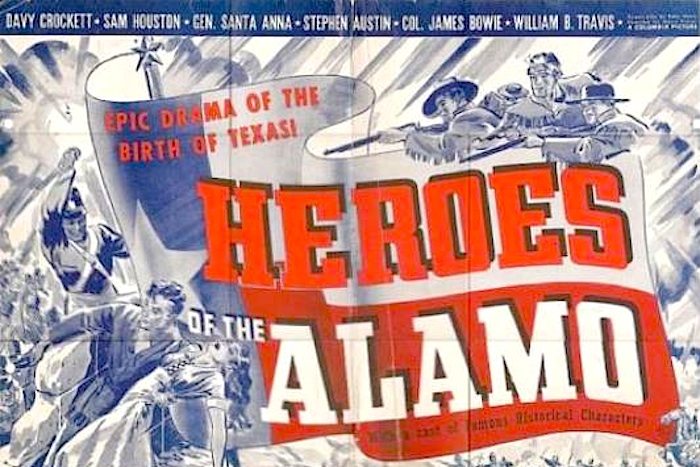

Image Source: Wisconsin Center for Film and Theater Research |
Heroes of the Alamo starred Lane Chandler as Crockett. The film, a low-budget retelling of the events of the battle of the Alamo, was produced by Anthony J. Xydias, reusing the battle scenes of his 1926 silent film With Davy Crockett at the Fall of the Alamo. It was made "to take advantage of the national attention afforded the centennial of the siege" but violated the Roosevelt administration's Good Neighbor policy, which tried to enlist the film community's aid in improving U.S. relations with Latin America. The brash, flag-waving Davy in the film from the previous decade is now replaced by a loner for the post-Depression era. It was released in August, 1937 through the States Rights system that handled Poverty Row independent films.
Boxoffice Magazine called it, "A conglomeration of stock shots and jerky action, almost completely devoid of the intimate romance and atmosphere so necessary to the successful presentation of historical drama, this is a carelessly made low-budget production that will find few takers among the average class of action lovers."
Despite the film's lowly prospects, a year later, Columbia Pictures lacked enough house-produced films to fill their exhibitor contracts and actually bought the film, releasing it in 1938 as their own.
Lane Chandler's Crockett looked more traditional — but his speech was less decipherable. Santa Anna orders a soldier to kill a wounded Crockett, whose last line is something like "Be danged to ye!" ... but nobody can be sure, as the delivery of the line is indecipherable. (Collection of the author)
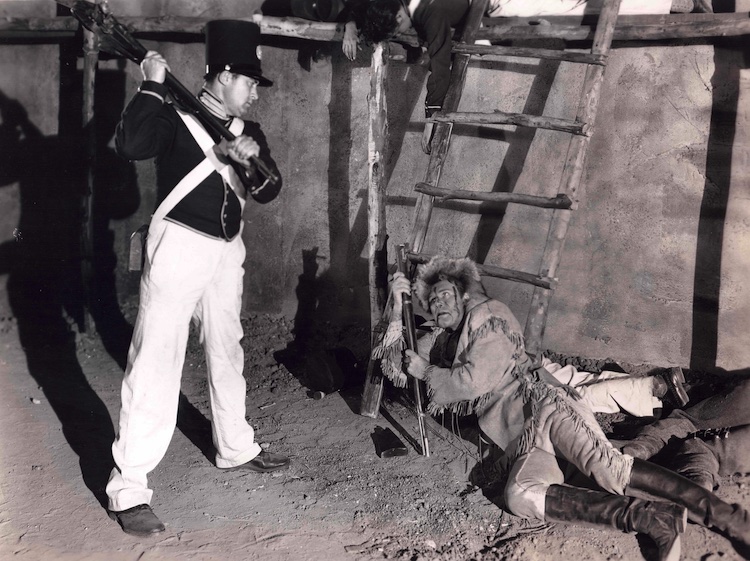
In the still, below, Davy almost fiddles a tune (until the filmmakers discovered that Chandler couldn't play, so then he just holds the instrument a lot). So instead, the group sings "The Yellow Rose of Texas" — a good trick, since it wasn't written for another fifty years. (Collection of the author)
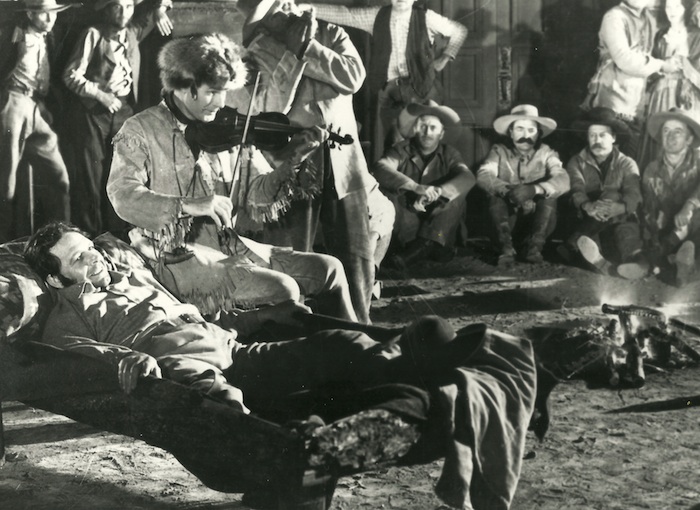
Davy Crockett is an unfinished 1938 musical by the legendary Kurt Weill. (Book and lyrics by H.R. Hays.) According to "Kurt Weill on Stage: From Berlin to Broadway," by Foster Hirsch (published by Alfred A. Knopf, 2002, p.161): "Burgess Meredith, who had become a personal friend, suggested musicalizing The Ballad of Davy Crockett by H. (Hoffman) R. (Reynolds) Hays, a left-wing writer who had worked for the Living Newspaper and who was later to work with Brecht and Hanns Eisler. Like "Johnny Johnson," Hays' Davy Crockett is an idealized American Everyman, a folk hero whose story is told in chronicle form. But unlike Johnny, Crockett thrives, making his way from the backwoods of Appalachia to the halls of Congress to a valiant death defending the Alamo against Mexican attack. Weill had doubts about the content, but was drawn by the chance to experiment with a new theatrical format."
"In December 1937, Kurt Weill, Charles Alan, and I formed a corporation, the Ballad Theatre," Burgess Meredith recalled, "which would take the following musical form: a chorus of singers would sing the main story line, and the actors would go into the action only when the mood was prescribed by the chorus. The chorus would be large and varied, and would replace the orchestra. The voices would perform the harmonies and functions of the orchestra. It was essentially Kurt's idea. If any instrument at all was used, it had to be a part of the action, like a flute or drum." From January to April in 1938, Weill completed about forty-five minutes of choral music, but stopped working on Davy Crockett to pursue other projects.

Sunrise in My Pocket: The Last Days of Davy Crockett was a play written in 1938 by screenwriter Edwin Justus Mayer, who is famous for working with Ernst Lubitsch on the classic films To Be or Not to Be (1942) and A Royal Scandal (1945). Because of financial and political concerns (World War II was approaching) this play was never produced on Broadway. It was performed in a single community theater workshop, but then forgotten. The image, above, is a Motion Picture Daily ad for a scrapped film version of the play, with a screenplay by Frank Butler, to be directed by Henry Hathaway. "Imagine an Indian with a Harvard accent, a gentleman swindler, a lady with an amazing past ... a retired pirate and Davey."
According to Artistic Director David Hammond, who finally put on the play in 2002 at PlayMakers Repertory Company at the University of North Carolina, that long period of neglect was no accident: During the Cold War, "no commercial theater producer wanted to take on a work that could be seen as questioning any aspect of America or its values." Mayer's Davy is fed up with "politics as usual." He has just told his Tennessee constituents (represented as a pack of bankers and speculators that confiscated land from poor farmers), "You go to hell; I'm going to Texas."
Perhaps due to the national feeling of dread stemming from the rise of fascism and the the war brewing in Europe, the play can come off as a little bloodthirsty, as well. In sight of the Alamo, characters Annie and Thimblerig marry and hear the sounds of battle in the distance, saying, "They're playing our wedding march!" That's about as close to a happy ending as the play can get.
Epilogue to Weill and Mayer: The two geniuses collaborated on another project (unrelated to Crockett) in late June 1944. Weill traveled to Hollywood for collaboration with Mayer and Ira Gershwin on "The Firebrand of Florence" — remaking Mayer's first hit play as a musical. It was the only flop for all of them.
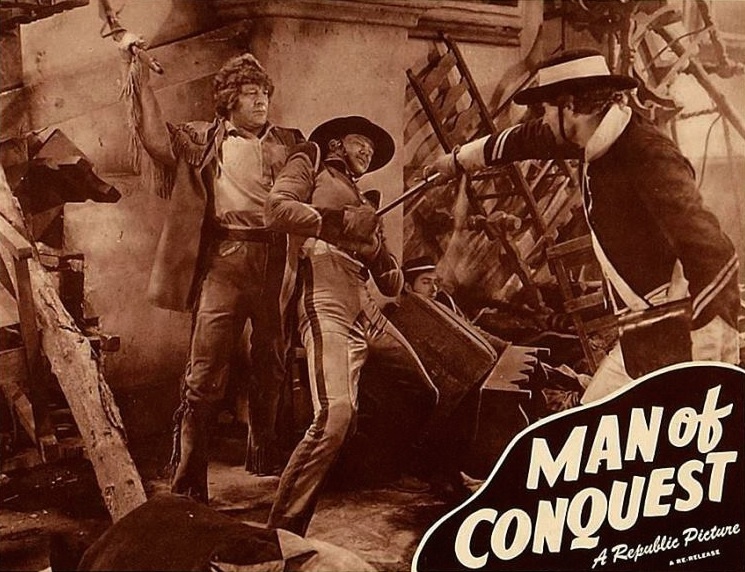
Man of Conquest, a 1939 Republic Pictures release, is another story of dubious historical merit — one scene shows Sam Houston arriving on Texas soil just in time to help Crockett and Jim Bowie defend a cabin against an Indian attack! (Huh?) The tone of this film is paranoid and reactionary, with Texans constantly surrounded and under attack. This might have been because World War II was approaching, as the oppressive Third Reich was invading and conquering counries in Eastern Europe. So for this film, Santa Anna is portrayed in this film as as a Hitler-like dictator — complete with hair pasted over his forehead and a wispy little mustache.
Lane Chandler — Crockett in Heroes of the Alamo just two years before — returns in this Alamo battle... as Bonham! Instead, Crockett is played by Robert Barrat, who was once described by his friend James Cagney as having "a solid forearm the size of the average man's thigh." A Republic press book for the film described the character of Crockett this way: "Within the mission walls was ROBERT BARRATT (sic) as pioneer and frontiersman David Crockett, abed with serious wounds. Though the Indian Fighter's body was racked with pain, his hands were not idle. He was making bullets, filling guns, cleaning rifles. And when the end was to come, when Santa Anna's men had poured over the walls, he was to defend to the last the small vestry room of the mission in which he and the other stricken fighters had been placed." Barrat played several other historical characters in his career, among them Zachary Taylor in Distant Drums, Abraham Lincoln in Trailin' West, and General Douglas MacArthur in American Guerrilla in the Philippines. He was also seen as the Native American Chief Chingachgook in the 1936 film version of The Last of the Mohicans.
Once World War II started, Alamo movies fell out of vogue in the United States, as Mexico became a military partner and joined the Allied forces after German U-boats attacked and sunk two Mexican tankers during the month of May, 1942. Hundreds of thousands of Mexicans subsequently volunteered and joined the US armed forces, some estimates going as high as 400,000.
There were also early warnings of coming Cold War with the Soviet empire in Mexico. In 1936, exiled Soviet politician Leon Trotsky and his wife Natalia Sedova moved to Mexico from Norway during their exile. President Lázaro Cárdenas welcomed Leon Trotsky to Mexico, and even arranged for a special train to bring him to Mexico City in 1939. Trotsky then lived in the Coyoacán area of Mexico City at the home (The Blue House) of painters Diego Rivera and Frida Kahlo (with whom Trotsky had an affair). On August 21, 1940, Trotsky was assassinated with an ice axe by undercover NKVD agent Ramón Mercader.

President Grant asks "Dave" Crockett Jr. (Bill Elliott) if his family will save Texas one more time in "Son of Davy Crockett" (1941). Want to know some trivia about the real David Crockett, Jr.? There was no David Crockett, Jr. (Photo source: Collection of the author)
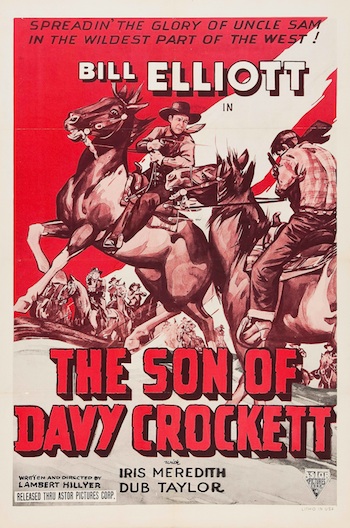
"Son of Davy Crockett" was originally released by Columbia Pictures Corporation in July of 1941, it was then re-released by Astor Pictures in 1951. (Collection of the author) |
Son of Davy Crockett (alternate title: Blue Clay) was released in July of 1941 with the tagline: "THE SON OF A HERO... AND A TWO-FISTED, HARD-FIGHTIN' SON-OF-A-GUN! Spreadin' the glory of Uncle Sam in the wildest part of the West!"
During the Reconstruction era, Young Dave — not Davy — Crockett (Bill Elliott), the son of the famous frontiersman, now “a gunfighter from up around Kansas,” and his sidekick Cannonball (Dub Taylor) ride into town in an untamed territory known as the Yucca Valley Strip, in order to deliver a wagon containing the bodies of three dead men they found at a poisoned spring. Dave enters the building to confront the murderers, offering them some of the spring water from his canteen, and when the men draw their guns, Dave shoots them dead. Accused of murder by the town's crooked marshal, Dave and Cannonball become fugitives. He kills two suspects at a bar while cannonball covers the crooked local sheriff. Then is captured by the army, and taken to Washington DC. We see a shot of the Capitol Building (?), and then President Ulysses S. Grant (Harrison Greene), who writes at his desk while smoking a cigar. Crockett is led into the room wearing formal clothes, white hat in hand. Grant finally stops the writing, sits back in his chair, and looks him over.
PRESIDENT GRANT
So you're that wild young Crockett.
CROCKETT
Just 'Dave Crockett' if you don't mind, general—
PRESIDENT GRANT
—Just 'Mr. President' if you don't mind, Dave.
President Grant offers Dave a pardon in exchange for helping the ranchers of the Yucca Valley Strip. At the close of the Civil War, the strip was not incorporated into the Union after the Civil War because of a surveyor's mistake, and now a corrupt despot named King Canfield (Kenneth MacDonald) rules the territory. Grant sends Dave on a special mission: "I had the army bring you in because I need somebody to go to the Yucca Valley Strip as 'unofficial representative' of the government. Your father left you a great heritage and a fine name. Maybe I'm taking advantage of those facts." (Grant apparently forgot that Dave's dad left the country to frm an independent Republic of Texas, himself.)
Dave then travels to the Strip and is greeted by Doris (Iris Meredith). As they exchange pleasantries, Canfield's men arrive and confiscate the stagecoach strong box, which carries gold for the local ranchers, and King wants the gold as a "tax." One of the ranchers is about to draw on them, when Dave grabs his gun hand and dissuades him. Canfield's henchman Jack Ringe (Donald Curtis) tells Crockett that was a smart move, adding, "You're dressed for either preachin' or gamblin'." (Possibly a reference to the real David Crockett, who complained that his Washington finery made him look like a Methodist preacher.) The henchmen take the strong box and ride off — as Dave reveals he switched the gold for metal washers.
Dave then goes to Canfield's office in Yucca City and clashes with henchman Jack Ringe, who fits the description of one of the poisoners. After pummeling Ringe, Dave invites Canfield to a meeting of the ranchers. At the meeting, Dave steps forward (Again, one of the ranchers remarks: "Looks like a preacher!") and reads a letter from President Grant authorizing an election to admit the Yucca Strip to the Union, causing Canfield to protest that he is the ruler of the strip. Angry, the ranchers decide to lynch Canfield, but Dave stops them, thus earning their enmity.
Canfield begins a campaign of intimidation against the ranchers to insure that he will win the election. Accusing Dave of complicity with Canfield, rancher Jesse Gordon denounces him as a traitor, and Mathews asks him to resign his commission.
On Election Day, the two opposing sides eagerly await the vote's deciding returns from Southfork. Ringe and his men ambush Gordon, who is delivering the voting box, but Crockett has trailed them and kills Ringe, then escorts Gordon into town with the voting box. The election is close, and Doris implores the few remaining ranchers to cast their ballots, Canfield instructs his men to torch the voting office if he loses the election. Overhearing Canfield's directive, Cannonball alerts Dave, who then confronts Canfield. When Canfield draws his gun, Dave kills him, insuring that democracy will reign in the Yucca Strip.
After the votes are tallied, the motion for inclusion in the Union is passed, and Mathews proudly hoists the American flag, as Dave salutes and grins at Fade-Out.
Bill Elliot took time out from his "Wild Bill Hickok" westerns series to essay the title role in Son of Davy Crockett. Elliott played another historical figure in the same year in The Return Of Daniel Boone. This was one of 10 films in which the star was teamed with comic sidekick Taylor. Originally released by Columbia Pictures Corporation in July of 1941, then re-released by Astor Pictures in 1951.
By 1945, John Wayne started a long campaign to make an Alamo film with Republic Pictures. He hired James Edward Grant as scriptwriter, and the two began researching the battle and preparing a draft script. They hired Pat Ford, son of John Ford, as a research assistant. Here, he and John Ford inspect a rifle attributed to Crockett at the Alamo. Ford decided against directing the film. As the script neared completion, however, Wayne and the president of Republic Pictures, Herbert Yates, clashed over the proposed $3 million budget. Wayne left Republic over the feud, but was unable to take the script with him. It was later rewritten and made into the The Last Command.


Montgomery sharpening a knife on his finger. (Collection of the author) |
Then there's Davy Crockett, Indian Scout (US Theatrical Release Date: January 06, 1950), a low-budget western adventure from Edward Small Productions, released by United Artists. George Montgomery plays DAVY CROCKETT... well, actually, he plays Davy's nephew, presumably because somebody in the fact checking department found out that Davy had been dead for 20 years by the time this story was supposed to occur. It resulted in stilted conversations like this:
CROCKETT
There's a powerful lot of land in this country — enough for everybody, Indians and the Whites alike, if they'd only portion it out.
FRANCES
That's been tried by treaties. Settlers always move into the Indians' lands.
CROCKETT
Yeah, I aim to do something about that someday. I'd like to go to Washington like my uncle did—the famous Davy Crockett.
Also appearing in the film is Robert Barrat — who played the elder, more famous Davy in Man of Conquest — as Chief Lone Eagle (he's seated with arms folded in the above photo). His casting as the villain makes this a rare instance of one film Crockett killing another film Crockett. The film was directed by B-film everyman Lew Landers, who proved he could be incompetent in any genre (in the same year as this film, alone, he directed Revenue Agent, Last of the Buccaneers, Chain Gang, State Penitentiary, Beauty on Parade, Dynamite Pass, Tyrant of the Sea, and Girls' School).
Reviews were not very positive. Bosley Crowther of the New York Times wrote that: "There's nary a cowboy in sight and its hero is not the Davy Crockett of Alamo fame. He's only the famous frontiersman's cousin (sic).... there's lots of fireworks and little logic." In The Rotarian, Jane Lockhart wrote that the movie's "good cast [is] wasted on a film so filled with clichés [and] fantastic heroic exploits by unerring scouts as to be almost a burlesque of movie westerns."
Outside of a few films with B-actors playing Davy's sons, daughters and nephews, nobody seemed very interested in filming the man (or legend) himself, anymore. Maybe they felt his story had been told too often, or wasn't relevant to the time.
Then on March 12, 1947, U.S. President Harry S. Truman stated that it would be "the policy of the United States to support free peoples who are resisting attempted subjugation by armed minorities or by outside pressures." His policy was dubbed the "Truman Doctrine," and many historians often use that date to mark the starting date of the Cold War. It wasn't the kind of war that you'd think a 19th-Century frontiersman with a flint-rifle would be heavily involved in... but you'd be wrong.
5: KING OF THE NEW FRONTIER
"Little is published about him except in books for children ... very few books are available for mature readers, and even they do not do justice to the character of the man or tell enough concerning the public record which was so much a part of his life. Thus he has become, in fact, our Forgotten Pioneer."
—Marion Michael Null, "The Forgotten Pioneer: The Life of Davy Crockett," published in 1954, just before Walt Disney's "Adventures of Davy Crockett." |
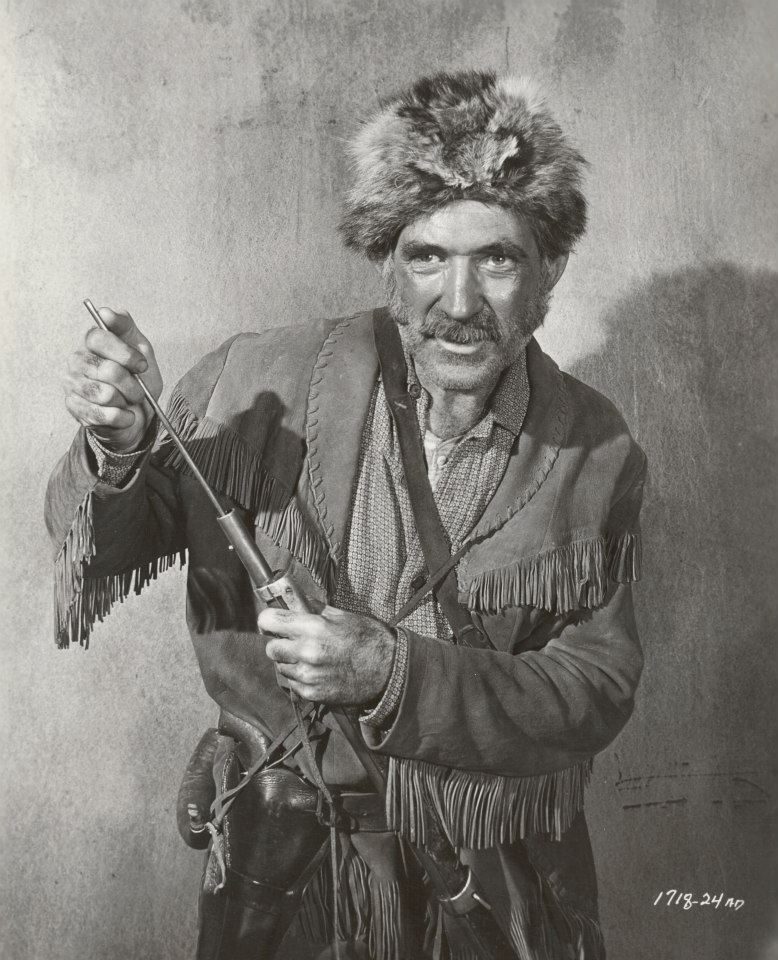
Trevor Bardette as Crockett, posing for a much bigger role than he ended up with. (Collection of the author) |
A new form of entertainment entered the lives of Americans in the late 1940s. Television started out as just a curiosity, with tiny black and white screens that flickered in and out of focus for just a few hours of broadcast material, mostly commercials, each night on a handful of stations. It was Uncle Miltie; It was the ABC Barn Dance; Let's Rhumba; Kukla, Fran and Ollie; Harmless fun. Why not eat your dinner around the TV and enjoy yourself?
Then in 1948, the TV networks began broadcasting nightly new shows right at dinner time, and the news wasn't good. Television suddenly got very real. What did those news shows broadcast images of? The Cold War. It was bad enough after the war reading about the commies in the newspaper, or hearing about Joseph Stalin on the radio — now he was right there in the living room on the TV, threatening the American way of life and spoiling your supper. Then, more bad news: In 1949 the Soviets had acquired atomic weapons. In 1950, Communist-supported North Korea invaded the UN-backed South Korea, and TV screens actually began broadcasting a war, right where your kids were sitting! Joint Chiefs of Staff Chairman General Omar Bradley warned against appeasement in a very Alamo-like fashion, saying that Korea was the place "for drawing the line" against communist expansion. Suddenly you might see the country's nuclear annihilation from what used to be the comfort of your living room.
If that wasn't bad enough, then Wisconsin Senator Joseph McCarthy unveiled a tiny piece of paper that he claimed contained a list of 205 known Communists working for the State Department, beginning a nation-wide communist witch-hunt. In 1953, you could turn on your TV and watch illustrator William Gropper testify before McCarthy and the House of Un-American Activities Committee. Gropper had allowed the State Department (which, remember, was full of commies) to distribute prints of his paintings of American Folklore, and one of the prints in the series was of Davy Crockett. McCarthy considered the work "subversive," and questioned why copies were kept by U.S. embassies abroad — McCarthy believed the pictures revealed valuable secrets to communists. To avoid self-incrimination, an incredulous Gropper pled the Fifth. Every day, McCarthy would unveil more secret lists of communists on TV — everyone from politicians, to entertainers, to your kids' teachers to... well, it was too horrible to think about.
The year 1954 arrived, and it was even more tense: Truman gave way to General Eisenhower, who proposed in his State of the Union address to deprive American Communists of their citizenship; In case people weren't sure what was at stake, Congress added the words "under God" to the country's 60 year-old Pledge of Allegiance to distinguish the United States from atheistic communism. Then the death of Joseph Stalin left a frightening power void in the Soviet Union, and out of it stepped Nikita Khrushchev, the shoe-pounding First Secretary of the Communist Party. An armistice ended three years of fighting in Korea with little gained and much lost; the hydrogen bomb was developed, because bigger had to be better, right? The TVs kept blaring the news. There was no escape.
So, needless to say, Americans needed some reassurance. They needed to be reminded that the country had been through all this before, that good would triumph over evil. That if you were sure you were right, you could still go ahead. America needed a hero.
At the start of the 1950's, David Crockett was a minor footnote in American history. His legend was relegated to Texas and Tennessee. The major book to that time about the age of Jackson, Arthur Schlesinger Jr,'s Pulitzer Prize-winning The Age of Jackson, referred to Crockett as a "picturesque if somewhat phony frontiersman," and little else. In film, he showed up as a minor character in movies like The First Texan and 1953's The Man From the Alamo, a conventional Western by Universal-International, in which Crockett (Trevor Bardette) is shown briefly as a generic officer in the Texas army at the beginning of the film (Bardette had appeared with John Wayne in the film Dark Command in 1940). There's no bragging, no joking — this Crockett is just a good soldier, doing what he's told and fighting for his life. The film goes on to tell a greatly fabricated version of the story of Louis Rose, the man who chose to leave the Alamo instead of fight. (So fabricated that they changed his name to "John Stroud.") It was a Cold War allegory, and a subliminal repudiation of McCarthyism (subliminally was the only way you could get away with it in 1953).
The Cold War would help Davy re-attain his legendary status the next year. But his public rehabilitation actually began in the late nineteen-forties — with a man named Walt Disney. With the nation just coming out of World War II, and Russia swallowing up Eastern Europe, "Uncle Walt" had just settled a bitter union dispute in his studio... and being a patriotic American, he blamed the commies for all of it.
So Walt joined the right-wing Motion Picture Alliance for the Preservation of American Ideals, a group of self-admittedly reactionary Hollywood Conservatives. Their Statement of Principles: "We believe in and like the American way of life." All they asked for was the freedom "to speak, to think, to live, to worship, to work and to govern ourselves, as individuals, as free men" and "the right to succeed or fail as free men, according to the measure of our ability and our strength" (i.e., dont ask us for any help). They added: "We have no new plan to offer. We want no new plan, we want only to defend against its enemies that which is our priceless heritage." Their main mission: To fight communism by promoting Americanism. (The president of the Alliance, John Wayne, would go on to play Crockett himself, one day.)
To Walt Disney, the best way to "promote Americanism," i.e., to instill pride and patriotism in the citizens of the United States, was to present America to itself, through the stories of its heroes. It was at least as early as the mid-Forties that Disney had considered using Crockett as the basis of some type of film. In March of 1946, Disney had met with famous Missouri painter Thomas Hart Benton to discuss an animated folk operetta about Davy Crockett. Benton worked with musicians on the project to develop a score and story for which he would "concoct and draw the characters." (Thomas Hart Benton, An Artist in America, 4th rev. ed.,University of Missouri Press, Columbia, 1983, p. 312) However, he recalled that there were "practical objections to all the ideas I dragged up." For instance, the ending would have to be "finessed" because Davy's death at the hands of the Mexican army might offend Latin Americans (Disney had been named a U.S. goodwill ambassador to Latin America during World War II, and was sent on a publicity tour to promote the "good neighbor policy" and discourage Naziism). After a few weeks at Disney Studios Benton withdrew from the project, and informed the studio that "Walt Disney's stuff is good enough for my money as it is without a lot of damn painters getting in it." Benton sold his interest in the Crockett project to Disney for three thousand dollars — a financial decision he came to regret.
Disney, however, was still considering it, despite his earlier reservations to Benton's project. A Walt Disney Productions story inventory report from 1947 included a rough outline for the Davy Crockett musical production. In 1948, Disney told Hedda Hopper (also in the Alliance), it was "time to get acquainted with, or renew acquaintances with, the robust, cheerful, energetic and representative folk heroes." But maybe because of the times, maybe because of the character's brash, cock-sure boastfullness, it would still take some convincing for Walt to try again with Davy. About six years worth...
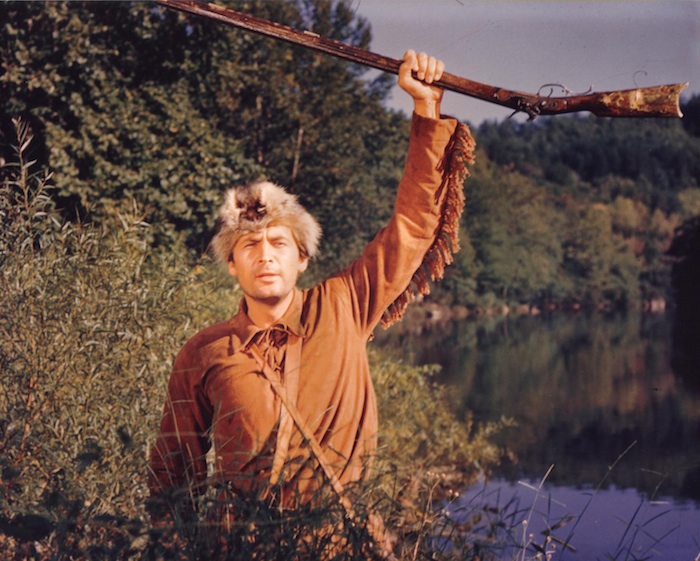
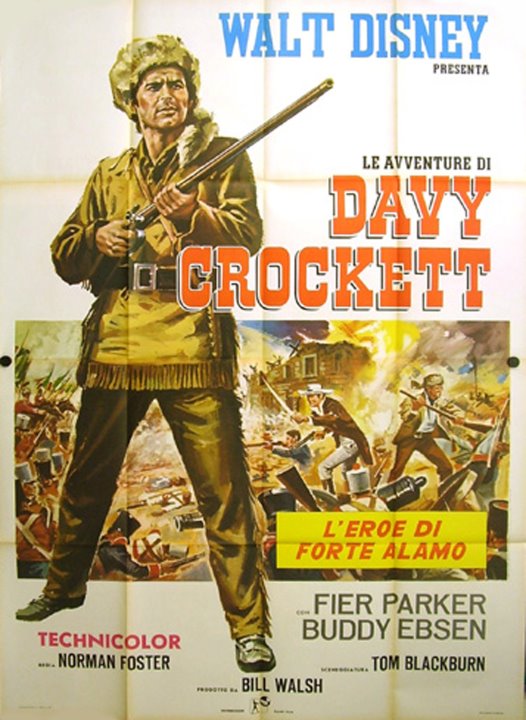
This is the Italian poster. Notice that Parker's first name is changed — probably because in the Italian language, "fesso" means "simpleton" — not a good name for a movie star! So they've renamed the actor "Fier Parker." (Fier was probably derived from the word "fiero" — which means bold, proud, or fierce.) Also notice that Fess is fighting alongside the cast of John Wayne's movie — not the Disney version. The film was released in Italy after Wayne's. (Collection of the author) |
In 1954, Walt got the idea to use television as a medium to promote Americanism, while advertising for himself! So he came up with the idea of producing a weekly anthology series for one of the TV networks that could advertise his theme park, opening the next year: Disneyland.
Davy Crockett — King of the Wild Frontier" was a Walt Disney production comprised of five one-hour TV shows that were also made into two theatrical movies, and made Davy a legend again. The five-part serial aired on ABC in one-hour episodes on the Disneyland series, starring Fess Parker as Davy Crockett and Buddy Ebsen as George Russell.⁵
It's even arguable that after the success of this Disney series, Crockett became more a symbol of the 1950's than the period when he actually lived. Today when somebody sees a coonskin cap, they are more likely to think of the Eisenhower administration than they are of Andy Jackson's.
"I've always wanted to do American history," Walt told Newsweek in 1955. "It's due. We have taken too many things for granted. I'm not really telling history, though. I'm telling about people; history happens to be going on at the time."
Immediately the Frontierland unit of the show began the search for an appropriate hero to kick off the series. But Walt was being very picky, and found many inappropriate. "I don't want any picked-over heroes," Walt emphasized to them. "There will be no outlaws or badmen glorified — no Jesse James or the Daltons."
The search went on for months, with no clear choice. Then before a meeting with the impatient Mr. Disney, the unit decided to just pick one — and looking back, completely lucked out. "We were planning to do a series on American folk heroes — like Johnny Appleseed, Daniel Boone, and Big Foot Wallace — and the first one we pulled out, by dumb luck, was Davy Crockett. At the time he was just considered one more frontiersman," Disneyland producer Bill Walsh remembered.
"What was both peculiar and significant about the Crockett craze was that it struck a resonant chord with both conservatives and liberals. The Disney version appealed because it represented so many things that both sides could rally around — nostalgia for a better time, national pride, heroic struggle in the face of dangers real and imagined, and values that Americans want to believe in — making it possible for either side to define those values and claim to be their true protector."
—"The Columbia Companion to American History on Film: How the Movies Have Portrayed the American Past," by Peter C. Rollins. Columbia University Press, 2003. |
When Disney was approached about making Crockett the subject of his first Frontierland series, he complained to a producer that, "All he did was fight Indians. How can you say anything new about that?" Bill Walsh remembered: "So we did some [story] boards on Davy Crockett — and may I tell you, we put everything but the kitchen sink in those boards. Like there was fighting the Indians, Seminoles down in Florida, fighting tomahawk duels with Red Stick. Then he went to Congress and raised hell, then he fought Andy Jackson who was doing something bad to the Indians and Davy stalked out of Congress because Andy Jackson was stealing from the Indians and he didn't want to hear about it. In fact, he fought Andy tooth and nail. Then he goes out west and had a lot of adventures going out west and he had a lot more Indian fights there. Then he got into trouble with the Cowboys — early Texans — and then got to the Alamo and then he lasted through the Alamo for fourteen days — and the last day they broke the joint wide open. He died as he had lived, swinging his rifle around, and there was this pile of 17 dead Mexicans piling up in front of him. Walt looked at all of this, and he said — I'll never forget his classic line — 'Yeah, but what else did he do?' That's when Norman Foster [the director] fainted dead away."
But Walt relented, and the more the story men researched Crockett, the more they realized they had chosen right: There were so many legends created about him through books and almanacs, told in so many different ways, and in so many differing versions, that it was easy to pick and choose the "facts" that fit their particular vision, and mold whatever story they wanted.
When they finally got the okay, next came the argument of presentation. Buddy Ebsen recalled that Walt still wanted to do it at as a cartoon, but then "I think he found out it was cheaper to do with live actors." Director Norman Foster recommended Ebsen to play Crockett. Walt had worked with the actor before, and had all but agreed... until he saw the B-film, Them! The staff was pushing for an actor featured in the film, named James Arness (who would go on to star in the TV series Gunsmoke), but Walt noticed a 6'5" southerner in the cast named Fess Parker, playing a small role as a pilot put into an insane asylum after claiming his plane had been downed by giant flying insects. Arness appeared in a larger role in the same film. Legend has it (and this is a book about legends) that Walt exclaimed, "That's Davy Crockett!" as soon as Parker appeared onscreen.
Disney was impressed by Parker's portrayal of a man who was unswerving in his belief in what he saw despite the forces of authority against him, and Parker was asked to drop by the Disney Studio. When he did, he brought his guitar, met Walt, sang a song, and then said his goodbye. A couple of weeks later he was told that he had been selected over Arness and several other actors considered for the role. Buddy Ebsen had lost the lead, but he eventually was hired to play Crockett's friend, George Russell.
Fess Parker was born in Fort Worth, Texas, and grew up on a farm near San Angelo. He enlisted in the U.S. Navy in the latter part of World War II, hoping to become a pilot. He was turned down because he was 6 feet 6 inches (1.98 m). He then tried to become a radioman gunner, but he was found too big to fit comfortably into the rear cockpit. He was finally transferred to the Marine Corps as a radio operator and shipped out for the South Pacific shortly before the atom bomb ended the war.
Discharged in 1946, he enrolled in the University of Texas on the GI Bill. He was stabbed in the chin by a drunken driver during a post-collision argument. He required many months to recover, and was unable to participate in sports as he had wished. Parker graduated from the University of Texas in 1950 with a degree in history. He had been initiated into the Pi Kappa Alpha fraternity. Having one year remaining on his GI Bill, he studied drama at the University of Southern California, working towards a master's degree in theater history.
Parker began his show-business career by summer 1951 when he had a $32-a-week job as an extra in the play Mister Roberts, although he is credited with the voice of Leslie, the chauffeur, in the 1950 film Harvey. Within months, he was on location with a minor part in Untamed Frontier with Joseph Cotten and Shelley Winters.
Parker became a contract player with Warner Brothers appearing in small roles in several films such as Springfield Rifle (1952), Island in the Sky, The Bounty Hunter and Battle Cry. In 1954, he appeared as Grat Dalton in the Jim Davis western anthology Stories of the Century in the episode "The Dalton Brothers."

The entire Davy Crockett story (at least the first Disney series) is framed by two wars, and the opposing side is never clearly defined in either case, so Cold War allegories were easy to draw. It was a patriotic time, as a month before the show's premiere President Dwight D. Eisenhower dedicated the USMC War Memorial (Iwo Jima memorial) at the Arlington National Cemetery. It was also a prosperous time, as the Dow had finally surpassed its peak all-time level, reached just before the Wall Street Crash of 1929. People had more money for entertainment like television (and as Walt was to find out in merchandizing his Davy Crockett shows, more money to spend on toys for their children).
The episodes were filmed in color on location at the Great Smoky Mountains National Park, the Hermitage (Andrew Jackson's residential mansion), and the State Capitol building in Nashville. Tennessee legislative chambers doubled for the United States congress as it appeared in 1827. In his autobiography, The Other Side of Oz, Ebsen recalled the hazards of making the show because the Disney studio was accustomed to animation and naive about live-action filming. The stunt man sent to double for Parker and Ebsen was 5-feet, 5-inches tall while the two stars topped six feet. As a result, the two men were forced to do their own stunts. "In the course of filming," Ebsen wrote, "I figure I qualified for four Purple Hearts. The most dangerous incident involved a muzzle-loading musket, which blew up in my face. In the explosion and flash, I lost my eyelashes, my eyebrows, and a good patch of my front hairline." Ebsen and Parker would remain lifelong friends.
Ebsen hadn't been cast as Crockett, but in truth he still ended up playing a part of Davy, whose character was evolving yet again to fit the times. Walt wanted a heroic, soft-spoken man of action as his Davy, and the real Crockett was anything but soft-spoken. The solution in this story was for best friend "Georgie" to do the bragging while Davy lets his fists and guns do the talking. This way, Walt gets his tight-lipped Cold War hero while Davy still becomes famous for grinnin' down a bear and other outlandish stories.
The series began with Davy Crockett, Indian Fighter (53:40, December 15, 1954). When the Creek nation declares war on settlers, Davy Crockett volunteers as a scout for the army and leaves Polly⁶ and his two sons behind. Crockett and Russell fight in skirmishes under the command of General Andrew Jackson (Basil Ruysdael). "Four thousand Cherokees, descendants of braves who refused to be dispossessed by white man's law in 1837, still live in the Great Smokies. Nearly 200 of them agreed to play Creeks for Indian battle sequences in the color spectacle... In exactly an hour, almost 200 civilized Cherokees were transformed into savage Creeks," trumpeted the Disney press release. Along the way, Crockett tries to grin a bear to death, then finishes him off, armed only with his knife. He tries it again on Chief Red Stick, to less success, leading up to a one-on-one tomahawk fight climax — Crockett is literally fighting for peace at the end of the show, in the best Cold War lingo — and once he gets the upper hand, he negotiates a truce with Indians.
Many sources were used to create the teleplay, but the model seemed to be the book Davy Crockett, by Constance Rourke — an ingenious biography that was written as a folktale, seemingly recounted from many sources. This allowed the legendary Davy and the factual David to comfortably occupy the same stories. Disney achieved this same effect by taking a fellow soldier in the Creek War, George Russell (two l's in real life, one in the Disney series), and enlarging his character as a permanent sidekick.⁵ Georgie is the one who brags about Davy, who just makes sure he's right and goes ahead. This allowed Crockett to be more of a noble savage, like the Davy in the Mayo play that Walt may have watched as a boy, and still incorporate the traditional legends of grinning animals to death, etc., that made Crockett famous in the previous century, as told by Georgie.⁵

Perhaps the least discussed installment of the series is Davy Crockett Goes to Congress (53:39, January 26, 1955) — but it may have been the most important, if you look at the social and political context when it aired. Just the month before (December 2, 1954), the Senate had voted to condemn Senator Joseph McCarthy — who had been on a communist witch hunt for the previous five years — by a vote of 67 to 22 for "conduct that tends to bring Senate into dishonor and disrepute." This all made a literal straight shooter in Congress, above the backdoor deals and lies of career politicians, all the more appealing. Westerns were popular on TV at this point, but few had ever been so socially relevant. The Nielsen ratings estimated that nearly half of all television viewers tuned into Davy Crockett Goes to Congress. Those viewers saw a humble, illiterate Crockett enter politics soley to help the unfortunate (as represented by a poor Native American family driven off their land by opportunists), and gain national notoriety as he "patched up the crack in the Liberty Bell." They even saw President Jackson threaten Crockett with his Congressional career for opposing his wishes, but Davy — unswayed by threats — spoke out against Jackson's evil Indian removal bill, and promptly quit politics (or he was ousted, which the episode didn't make clear), storming out of the Congress. Of course, the real Crockett did oppose the bill, but he tried to hide it from voters in the next election — because not only were they pro-Jackson in Tennessee, they were also still waiting for Crockett's long-delayed land bill to pass, and wanted those cheap Indian lands for themselves. Those voters were promptly informed by Jackson of Crockett's opposition to new land, so they promptly voted Crockett out of office. Still, the point of the Disney episode was that Crockett stood up for what he believed, no matter the political fallout. The brilliance of Disney's presentation of the story was that both sides of the McCarthy controversy could side with Davy! Walt probably sided with McCarthy, himself, but viewers could also imagine Davy standing up to a Congressional Committee and telling them to go to Hell while he would go to Texas. It struck a chord because of people's uneasiness with the politics of the time, on both sides of the aisle (and still does).
The success of the Crockett episodes took Walt and everybody at the studio by surprise. Crockett producer Bill Walsh expressed the feeling of astonishment in a Disney publicity memo, "ABC couldn't believe it. Parker couldn't believe it. Neither could Walt nor I. After the second episode aired in January 1955, there was no mistake. We had a hit show." Disney inadvertently, in an attempt to entertain both parents and children as he did with all of his varied entertainments, had created television's first adult western. It had shootouts and fistfights like all of the other westerns on TV, but the locations were real instead of cheap studio soundstages. The issues seemed more real, too, because the shows dealt with contemporary topics like corrupt politics, expansionism, manifest destiny and racism. Just as important, by showing audiences that it had all happened before, it reassured audiences that it would all turn out okay, once again... at least until the next episode. Davy was a forgotten hero before these shows, so nobody outside of Texas in 1954 was really thinking about a former mission, army supply building and general store in San Antonio called the Alamo.
By February of 1955, the mood hadn't lightened since the last installment of the Crockett series. With McCarthy disgraced, the worry wasn't that the Communists were inside the walls so much anymore, as that they were outside and had the United States surrounded. The Cold War was still the main story, and the news from around the world revealed that it was only going to get chillier. In late January, the Pentagon announced a plan to develop intercontinental ballistic missiles (ICBMs) armed with nuclear weapons. This came days after the Chinese Communist People's Liberation Army had seized the Yijiangshan Islands from the Republic of China, now isolated to Taiwan, and the British cargo ship Edendale was sunk in an air raid at Swatow, China. On February 10, the United States Seventh Fleet helped the Republic of China evacuate the defeated Chinese Nationalist army and residents from the Tachen Islands to Taiwan. The Commies were making strides everywhere, and those strides were getting quicker, to the point of running. On February 12, President Dwight D. Eisenhower sent the first U.S. advisors to South Vietnam. Amid the chaos and tension of the outside world, the third episode in the original trilogy, Davy Crockett at the Alamo (53:20, February 23, 1955) had Davy and Georgie reunited as they entered a foreign country to help "Americans in trouble." They are joined by a riverboat gambler named Thimblerig and in Texas by an outcast Indian called "Busted Luck," and they all die for freedom in a church on the frontier when overwhelmed by a faceless, ruthless enemy. So while the episode probably didn't reassure viewers that everything was going to be okay, it did reinforce the idea that they were on the right side.
The Alamo mission itself was built on "one of the largest indoor sets ever designed," according to the Disney press release. "It was a full scale replica of the Alamo. The set occupied an entire sound stage at Walt Disney's studio and was built from contemporary pictures of the historic fort as it looked in 1836... Roughly the size of a football field, the mammoth set trembled to the gunfire and cannonading of 200 actors playing American volunteers and Santa Anna's soldiers." Davy and company arrive to battle General Antonio Lopez de Santa Anna's army at the fortress, which is now an enlarged version of the fort's chapel. Crockett's death is not actually shown; all we see is Davy, the last survivor in the battle, on the parapet swinging his rifle at the oncoming hordes of Mexican soldiers. The picture fades and the flag of Texas is shown flying in the breeze as the male chorus reprises the last lines of The Ballad of Davy Crockett. "They were ready to have Davy die onscreen," according to Parker. "But the Disney people at the last minute, worried about the impact his dying might have on all the young children, decided to modify the ending." So instead of a death scene, kids saw Davy swinging Old Betsy, as the visuals faded out. The significance of that change is still felt today, as witnessed by the vitriol and anger whenever a historian suggests that Crockett surrendered.
When Colonel Travis drew a line in the sand with his sword for the defenders to cross as a commitment to die for freedom, it was no longer a fable. It now had a corollary when General Omar Bradley said the U.S. had to "draw the line" against communist expansion and commit to war when North Korea invaded South Korea in 1950. So when Travis drew a line in the sand with his sword, Davy crossed that line to help "Americans in trouble." The line had taken on a new meaning that even kids could feel. Roberts and Olson called it, "the event that transformed it from a Texas shrine to an American one." Instead of being a beaten Congressman who left the U.S. to buy land in Mexico, Davy is a noble adventurer fighting for freedom. In fact, you'd never know Texas was in Mexico in this film. (From the tone you'd think the Mexicans had invaded OUR country!) But this is Disney myth-making at its finest. The Alamo is now built around the chapel— in other words, the entire Alamo is a chapel — Crockett and company aren't only defending "Americans," they're defending religion, the bedrock of American society in the 1950's (nobody took into account that the Mexican army was full of Catholics).
Americans could also identify with the Alamo metaphorically. As James McEnteer wrote, "Cut off from reinforcements, surrounded and outnumbered by a treacherous enemy, the besieged men of the Alamo provided a fitting dramatic metaphor for Fortress America, holding out almost single-handedly against the godless, soulless, malignant tide of communism," adding that Americans "built underground bomb shelters equipped with food and water and varying amenities where a fortunate few hoped to outlast the ravages of atomic attack in their own private Alamos."
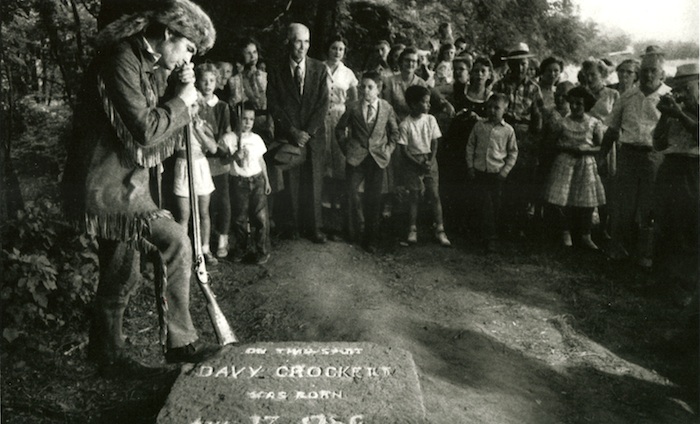
The Morristown site of backwoods boaster and "ring-tailed roarer" David Crockett's birth becomes a setting to celebrate his re-birth as a noble, humble, soft-spoken frontier hero — which in truth was closer to Fess Parker's character than it was to the real Crockett's.
The merchandising aspect of the fad was astonishing — it also provided much needed capital for the Disney Studios. Time Magazine reported that in the first three months of the craze alone, over $100,000,000 of Crockett merchandise was sold. When it was over, an astronomical $300,000,000 in Crockett commodities was sold. Compare this to the previous Hopalong Cassidy craze in 1950, which did a grand total of just $1,000,000 in merchandise sales. Bob Thomas in Walt Disney: An American Original, called it "the greatest merchandising sweep for any national craze, before or after."
The social and political climate of the 1950s certainly played a major role in its success. The fear of Communism had people's patriotism at a fever pitch. It is likely that the show intensified these feelings. With the tensions of the Cold War, even children were receiving large portions of Americanism in the schools. The Pledge of Allegiance, air raid drills, anti-Communist assemblies, and nuclear safety training were all commonplace in the 1950s. Margaret King, in her doctoral dissertation on the Crockett craze, intimates that Davy's appeal "might have been the direct result of the general feeling of the time that what the country needed in the face of the Red Scare was deeds instead of words."
The Craze's timing coming after World War II could not have been better. Economic growth was surging and there was a new abundance of consumer products. This new attitude of "consumerism" fueled the fire when it came to the Crockett merchandise. Furthermore, all of the post-World War II babies-now called the "baby boomers" — were just coming into the prime age group for the Crockett series.
On February 26, 1955 Columbia Records released "The Ballad of Davy Crockett" sung by Bill Hayes (who had been a singer on Your Show of Shows). Fess Parker's version was released on March 12, 1955. Yet another version, this one by Tennessee Ernie Ford, was released on March 19, 1955. All three versions would reach the top ten of the Billboard singles chart. Bill Hayes' version went all the way to #1, where it remained from March 26 to April 23. Fess Parker's version topped out at #6. Tennessee Ernie Ford's version peaked at #5.
Of course, by this time Walt Disney had realized he had made a big mistake, and attempted to continue the series. Historian Margaret J. King quotes him as having said, "It became one of the biggest overnight hits in television history and there we were with just three films and a dead hero." Sometime around February 26, 1955, Disney announced the three Davy Crockett episodes, broadcast in black and white on TV, had been edited together in color to make a 93-minute theatrical film, Davy Crockett, King of the Wild Frontier. The new assemblage was released in the United States on May 25, 1955. Seeing the film in color was enough of a draw for audiences to spend another $1 million at the box office, despite the fact that over 50% of the U.S. had already seen it on TV. (It probably also helped that none of the promotional material for the film, gave any indication that it was a compilation of television episodes.) While the episodes were filmed in color for future small-screen television broadcasts in an era of black and white, it wasn't filmed with the intention of audiences scrutinizing the images on a 40-foot theatrical screen. As the camera scans across the river from where Andy Jackson's army is camped, a contemporary house can be seen in the background. Likewise, when Davy and George discover a Native American family hiding in the bushes after their land was taken away, freeway traffic is visible in the top left corner of the screen.
On July 17, 1955, the opening of Disneyland was covered on a live television special, Dateline: Disneyland, which is not technically considered to be part of the series. It was hosted by Walt along with Bob Cummings, Art Linkletter, Ronald Reagan, and featured various other guests, and segments like one speculating what the world would be like in 1986 in Tomorrowland (not too close to the truth, as it turns out). All along the way, kids tell the host, "Where's Davy Crockett?" Finally, Davy and Georgie showed up at the opening of the Disneyland amusement park to sing "Old Betsy" live.
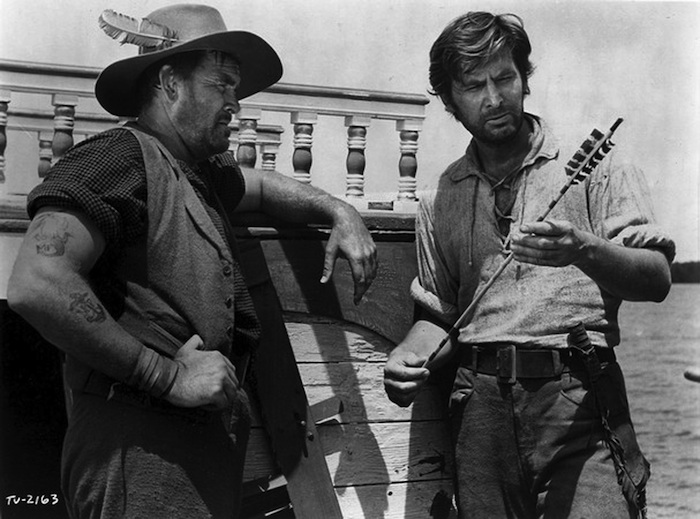
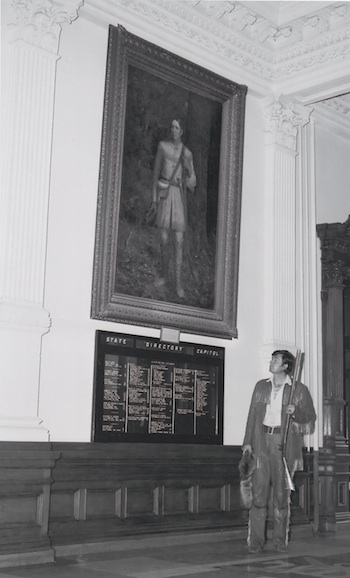
Davy meets David at the State House in Austin, Texas. (Collection of the author) |
The next episodes were far different in tone than the earlier three — Walt explains at the beginning of the show that these are legends about Davy Crockett, not biographical fact. In Davy Crockett's Keelboat Race (53:39, November 16, 1955), Crockett and Russell are fur trapping in Kentucky when they meet Mike Fink (Jeff York), a boisterous and pompous boatman and the self-proclaimed "King of the River." The real Mike Fink (also spelled Miche Phinck, b. 1770/1780 - c. 1823) was a 6'3", 180-pound braggart, brawler and keelboat-man who became famous by way of folk tales and almanac stories, just like Davy. In fact, Fink's character here is sort of like the legendary Davy of the early 19th Century — It's almost as if the Disney Crockett is battling the old, legendary Crockett of the Almanacs. In the story, Fink challenges Davy and Georgie to a race. As the opponents make their way down the Mississippi River, aggressive competition ensues, filled with sabotage and battles of wit. There's more comedy, and characters even burst into song! Kenneth Tobey, who played Jim Bowie in the much more serious "Alamo" segment, is back as comic relief in the form of "Jocko." The real Fink fled civilization after the demise of the keelboats and drifted west to the Rocky Mountains. According one account, Fink was killed in retaliation after fatally shooting a trapper friend while aiming at a mug of beer placed on top of his head. The Disney Fink, however, stayed on the river for more adventures with Davy... namely Davy Crockett and the River Pirates (54:09, December 14, 1955), which earned an Emmy nomination for Best Single Program of the Year. The story picks up almost right where the last left off, with Davy and George making peace with Mike Fink, and banding together to bring justice to a group of bandits who pretend to be "redskins." This prequel features Western staple Mort Mills as Samuel Mason, another true historical figure who was a frontier militia captain during the Revolutionary War and became the leader of the Mason Gang, a notorious gang of river pirates on the Ohio and Mississippi rivers. It sets Mason as a central antagonist in Crockett's frontier adventures, but in reality they never actually met (Mason died in 1803, when his severed head was presented to the territorial governor to claim the reward money for his capture). Anyway, the fictionalized Davy and fictionalized Fink battle the fictionalized Mason Gang (which includes fictionalized versions of the first known serial killers in America, Micajah and Wiley Harpe, also dead by 1804. Wiley was actually the one of the guys who presented Mason's severed head for the reward money, but was instantly recognized, hanged, and also beheaded). Anyway, back to fiction: Davy and Fink have to stop the disguised pirates before they start a conflict between the Native Americans and White settlers. Serial killers, head severing — sounds fun, right? Well, in the Disney universe they all have a rollicking good time together.
Disney then paired this second series of Crockett shows as another film, released on July 18, 1956, but the second theatrical feature not as successful as the first. Kids were probably less excited after having just watched Davy die at the Alamo a few months earlier. (Kinda' takes the fun out of a whacky river race... It was like telling one silly anecdote too many at a memorial service.)
Then, just as suddenly as it had started, the hysteria seemed to fizzle out. "A fad disappears when its function has 'functioned' long enough. When almost every child had his cap, rifle, powder horn, book and record," says Sociologist Paul Lazarsfeld. "Then most children aren't impressed with these things any more. The more pressure behind a fad the more quickly it'll run out."
"Manufacturers were shipping Davy Crockett items as fast as they could make them," claimed Jerome Fryer, President of the Toy Manufacturers of the USA. "Then one Monday morning the phone stopped ringing and the orders stopped coming. Don't ask me why everyone picked that day. They just did." The craze had ended. Whether it was a sudden decline, as Fryer's comment suggests, or a gradual decline, is open to debate.
Buddy Ebsen remarked, "It was like a skyrocket, it goes up and it comes down. But I, from the comments I get from people, think it's still alive." Fess Parker agrees, "What happened was that the show was an instantaneous hit in December. And there were only two one hour shows after that and they were spread over the next four and a half months — and reprieved. So it was on television twice over a six month period. Then we went into the theaters as a first run picture. And while that was happening, we made two more hours which was shown the following year — and then reshown — and then went into the theaters the next season. So there was about two years, I agree a diminishing trip, but it extended for a long, long time."
Fess Parker appeared as Crockett again — briefly — in Alias Jesse James (1959), a Bob Hope spoof of westerns in which Hope plays an incompetent insurance salesman who sells a policy to Jesse James. Fess Parker shows up as Davy for a sight gag, with Buddy Ebsen returning as Georgie Russell. Bob is in a climactic showdown at the end of the film. He receives help from a number of "friends," including James Arness as Matt Dillon, Hugh O'Brien as Wyatt Earp, Fess Parker as of course, Davy Crockett.
Fess played Davy for the last time in 1970, in a skit on the Red Skelton Show called "He Died with His Boots on Cause He Had Cold Feet to Start or He Died with His Boots Off, That's Why He Stubbed His Toe." Parker revived his Davy Crockett characterization in a dream sequence wherein Clem Kadiddlehopper (Skelton), a soldier at the Alamo, helped Davy spy on Santa Anna.
In 1963, the Davy Crockett mini-series was rerun on Disney's Wonderful World of Color. Finally shown on TV in color, it was a hit again. It was while he was on tour with the musical Oklahoma that Fess Parker noticed an increase in the number of autograph seekers and found out that the mini-series had been rerun.
Seeking to capitalize on the newfound popularity of Davy Crockett, Parker approached producer Aaron Rosenberg about a new Davy Crockett series. The two sought permission from Disney to use the "Davy Crockett" name, but Disney refused. Realizing that as a historical figure Davy Crockett was in the public domain, they sought to go ahead with the series anyhow. Unfortunately, neither Lloyds of London nor Fireman's Fund would insure them against lawsuits from Disney.
It was then that they decided to base their new show around another historical frontiersman, Daniel Boone. Daniel Boone, starring Fess Parker in the title role, debuted in 1964, effectively confusing that frontier icon's legend with Crockett's for an entire generation. Over the show's six years (1964 to 1970) it was one of the highest rated series of its time, Parker was not only the star, but also the co-producer and director of five of its most popular episodes.

Arthur Hunnicutt as Crockett: "My friends and constituents: I left Washington and the United States Congress some time ago at the request of a gentleman who had the gall to call himself Andrew Jackson. But his real name, as most self-respectin' Indians know, is the fellow who got the whole thing bollixed up. Anyway, in Washington they told me to either go to Hell or Texas, so naturally, not wantin' to be took for a coward, I chose Texas. Lookin' over your territory as I come, I want to tell you I think you found somethin'. I don't know what it is, but it sure is full of space. Only thing, a few more people is needed. Men like you could solve that problem in no time at all. But I hear there's another man here who's agin' other people bein' here, a certain general called Santa Ana. Seems he wants to make it a game preserve for coyotes. And from what I hear'ed, we might have a run-in, iffin he don't scare me off."
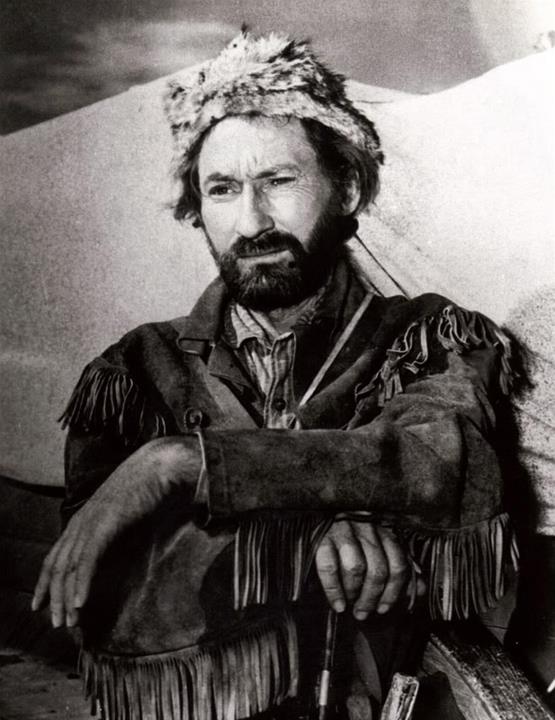
Arthur Hunnicutt ponders the royalties he's lost playing Crockett a year too late in "The Last Command." (Collection of the author) |
John Wayne is actually responsible for two of the most important Alamo movies. The first was with Republic Pictures, and was eventually called The Last Command. In 1946, Wayne decided to make a movie about the battle of the Alamo while under contract with Republic Pictures. He hired James Edward Grant as the screenwriter, and the two began preparing a script. As it neared completion, Wayne and the president of Republic Pictures, Herbert Yates, clashed over the proposed $3 million budget. (Other sources claim that Wayne hesitated working again with Yates' Czechoslovakian wife, actress Vera Ralston, as his love interest in the film — Wayne had a bad experience working with her in 1945's Dakota).
Wayne left Republic over the feud but was unable to take his script with him. That script was rewritten and made into this film, while Wayne and Grant made their own version of it a few years later.
Yates put The Texas Legionnaires (as it was then known) into production right away; the script, based on Grant's work, was by Sy Bartlett and Warren Duff. It was the last screenplay by Duff (Angels With Dirty Faces, 1938) before he made the move to TV. Yates then brought in Oscar-winning director Frank Lloyd (Mutiny On The Bounty, 1935), who had just come off a ten-year hiatus with The Shanghai Story in 1954. For music, he hired Max Steiner, who created the themes for Gone With the Wind (1939) and Casablanca (1942) among others. By hiring talented, reliable and experienced (over the hill?) talent behind the camera, Yates kept the budget low, but it looked and sounded lke a major studio release.
Released during the Walt Disney Davy Crockett frenzy, the film follows Jim Bowie (Sterling Hayden) who was initially a friend to Generalissimo Antonio López de Santa Anna (J. Carroll Naish) but sides with the Texians in their bid for independence.
When Texas is threatened by the armies of Mexican general Santa Ana (J. Carrol Naish), Bowie at first adopts a policy of peaceful coexistence. When this proves impossible, Bowie joins Davy Crockett (played as an irascible old cuss by Arthur Hunnicut) and the rest of the courageous defenders of the Alamo.
Sterling Hayden, fresh from the cult classic Johnny Guitar, and a featured role in Fox's lavish Prince Valiant, signed to play Jim Bowie ("I needed the money to refit my boat," he joked). In reality, his career was in trouble. o But after just two film roles, he left Hollywood and joined the Marines as a private, under the name "John Hamilton" (a pseudonym Hayden only used in the military). While at Parris Island he was recommended for Officer Candidate School. After graduation, he was commissioned a second lieutenant and was transferred to service as an undercover agent with William J. Donovan's COI office. He remained there after it became the OSS.
As OSS agent John Hamilton, his World War II service included running guns through German lines to the Yugoslav partisans and parachuting into fascist Croatia. Hayden, who also participated in the Naples-Foggia campaign and established aircrew rescue teams in enemy-occupied territory, became a first lieutenant on September 13, 1944, and a captain on February 14, 1945. He won the Silver Star (for gallantry in action in the Balkans and Mediterranean; "Lt. Hamilton displayed great courage in making hazardous sea voyages in enemy-infested waters and reconnaissance through enemy-held areas"), a Bronze Arrowhead device for parachuting behind enemy lines, and a commendation from Yugoslavia's Marshal Tito. He left active duty on December 24, 1945.
His admiration for the Communist partisans led to a a brief membership in the Communist Party. But later, Hayden named names before the House Committee on Un-American Activities (HUAC). As the Red Scare deepened in U.S., "he cooperated with the House Un-American Activities Committee, confessing his brief Communist ties" and 'naming names'. His wife at that time, Betty de Noon, insisted that the 'names' her ex-husband provided were already in the hands of the Committee, which had a copy of the Communist Party's membership list. In any event, Hayden subsequently repudiated his own cooperation with the Committee, stating in his autobiography, "I don't think you have the foggiest notion of the contempt I have had for myself since the day I did that thing." Hayden said he took the part in this "flag-waver" to compensate for his liberal reputation.
Arthur Hunnicutt is terrific as Davy — he does a good job portraying an eccentric backwoodsman... but who would have voted this guy into Congress??? His scenes are great however, and many mirror the later Wayne film, including Crockett riding with a companion he calls "The Parson" and even using a torch to blow himself and his attackers up in a powder magazine.
Richard Slotkin, author of one of most respected books ever on the frontier myth, Regeneration Through Violence: The Mythology of the American Frontier, 1600-1860, said: "I guess in terms of literal accuracy, the thing I like best is the representation of Davy Crockett, who comes on as a kind of a mixture of the genuine and the bogus. He's a showman. He's playing Davy Crockett in the movie — and that's the real Davy Crockett. He was a kind of self-invented character — a kind of political showman. And the speech he makes and the way he presents himself strike me as a really good, really accurate portrayal of Davy." (from an interview for Movies in Time on the History Channel).
Variety: "The battle of the Alamo is fought again in The Last Command to secure a decisive b.o. victory for Republic in the outdoor and action markets. Story, performances, marquee and production values all combine to give that studio one of its better films of the year."
The August 3, 1955 world premiere in San Antonio was marked by a wagon train that traveled there from Bracketville, Texas, where the film was shot. (San Antonio Express, Thursday, July 27, 1955) The wagon train left the previous Sunday, led by trail boss Happy Shahan, who would have an entire Alamo built on his ranch five years later for John Wayne's film. Ben Cooper, an actor in the film, was part of the procession. (San Antonio Express, Tuesday, August 2, 1955)
Yates attended the premiere and presented the DRT with a check for $1000, which he then matched with a personal check. (San Antonio Express, Thursday, August 4, 1955) Also attending the premiere were Lloyd, Hayden, Carlson and Alberghetti.
John Wayne later told Hedda Hopper that although Yates had tried to, "steal the idea... (He) came up with The Last Command which was a quickie. Enough said." By the end of the decade, Yates would lose his studio, and Wayne would make his own version of the Alamo saga — and he'd steal Yates' idea of filming in Bracketville.
Wayne apparently didn't hold any grudges against Hunnicutt, who played his sidekick in El Dorado (1966), directed by Howard Hawks. In another Crockett connection, Hunnicutt also appeared in Fess Parker's TV series Daniel Boone as "Gabe" in the episode "Run a Crooked Mile" on 20 October 1966 (Season 3, Episode 6).
"Children don't select their heroes on the basis of the exact historical record. And who can say that Daniel Boone is any more real an American hero than Pecos Bill or Paul Bunyan or Huckleberry Finn? It is he who makes the hero real, who by some childhood magic can turn a stick into a horse. The real hero is not Davy Crockett or Galahad, it is himself."
—Colliers |
It was about this time that a Davy-backlash began. The New York Post launched an "idol-smashing" campaign led by its labor columnist, Murray Kempton, in an editorial called "The Real Davy." Kempton's barrage pointed out apparent inaccuracies: "He met his first bear at age of 8," not 3; he claimed Old Betsy "was a Republican campaign contribution"; and called Davy "a fellow purchasable for no more than a drink." Harpers and Saturday Review also joined in the heated debate; running articles with titles like, "The Embarrassing Truth about Davy Crockett" and "The Two Davy Crocketts." Most concerned Davy's moral character and were alarmed at the differences between actual history and the mythic version.
A host of allies sprung to Crockett's defense. Children and their parents picketed the editorial offices of The New York Post. They wrote letters to Harper's and Saturday Review, expressing their disapproval. One such letter to Harper's, concerning the article "The Embarrassing Truth About Davy Crockett," was from a 12-year old girl. She contended that the article was "dangerous." It seems that she had read it to her boy friend "and was barely halfway through when he gave me a crack on my shins with old Betsy and then hit me across my nose with his coonskin cap."
The Communist Worker, which defended Davy, saying, "It is all in the American democratic tradition, and who said tradition must be found on 100 per cent verified fact?" On the other side of the political spectrum, William F. Buckley, on his State of the Nation show on the Mutual Broadcasting Company, exonerated Crockett, too. "The assault on Davy is one part a traditional debunking campaign," Buckley commented, "and one part resentment by liberal publicists of Davy's neuroses-free approach to life. He'll survive the carpers." (And he did.)
"One night in Tennessee, long, long ago,
Two men made history;
Fearless men who would meet again,
At the siege of the Alamo,
Davy Crockett met Jim Bowie
Long, long ago..."
—"The Adventures of Jim Bowie: A Night in Tennessee," Episode 34 |
The Crockett backlash also appeared on TV, in a series called The Adventures of Jim Bowie. This TV show was a 30-minute western action series on ABC about Jim Bowie (British actor Scott Forbes), based on the book, The Tempered Blade, written by Monte Barrett. "His blade was tempered and so was he," as the theme song bragged.
In this series, Bowie is a wealthy landowner living in the Louisiana Territory around 1830, uncovering evil slave smugglers and searching for treasure (in reality he dealt in land-swindling and slaves, and at his death his entire estate was valued at $99.50). It's explained that Bowie developed the "Bowie Knife" after he nearly died in an encounter with a grizzly bear when his flintlock jammed (in reality he killed a sheriff). Each week, Bowie met well-known figures such as Johnny Appleseed, Sam Houston (Denver Pyle, who would go on to play Thimblerig in John Wayne's Alamo movie), Andrew Jackson, the pirate Jean Lafitte... and, even though they didn't really meet until the Alamo siege, Davy Crockett. Crockett in this show is unlike any previous filmed representation: a total politician, and a loudmouth (meaning it was probably the closest yet to the real man in 1835). It was a new phenomenon to have one TV show that whitwashed a historical character attack another TV show for whitewashing a historical character, but at least it was entertaining.
The 34th episode, "A Night in Tennessee," was broadcast during Season 2 on Friday, April 25, 1958 on ABC. The Announcer begins: "This is the story of two American heroes who died side by side at the Alamo. It is not the record of their last hours of glory. Rather, it is the account of their first meeting, one night in Tennessee: Davy Crockett and Jim Bowie."
The show opens at night in Tennessee, as Bowie ties up his horse and enters a tavern, where a political meeting is taking place — in fact it's been going on for days, according to the tavern keeper. Bowie notices the tavern keeper is reading Davy Crockett's autobiography. "Biggest pack of lies I've ever read — why, he kills a bear on every page," laughs the tavern keeper.
Bowie steps over to the bar as a bragging loudmouthed man in a coonskin cap sitting at one of the restaurant tables is railing against "King Andrew." He says, "People in New York ain't used to my kind of talk, but I said it anyway. 'Ladies and gentlemen,' I sez, 'Get this straight. Now I'm not a man to sneeze when another man takes snuff. Even if that man is king Andrew the First of these United States."
Bowie asks whom this "King Andrew" is, and another man at the bar says the braggart is talking about Andrew Jackson, and, "He's been goin' on like that for days."
"And nobody's done anything about it?" the offended Bowie asks.
"Not so far," says the man at the bar, who calls himself Perky.
The braggart then begins to rail against Jackson's "flying Dutchman," Martin Van Buren. "Jackson's bad enough, but Martin Van Buren? Holy Catfish!" The men at the table all laugh as Bowie winces.
"Isn't there some way to shut that fella up?" Bowie asks.
"He's too much for me — that's Davy Crockett," is the answer.
Crockett (George Dunn) and Bowie definitely don't hit it off. Crockett tells the group he'll go to Texas if Jackson's machine wins the next election, and Bowie tells Crockett that he electioneered for Jackson. The argument then dissolves into a shooting match (or a rifle vs. Bowie Knife match) inside the tavern. Crockett shoots with his back turned ("The way Andy Jackson did to his people"), hitting the bullseye, and then Bowie throws his knife backwards ("I think pretty soon the voters of Tennesse will turn their backs on Crockett, just like I'm gonna do right now!"), sticking the blade in the wall right on top of the bullet hole that Crockett's rifle left.
"Take my advice," says Bowie to Crockett. "Don't go to Texas — it's too big a country for a man like you." Crockett lunges toward Bowie, but the other men hold him back.
Bowie passes Perky and the book reading tavern keeper again, saying he read Crockett's autobiography, too, then tossed it in the Rio Grande. Perky laughs and tells Bowie that Crockett didn't actually write the book — it was a man named Chilton, who was paid by Nicholas Biddle, Jackson's arch enemy — and Biddle was going to run "a man he can handle" against Jackson: Davy Crockett. "You mean there's actually a chance they'll run that clown for president?" Bowie bellows. Perky then invites Bowie upstairs to talk politics with his "associates."
Perky and his two thugs explain that they're in town to prevent Crockett's reelection, because if Crockett wins he'll be in line to run against Van Buren for President, old "Old Hickory wouldn't like that very much." They call Crockett a coward, and Bowie starts to hedge. "Judging by his book, he sure exaggerates his own bravery, but I wouldn't call Crockett a coward." They then explain they're going from town to town, announcing that Crockett will speak, but don't tell Crockett. Then when Crockett doesn't show, the Jackson man speaks instead, uncontested. "It's a waterproof scheme to prove Crockett a low-down dirty dog." Bowie then counters that Jackson would never approve of such measures: "He'd match Crockett with swords or pistols — not this way, underhand!" Another fight erupts, leaving Bowie unconscious. They douse him in alcohol and plan to kill him and make it look like an accident.
A tavern servant, George Washington, enters Crockett's room to find Crockett sleeping in bed with Old Betsy. He wakes Crockett and tells him that Bowie's about to be killed. "He's gotta die sometime — why not tonight?" answers Crockett. George then tells Crockett what happened, and that there was a map on the wall with cities circled. "You can read, boy?" George informs Crockett that he learned to read at Jackson's Hermitage. Crockett groans, but agrees to help Bowie.
George leads Crockett to a barn where the bad men are preparing to break a bound Bowie's neck. Crockett shoots two of the men as Bowie frees himself, then he grabs Bowie's knife to finish off the last bad guy. "Now let me kill that varmint." But Bowie stops Crockett, saying: "Dead men can't confess... This fella represents a lot of votes to you if you can get him to confess what they've been doing."
"Fair-to-middlin' idea, Bowie." He tells George Washington to fetch them a bottle from his horse, so they can have a "horn" to celebrate with, but Bowie declines: "I don't like to drink with men who go around the country tellin' lies about Andy Jackson."
"Not even after I saved your life?"
"Well I saved your reputation. I guess that makes us just about even."
"I reckon my first impression was right one — I just plain don't like you, Bowie."
"Well, that does double because as sure as all get-out I don't like you!"
The show then fades in on Crockett climbing up on his horse as he argues politics with Bowie, who says goodbye to George Washington. "Well, time will tell which of us is right, Crockett. All I can say is I hope I never set eyes on you again."
"You won't Bowie, not if I can help it!"
"Is that a fact?"
"That's a fact!"
Davy then kicks at his horse and takes off with George Washington. Am image of the Alamo then appears onscreen and the announcer returns, intoning: "Thus Jim Bowie and Davy Crockett met one night in Tennessee, not to meet again until Texas. For when Crockett met defeat in politics, he kept his word that he'd no longer live in a country that believed in Andrew Jackson. One night in Tennesse facing the morrow, one night at the Alamo facing eternity." And then the show faced the eternity of a series cancellation at the end of that TV season. Douglas Brode wrote in his book, Shooting Stars of the Small Screen: Encyclopedia of TV Western Actors, 1946-Present, that Scott Forbes, who had the title role, "stormed off the set" when he learned that the series was being canceled after two seasons, when he had understood that it would run for five seasons. With an episode still due to be completed, the writers fashioned the final script without the star, stating that Bowie was away on an important assignment.
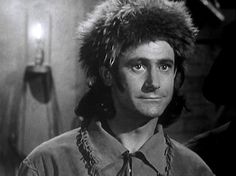 Ollen George Dunn was born in Brownwood, Texas, and made his way to New York City to perform in vaudeville. From there, he went on to Hollywood, where he appeared in twenty five motion pictures and more than one hundred television shows. Some of his appearances were uncredited bit parts. One of his major roles was "The Prophet" in Operation Petticoat, alongside Tony Curtis and Gavin MacLeod. Dunn also appeared in several other well-known films, including Giant, Inherit the Wind, The Long, Hot Summer, The Kettles on Old MacDonald's Farm, and Shenandoah. In another phase of his career, he appeared in a number of John Cassavetes films, including Faces and A Woman Under the Influence. Dunn's final role was in fellow-Davy John Wayne's final film, The Shootist. Dunn died on April 27, 1982 in Los Angeles. Ollen George Dunn was born in Brownwood, Texas, and made his way to New York City to perform in vaudeville. From there, he went on to Hollywood, where he appeared in twenty five motion pictures and more than one hundred television shows. Some of his appearances were uncredited bit parts. One of his major roles was "The Prophet" in Operation Petticoat, alongside Tony Curtis and Gavin MacLeod. Dunn also appeared in several other well-known films, including Giant, Inherit the Wind, The Long, Hot Summer, The Kettles on Old MacDonald's Farm, and Shenandoah. In another phase of his career, he appeared in a number of John Cassavetes films, including Faces and A Woman Under the Influence. Dunn's final role was in fellow-Davy John Wayne's final film, The Shootist. Dunn died on April 27, 1982 in Los Angeles.
|
A Cloud of Witnesses (1958) was a play written by L. Ramsey Yelvington, telling the story of the Alamo — this time in verse. ("Quick, what rhymes with 'fix bayonets'?") According to Paul Baker, the original director, the play "was a highly incisive picture of the real men of the Alamo." (You know, if real men actually talked in verse during a battle to the death.) The outdoor production was put on in San Antonio at nearby Mission San Jose, with its characters behind a scrim covering the skeleton of the Alamo chapel.
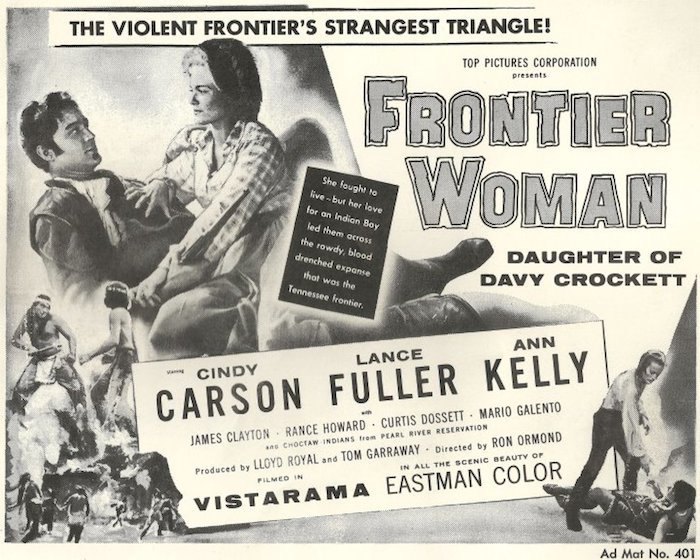

Davy's daughter searches in vain for some sort of historical evidence to prove that she existed. (Collection of the author) |
"Frontier Woman: Daughter of Davy Crockett" was released on 4 July 1956 by Top Pictures Corporation and American International Pictures. It was created to cash in on the mid-fifties Crockett craze with the tagline: "The Violent Frontier's Strangest Triangle! White Girl against Indian Girl in the strange love story that set the Tennessee frontier ablaze with a thunder of bullets that left a path of blood!"
According to the film's press book and what it calls "fragmentary historical reports," the real Polly Crockett "was brought up by an Indian woman, and grew into robust and beautiful young womanhood among the Indians in Tennessee. She inherited much of the crafty frontier wisdom from her father and was taught the skill and ruggedness of the Indian by her years of close association with them." This was, of course, totally made up. The real Margaret Finley "Polly" Crockett was born in Franklin County, Tennessee on 25 Nov 1812. After the death of her namesake mother in 1815, she was raised by her stepmother, David's second wife, Elizabeth Patton Crockett. Margaret married Wiley Flowers on Mar 25, 1830 in Gibson County, Tennessee, at the age of 17, but David was unable to attend her wedding. There is an anecdote about this marriage in the 1833 book Sketches and Eccentricities of Col. David Crockett: "A young gentleman of worth and respectability (had) been paying his addresses to a daughter of Colonel Crockett, and having obtained her consent, wrote to her father in Washington, requesting his permission that they might be married. The colonel, approving the match, wrote in answer to his letter the following laconic reply: "Dear Sir, I received your letter. Go Ahead. David Crockett." They had six children, and Polly died sometime after 1850 in Tennessee.
It's 1838 in Tennessee. Polly, the daughter of Davy Crockett, left motherless shortly after birth, has been reared by an old Indian squaw named "Aunt Birdie." That squaw's son, Neshoba, is secretly in love with Polly, who has only sisterly feelings toward him. Meanwhile, an Indian girl named Redbud is in love with Neshoba, and is "insanely jealous of Polly."
Meanwhile, an unscrupulous agent of the Southern Fur Company named Prewitt (Rance Howard) uses Redbud's jealousy of Polly in a scheme to seize the frontier settlers' land and trapping rights. At Prewitt's urging, Redbud organizes a band of renegade Indian braves, who launch violent attacks on the settlers' homes in order to scare them away. Aunt Birdie is killed in one of the raids, and the house she shared with Polly and Neshoba is burned to the ground. After many twists and turns, she meets love interest, "Catawampus" Jones (Lance Fuller), from Texas. It turns out that Catawampus was stationed at the Alamo with Davy, but was sent out as a messenger, and missed the final battle. Jones even has a memento for Polly from her late father — a watch — as well as the latest in firearms. The film ends with the settlement safe again, and Polly planning a future with Catawampus — but there's an election going on in town, and Polly decides to run for office, like her father. Catawampus plans to return to Texas, but decides to follow Polly instead.
This film features the first screen appearance of Ron Howard, who would produce 2004's The Alamo. His father Rance Howard played the villain, although he was originally hired by the producer to play the lead: "Mr. Royal thought I would be right for Catawampus Jones, the male lead. His idea was to bring in a female star from Hollywood to play Polly Crockett, Davy's Daughter. Davy was talked about but he never appeared in the film. This time period was after he had died in the Alamo... When I arrived in Meridian to start the film I met the director, Ron Ormond, and learned there had been a change of plan. Since talking with me, Mr. Royal had hired Ron Ormond to direct and Ron Ormond had convinced him to bring an actor from Hollywood to play Catawampus Jones and cast the role of Polly with a local actress, whom hadn't been cast yet. This left me out, except they wanted me to play the lead heavy, Gabriel Prewitt."
Boxoffice Magazine, April 27, 1957, declared: "This is a good little picture in color. Cindy Carson does a good job playing the daughter of Davy Crockett. Good fight between the Indian girl and white girl." However, the Kansas Board of Review had a different opinion. The Board of Review operated in Kansas from 1915 to 1966. Its sole purpose was to review, censor and/or approve motion pictures before they could be legally shown in theaters around the state. They censored a scene in which a man bends over woman and "rubs his hands over lower extremity of body." Rance Howard remembers: "We went over to New Jersey to a theater where FRONTIER WOMAN was playing. By now I was back in the swing of the business, doing TV and Summer Stock acting. I believe Jean, Ronny and I sat through it about three times. I realized it was no threat to the big John Wayne, Jimmy Stewart, Henry Fonda westerns, but actually in the 'B' western class. Nevertheless, it had a lot of energy, a lot of action, and was shot in breath taking color."
Director Ron Ormond (1910-1981) was born Vittorio Di Naro. He took his show-business surname from his friend the magician, hypnotist and mystic Ormond McGill. During the 1950's Ormond spent eight months with Ormond McGill in India writing the book Religious Mysteries of the Orient/Into the Strange Unknown that centered on "psychic surgery." Other books by McGill and Ormond include The Master Method of Hypnosis, The Art of Meditation, and The Magical Pendulum of the Orient.
Ormand was performing as a magician calling himself "Rahn Ormond" in 1935 when he met vaudeville singer and dancer June Carr (1912-2006), and married her three weeks later. They became partners in film production and had one son, Tim, whose godfather was Bela Lugosi, appeared in several of their films. June Ormond's father actor, former nightclub owner, and burlesque comic Cliff Taylor also appeared in many of the Ormond's films.
Ormond formed Western Adventures Productions, Inc in 1948 and formed a partnership with Lash La Rue (named after his bullwhip) writing and producing and eventually directing his films. Ormond made his directing debut in King of the Bullwhip with La Rue in 1950. From 1948 to 1956, he wrote, directed and/or produced over 30 feature films, leading to Frontier Woman in 1958. As B-picture Westerns became overexploited, Ormond moved into other genres with films such as 1957's Untamed Mistress, about a girl raised in a gorilla community ("Who would be her mate...MAN OR BEAST?" trumpeted the pressbook), creating what cult collectors refer to as "Z-films." Their artistic credo was spelled out in blazing letters atop their mid-1960s pressbooks: "It's Exploitable!"
After making The Monster and the Stripper in 1968, Ormond was in a plane crash. After surviving the accident he became born-again and started making religious films featuring a fire-and-brimstone preacher named Estus W. Pirkle. Ron and June remained married until his death on May 11, 1981 in Nashville, Tennessee. Ormond's popularity after his death mushroomed with the rise of videotape, and many enjoyed his films as "so bad they're good." Frontier Woman, unfortunately, is lost.
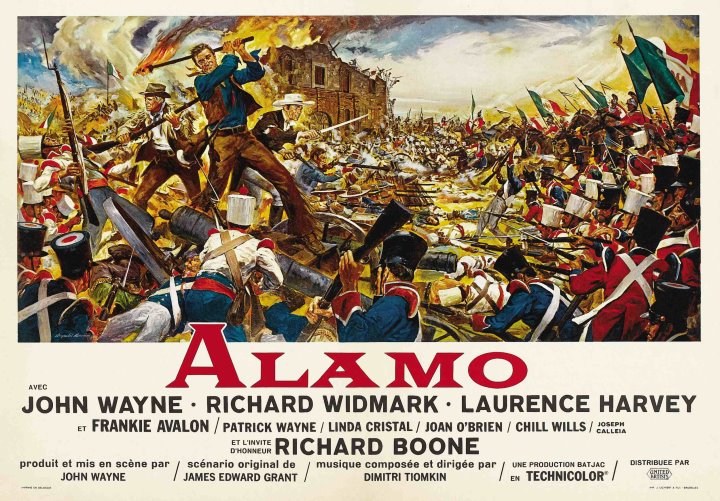
"Wayne was starring in a motion picture in Mexico in 1946 when the idea of a great film spectacle based on the true story of 'The Alamo' first came to him. At the time he was disturbed about world conditions and the role which the United States seemed destined to play on the stage of international politics. It was in this climate that the idea of making 'The Alamo' began to germinate in Wayne's mind. 'This picture is going to shake hell out of the world,' Wayne said."
—"A News Release: John Wayne's 'The Alamo,'" by Russell Birdwell, 1960 |
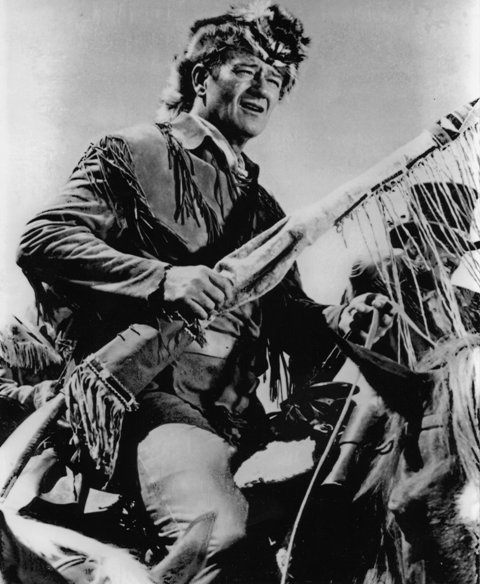 |
John Wayne played Crockett in 1960's The Alamo. Wayne's character is the first Davy who you can buy as both a Congressman and a frontier scout. The Duke plays Davy as a mythic legend — by playing Davy as, well, John Wayne. This tactic works because this characterization of Crockett is the first to be aware of his own celebrity, and the first to use his celebrity to get what he wants. He's never called "Davy Crockett" in this film—he's called "THE Davy Crockett" and "the FAMOUS Davy Crockett" and "the GREAT Davy Crockett" (Flaca, p. 51, scene 95).
This Davy needs to be legendary: If it wasn't difficult enough for him to take on Pancho Villa in Martyrs of the Alamo, he would now have to take on both Nikita Khrushchev and Fidel Castro, as the Alamo siege became an allegory for battling Communist expansion: The Cold War for Texas Independence.⁷
Wayne had been trying to make an Alamo film for almost 20 years. After Wayne's bad experience with Republic on the Alamo project that became The Last Command, Wayne and producer Robert Fellows formed their own production company, Batjac, in the early fifties, to develop projects for Wayne to star in. Finally in 1959 enough time had passed from the Republic film for Wayne to make his own. He re-hired James Edward Grant, the author of that first Alamo script that Republic had made into The Last Command (with Wayne and Grant going uncredited), and entrusted him to come up with a new, bigger, better version of the Alamo saga.
Grant shared Wayne's vision of the world and his politics, and they collaborated on twelve projects in all, the most notorious being Big Jim McLain in 1952. In that film, Wayne played an investigator for the House Un-American Activities Committee (HUAC) who exposes a communist cell in Hawaii. (It's Pearl Harbor all over again!) In 1948, Wayne had become the president of the Motion Picture Alliance for the Preservation of American Ideals, which was cooperating with HUAC to purge "Communist sympathizers" from Hollywood, so the role wasn't much of a stretch. All the film did was to purge ticket-goers from the theaters. In some European markets the film was retitled as Marijuana and removed the communist angle, making the villains drug dealers instead by dubbing new dialogue.
Historian Timothy Todish said "there is not a single scene in The Alamo which corresponds to an historically verifiable incident." Frank Thompson adds, "Wayne never meant for The Alamo to be factually true. Wayne wanted his film to be a ballad, an ode to an heroic era, aimed at a generation that didn't seem to believe in heroes anymore." Wayne himself said, "I think it's the greatest piece of folklore ever brought down through history, and folklore has always been the most successful medium for motion pictures."
Wayne geared himself up for his directing debut in the Howard Hawks film Rio Bravo, released in 1959, starring Wayne and directed by Howard Hawks. The film is jam-packed with Alamo references, and Wayne borrowed story points, characters and even music for his film. The script was written by Jules Furthman and Leigh Brackett, based on a short story by B.H. McCampbell. "Rio Bravo was designed as an Alamo story in which the besieged Texans win," according to Allen Barra in his article 'Rio Bravo,' Still Popular and Hip at 50, printed in The Wall Street Journal on March 26, 2009. Rio Bravo was made as a response to High Noon (which is sometimes thought to be an allegory for blacklisting in Hollywood, as well as a critique of McCarthyism), but Alamo allusions are everywhere:
The sheriff (Wayne) and his deputies are surrounded in jailhouse by bad guys—and they compare their situation to the battle of the Alamo.
The musical score, composed by Dimitri Tiomkin, includes El Deguëllo, a tune which is explained by gunslinger Colorado (played by Ricky Nelson): "They call it the Deguëllo — the Cut-throat song. The Mexicans played it when they had those Texas boys bottled up in the Alamo. Played it day and night until it was all over." (The melody was totally made up by Tiomkin, but Wayne liked it so much that he used it in The Alamo the next year.) The song is then played day and night as the bad guys lay siege to a tiny adobe jail in which Wayne, Colorado, and the other deputies are holed up. (Later, in Wayne's Alamo film, the San Antonio River is referred to as the "Rio Bravo," apparently as a reverse-homage.)
Dean Martin plays a drunken gunfighter in Rio Bravo who has to sober up for the battle (echoed in Widmark's Bowie in the Wayne film) and hearing El Deguëllo gives him courage.
Walter Brennan plays a crusty old ally to Wayne who talks funny, which is a character that would be played by Chill Wills in The Alamo.
Rio Bravo featured singer Ricky Nelson in a support role to attract teen audiences, so Wayne hired Frankie Avalon for the same reason in his film.
Angie Dickinson plays the lonely frontier hottie that Linda Cristal would assume in The Alamo; Dickinson is alone because her ex-husband was arrested, while Cristal plays a widow; Dickinson's role is more integrated into the story (and works in the "Alamo Hotel," no less).
As Wayne developed The Alamo, he concluded he did not want to risk seeing that vision changed; he planned to produce and direct the movie himself, but he was unable to find financial support for the project unless he starred in the picture. "United Artists only agreed to put up part of the money if I played a part, so I said I'd play Sam Houston, which was really a cameo kind of role. But they said I had to play a major role and said if I didn't play Davy Crockett, they wouldn't be interested. So, reluctantly, I played Crockett." Fortunately he did, because his Davy is the best thing in the film.
Despite usually being lumped together as Cold War Davys, the contrast between Wayne's Crockett and Fess Parker's Crockett is stark. While a Cold Warrior, Parker's Davy was at the Alamo to help "Americans in trouble" (a distinction he makes to Georgie Russel) for an audience who had just gotten out of the Korean war and were dealing with the Red Scare within the U.S. borders; but the Duke's Davy came half a decade later, after the intended US audience had witnessed a Cuban revolution and Soviet interference all over the world. His Davy enters another country to oust its dictator and form a Republic—presaging Vietnam (and historically, pretty much the only accurate thing in the film).
The draft dated 5/19/1959 sets up the 'Texas-is-America' theme right away, comparing the Texas revolution with the US revolution, sixty years earlier. The story begins with General Cos's forces being expelled from Bexar. Onlookers in the smoldering city are laughing at the retreating Mexican forces as three men scuffle over what flag to put up over San Antonio: One "has a coiled rattlesnake and the legend: 'Don't Tread On Me'; Another has the date: 1824; Another is a scrambled version of the American flag with 'Texas' emblazoned in the middle."
We aren't introduced to Crockett and his 23 Tennesseans until page 22 of the script, in Scene 59, as they arrive in Bexar (San Antonio): Upon seeing a cantina in the distance, Crockett tells the group "to get out of these deerskins and into our foo-faw-raw." The cheering Tennesseans think they are in San Antonio to hunt and drink, but Crockett has other ideas, which he expresses later as the group discusses the repressive nature of Santa Anna's government, and Wayne's Cold War agenda really kicks in (P. 75 s. 124, draft dated 6/8/59):
Wayne's character implies that Santa Anna and his army are on the border of the United States, massing, and if he crushes Texas, the U.S. could be next. It was easy to see why Grant and Wayne were so concerned with neighboring countries. The shooting script, drafted between 5/19/59 and 6/19/59, was written during a time of great political turmoil in Cuba, just off the U.S. coast. An armed revolt had led to the overthrow of dictator Fulgencio Batista of Cuba on January 1, 1959. On February 16, Fidel Castro was sworn in as Prime Minister of Cuba. Almost immediately he began ousting popular liberals and democrats. President Manuel Urrutia Lleó wanted to restore elections, but Castro opposed free elections using the slogan, "Revolution first, elections later". Between April 15 and April 26, Castro visited the U.S. and hired one of the best public relations firms in the United States for a charm offensive. In New York on April 25 he said, "I don't agree with communism. We are democracy. We are against all kinds of dictators... That is why we oppose communism." But he was refused a meeting with President Eisenhower, and tensions rose.
On June 19th as Wayne and Grant finished their shooting script, Castro appeared on Cuban television to rebuke President Manuel Urrutia Lleó, claiming that he "complicated" government, and that his "fevered anti-Communism" was having a detrimental effect. Crowds surrounded the presidential palace demanding Urrutia's resignation, which was duly received, and Castro allied himself with Soviet leader, Nikita Khrushchev. This was a major coup for the Soviet Union, which had garnered an ally only miles from the American coast. The paranoia this situation caused throughout the United States would be evident in the film.
Throughout the Cold War years, the U.S. acted as a barrier to socialist revolutions and targeted populist and nationalist governments that were aided by the communists. The CIA overthrew other governments suspected of turning procommunist, such as Guatemala in 1954 under Jacobo Arbenz Guzman. The U.S. approach to foreign policy increasingly relied on clandestine CIA operations to overthrow unfriendly governments. In The Alamo, Crockett's Tennesseans do just this sort of thing against Santa Anna's Mexico. We have gone from Davy being there to protect "Americans in trouble" in 1955, to invading other countries to prevent them from ever attacking the U.S., presaging the Bay of Pigs and Cuban Missile Crisis.
Much of the promotion of the film centered on its historical accuracy. Wayne hired Texas historians Lon Tinkle and J. Frank Dobie as advisers. Wayne recalled that Dobie gave him crucial advice on playing Crockett: "Dobie once said that Crockett never ate on an empty stomach nor drank on a full... That gave me an attitude of how to make a human being out of (one of) those great heroes." But the film Wayne finally delivered featured a Crockett raised in Kentucky (instead of Tennessee), gave him a Mexican love interest (he was still married in reality), placed the Alamo mission near the Rio Grande River (it's actually hundreds of miles away), gave Santa Anna the middle name "Miguel" (his full name was actually "Antonio de Padua María Severino López de Santa Anna y Pérez de Lebrón"), and had the final attack occur in broad daylight instead of under the cover of darkness, leaving thousands of Mexican soldiers advancing in bright sunlight as easy targets for the riflemen inside the Alamo. ("I was proud of them," one defender says after shooting dozens down.)
So what happened? Alamo historian Rich Curilla, corresponded with Lon Tinkle and asked him why the movie wasn't more accurate if he and Dobie were there. His response was very revealing: "John Wayne did 'import' Frank Dobie and me for week-end visits to his sets at Brackettville; but his scriptwriter (who had big money invested in the movie and therefore had a lot of power) would not listen to any advice or make one single correction. I have rarely met a more cynical man, with more scorn for the general public and what it can be induced to accept as reality."
Eventually, both historical advisers asked that their names be removed from the finished film.
Screenwriter James Edward Grant claimed to have read hundreds of books in researching the story, but hardly a moment of the film actually happened — he might have read Richard Penn Smith's faux-Crockett autobiography, Col. Crockett's Exploits and Adventures in Texas (1836), since Grant used a couple of the fictional characters in that book like Thimblerig the Gambler and the bee hunter (whom he misnamed Beekeeper) — but most of his reading must have actually been from his previous Alamo script for Republic. The similarities (none of them being historically accurate) are striking:
THE LAST COMMAND
 |
THE ALAMO
 |
THE TRUTH
 |
| Jim Bowie returns to San Antonio after a long absence. |
Davy Crockett returns to the Alamo after a 15-year absence. |
Bowie married into a prominent Family in San Antonio; Crockett had never been there before. |
| Bowie is told by his old friend, General Santa Anna, that his wife and children have died from the plague. |
Bowie is informed by messenger that his wife and children have died from the plague. Crockett's wife and children were killed in an Indian massacre. (According to the first draft — it was removed from the film, although in the film he is a widower and falls in love). |
Bowie's family perished several years before the Alamo. Crockett's first wife died from illness, but his second wife and family were alive in Tennessee at the time of the battle. |
| Bowie is tempted by a young Hispanic girl from a fine family named Consuelo de Quesada (Anna Maria Alberghetti). |
Crockett is tempted by a young Hispanic girl from a fine family named Graciela 'Flaca' de Lopez y Vejar (Linda Cristal). |
There are no recorded romances for Bowie or Crockett during 1836 in San Antonio — not saying that they weren't tempted, of course... |
| Bowie sends a young defender, Jeb Lacey (Ben Cooper), to safety with Sam Houston before the final battle. |
Bowie and Crockett send a young defender, Smitty (Frankie Avalon), to safety with Sam Houston before the final battle. |
Crockett's nephew, William Patton, accompanied him to Texas, and it was speculated by some historians that he escaped and joined Houston's army. However, the William Patton who fought with Sam Houston at San Jacinto, turns out to be William Hester Patton, unrelated, who came to Texas in 1828. |
| Travis suspects Bowie of being a drunk and siding with the Mexicans. |
Travis suspects Bowie of being a drunk with Mexican leanings. |
Bowie had just come off a drinking spree in which he emptied the local jail, and his drunken men terrorized San Antonio. Travis sent a letter to Houston protesting Bowie's ways, and the letter was approved by Crockett. |
| Crockett is accompanied by a religious man he calls "Parson" (Russell Simpson). |
Crockett is accompanied by a religious man he calls "Parson" (Hank Worden, who played a river pirate in the Disney Davy Crockett series). |
Crockett didn't seem to hang out with a lot of religious men. In fact, Chapman wrote that while painting Crockett, a son had written a letter to Crockett, who told Chapman "a son of mine out west has been and got converted... pitches into me, pretty considerable." |
| The defenders raid Santa Anna's cannon at night. |
The defenders raid Santa Anna's cannon at night. |
The defenders were trapped. |
| Bowie is injured in a fall from a horse outside the Alamo, and kills many soldados with pistols and knife from his bed. |
Bowie is injured in a fall from a horse outside the Alamo, and kills many soldados with pistols and knife from his bed. |
Bowie was sick with an untold number of illnesses and probably wasn't even conscious when he died. |
| Crockett dies when he throws a torch into the powder magazine, killing several attackers. |
Crockett dies when he throws a torch into the powder magazine, killing several attackers, and blowing up the church containing women, children and the injured. (???) |
While arguments continue over Crockett's death, everyone agrees that it didn't happen this way... The church is the only surviving building, and a man named Henry Werner attempted to blow up the powder keg, according to interviews with Mrs. Dickinson, but was killed before he reached it. |
Grant doesn't just steal from his own script, he often tries to out-do it as well — but with limited success: Bowie is injured in both movies riding into the Alamo after a reconnaissance mission (a more "heroic" way to end up in bed than a lingering illness), but Grant isn't satisfied with that for The Alamo — now Bowie recovers from the mission... but then his leg is injured again in an explosion, when the character of Parson is killed... then again in the final battle (where he is carried to the infirmary — under virulent protest), to the point that he seems more accident-prone than heroic; While Crockett just sticks a torch in a powder keg to take a few Mexican soldiers out with him in The Last Command, in this film he throws a torch into the powder room, to blow up the entire back of the chapel — perhaps an ill-advised move, seeing as the women and children (and of course, the terminally injured Bowie) are all housed inside. (Grant and Wayne sidestep the ramifications of this action by showing those characters still alive inside the building in later shots, with the roof blown off.)
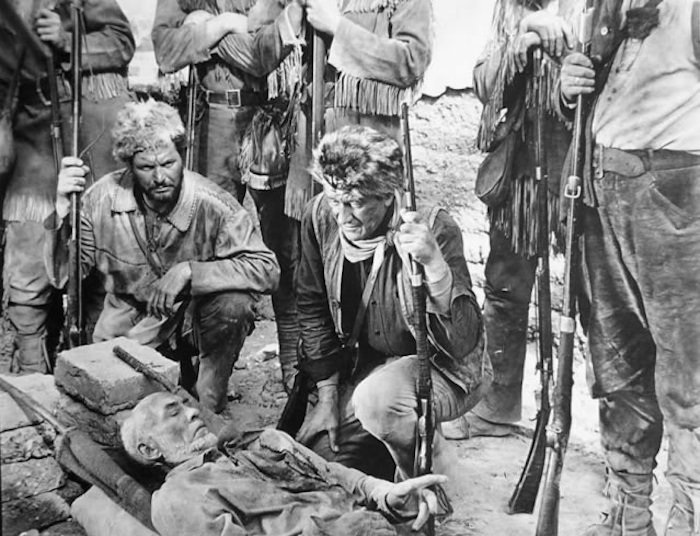
Although the fictional character of the Parson survives until the final battle in "The Last Command," he doesn't last as long in "The Alamo," which makes for a lot of speech-ifyin'.
Still, while The Alamo has many similarities to The Last Command, the mood and politics of the United States had changed during the intervening years, and it showed in Wayne's film. Santa Anna in The Last Command is a thoughtful leader who can debate political differences with his friend "Jimmy" Bowie while remaining on good terms. But by the time of The Alamo, with Batista out of Cuba and Castro in, and with the USSR pulling the strings of a puppet dictator behind the scenes, Santa Anna has become Khrushchev — a cold, imperious figure that we barely see during the course of the film: He never utters a single line of dialogue — he just orders the death of the American settlers.
One of the big controversies in Wayne's film was that unlike in The Last Command, Travis never draws a line in the sand, as some traditions hold. But the drawing of the line actually was in Grant's script, dated 6/19/59, on page 149. (Although in Grant's version, Travis has Dickinson draw the line for him.)
In the script, Cotton has been sent off as a courier, presumably to safety with Houston. But in this version, he rides back to the Alamo and encounters a dying Jim Bonham hiding in the weeds from Mexican soldados. Boham tells Cotton that Fannin is "destroyed," and Cotton replies that Houston isn't coming, either. Cotton then attempts to take Bonham into the Alamo, slung over his horse. But Cotton is shot out of his saddle and instantly killed, dragged through he open gate with his foot caught in the stirrup (P. 148, S. 451).
Crocket watches some defenders carry Cotton's body off and says, "Riding out of Tennessee and this boy loped up on that pinto pony — Colonel, he says, please take me along — and I did." (In the finished film his character arrives too late and accompanies Mrs. Dickinson and her party away — apparently Wayne didn't want to break any teenyboppers hearts with a death scene for Frankie Avalon — according to a November 1960 Los Angeles Examiner article, just before the filming the final scenes, Wayne announced that "The end of the picture is depressing enough. He lives.")
In the next scene, Bowie informs Crockett that the dying Bonham said Fannin won't be bringing any help, and that he's taking his people out and cutting through the North. (Good luck — two men were just shot to pieces outside the gate.) Bowie asks Crockett if he's coming as well, and Crockett says (as he does in the finished film), "Seems the better part of valor, I guess."
Then the following occurs:
|
However, John Wayne the Director chose to ignore Alamo tradition, in a rare and welcome nod to character development: As written in the script, Travis is still looking down imperiously on his troops — commanding Dickinson to draw the line in the sand for him, so that he doesn't have to lower himself to their level. Bowie follows orders and Crockett leads his men across the line.
But in the completed film, the scene is vastly improved. Travis is now humbled, standing with his men, at their level: He addresses them directly and doesn't draw a line in the sand — instead, he tells them they're brave, noble soldiers, and are free to go. Bowie and his men are already on their horses, ready to leave. Bowie starts to lead his group out, but then dismounts and hobbles across the yard, to stand (and presumably die) alongside his rival, Travis—and the others soon join them. It's not Travis' challenge that makes them stay, but a personal decision to die for a cause. Instead of crossing over a line to Travis, the Alamo defenders choose to stand with him — an important distinction in a film about free will.
In movies like Martyrs of the Alamo, Crockett is the first to cross the line. But here, Wayne has added a crucial character touch: after luring his friends into Texas by promising hunting and liquor, Crockett lets the "Tennesseans" choose for themselves here, instead of manipulating them again. Crockett hangs back and lets his "Tennesseans" choose to stay of their own accord before following them across the courtyard to fight—and none of that was in Grant's script. It's a scene that shows how good Wayne could have been as a director, and that he'd learned well from his mentor, John Ford. In not drawing the line, Wayne created one of the most moving moments in an Alamo film, ever. Happy Shahan, who owned the ranch that the set was built on, said he argued all night with Grant about including Travis drawing a line in the sand, but by that time Grant had been convinced not to use the incident, and insisted that it never really happened. (News flash: Nothing in your screenplay ever happened, Mr. Grant.) In another interesting touch, the men all stand together in the courtyard, looking out defiantly past the camera, and director Wayne holds the camera on them as the music swells. Wyne seems to be not only celebrating the decision of these brave men, but to be challenging the audience to decide to stand alongside them. It's one of the iconic scenes of the Cold War in cinema.
Wayne and the real Crockett had many other parallels that would have been interesting for the actor to exploit. For instance, Crockett's political foes accused him of doctoring his war record, hiring another man to fight in his place at the end of the Creek War, and not being much of a soldier at all. Wayne's detractors accused him of cowardice by avoiding service altogether during World War II. Wayne and Crockett both had to answer these allegations in the best way they could: Crockett joined the army of Texas in order to qualify for political office, while Wayne made heroic war movies, portraying the ultimate patriot and soldier. His daughter Aissa feels the movie was really about the Duke himself, and dealing with his emotions over not enlisting during World War II. "I think making The Alamo became my father's own form of combat. More than an obsession, it was the most intensely personal project of his career." Wayne could definitely have had an interesting take on Crockett dealing with that negative scrutiny while holed up inside the Alamo... But obviously, this was not a character arc that Wayne wanted to exploit — he needed Crockett to be a war hero, so that Wayne could play the mythic image that he wanted to represent. Therefore, a new Crockett was created: This one fought the British (or at least he tells Travis and Dickinson that he did), and was made a Colonel during the Indian wars. When he meets Mrs. Dickinson (p. 62, scene 111), and we get more historical fabrications:
 |
This scene was never presented in the film, but it is revealing that it was planned. The real Crockett was actually still married and the father to half a dozen living kids at the time of the Alamo siege; the character here is a childless widower, pondering the idea of starting all over again with a young Mexican widow (in Crockett's words: "Young doe, old buck—each has something the other lacks"). Of course, this fabrication is inserted for other reasons, too: The script was adapted from The Last Command, which featured the same plot (with a young local girl falling for the old frontier hero — in the case of that film, Jim Bowie—who gives up a new future with her to become a martyr, instead); But most importantly, because it's a John Wayne movie, and he needs a love interest who is geographically closer to his character than Elizabeth Crockett running a farm back in Tennessee (and one that was younger than 40, as well). So beautiful Linda Cristal was enlisted to play "Graciela Carmela Maria de Lopez y Vejar" or "Flaca" for short. (In the longer roadshow version of the film, she pours Crockett some wine and tells him, "It's a childhood nickname. It means skinny." Crockett finishes his wine, looks at her figure, and says: "Bad eye for curves whoever nicknamed you that.") Flaca's father led the opposition against Santa Anna in Potosi (p. 73, s. 123)—where he, her husband, and her four brothers all died (p. 43, s. 86).
35 years before, John Wayne had watched the overtly racist The Birth of Texas (the re-titled Martyrs of the Alamo) in a movie theater in Glendale, California. In that film, the Texas revolution is started when a Mexican soldier makes a pass at a white married woman, whose husband then kills the soldier. In the prejudiced eye of that film, the murder was seen as justified. But by the time of The Alamo, John Wayne had been married twice to Latina women, and in his version of the Alamo siege, the roles are reversed. Flaca, is sexually harassed by an Anglo politician named Emil Sand, who is forcing her to "marry" him. Crockett intercedes on behalf of Flaca. In the film today, the character of Sand just disappears from the narrative and we never learn his fate, but the longer roadshow version of the film reveals the death of Emil Sand—he is killed by Wayne's Davy Crockett. When Flaca questions Crockett later, he tells her that Sand "died under Jim Bowie's knife." He then winces and shakes his head, admitting: "Lying's such a hard habit to break. Bowie didn't kill him. I had Bowie's knife in hand at the time."
Flaca is shocked, but not unduly sad about Sand's murder—still, the losses of the people fighting for her are piling up, and she starts to cry. An early draft (p.68, scene 116) extends this scene (it's included here solely for all those kids who watched the film in a dark theatre, ogling Linda Cristal, and thinking she might be worth a painful death from 7,000 Soldados):
The scene was omited — probably because of the weird juxtaposition of implied sex after a murder confession. But while Wayne sought to rectify old stereotypes of the Mexican people, the racial divide of slavery was sidestepped in the script and film. The real Crockett's slaves are never mentioned. Jethro, the slave of Jim Bowie, is granted his freedom the night before the final battle and is advised to slip over the wall in the darkness. He declines and decides to fight alongside the other defenders. In the final battle, he dives in front of Bowie to protect him from bayonets, sacrificing his own life (shades of Martyrs of the Alamo). Sammy Davis, Jr. reportedly asked Wayne for the part of Jethro, but some producers blocked the move — apparently because Davis was dating white actress May Britt (according to John Wayne — The Man Behind The Myth, by Michael Munn, published by Robson Books, 2004). Another slave, a young boy apparently working for the Dickinsons is never freed (the script referred to him as "the little colored boy, Happy Sam") escorts Mrs. Dickinson and her daughter out of the Alamo at the end of the film. It's kind of strange to see a defender's wife representing freedom and liberty staring down Santa Anna... while a child slave is leading her daughter's donkey to safety.
The final battle and Crockett's death are all of two pages in the script, written in outline form, starting on p.153, and listing general instructions for shots 460 through 560. Crockett's death gets one paragraph:
| CROCKETT: FIGHTING HARD AGAINST A SWARM OF INFANTRYMEN, HE IS OUT OF WEAPONS. HE TURNS AND RUNS AHEAD OF A FLOCK OF TROOPERS. THEY CHASE HIM INTO A STONE BUILDING. HE GRABS A TORCH AS HE RACES INTO THE BUILDING. INSIDE WE SEE THE PURSUING HORDE START TO BACK PEDAL AS THEY SEE WHAT HE INTENDS TO DO. BUT THE PRESS FROM OUTSIDE FORCES MORE AND MORE SOLDIERS INTO THE PILE-UP INSIDE THE DOOR. CROCKETT FLINGS THE TORCH INTO THE STACKED POWDER BARRELS. THE EXPLOSION DWARFS ANY OF THE PREVIOUSLY SEEN EXPLOSIONS.
AS THE ATTACKERS SURGE THROUGH THE HOSPITAL AREA THEY ARE LEAD BY THE HANDSOME MEXICAN LIEUTENANT, WHO LEAD THE PATROLS DEMANDING SURRENDER AND ORDERING OUT THE NON-COMBATANTS. HE JERKS ASIDE A CURTAIN, SABRE RAISED HIGH, TO SEE CROUCHED THERE MRS. DICKINSON, LISA AND THE LITTLE COLORED BOY, HAPPY SAM. THE MEXICAN LOOKS AT THEM AND INSTANTLY LETS THE CURTAIN FALL, SAVING THEIR LIVES AND IN THE NEXT INSTANT MEXICAN BUGLERS AND BLOWING RECALL.
THE ALAMO IS HISTORY. |
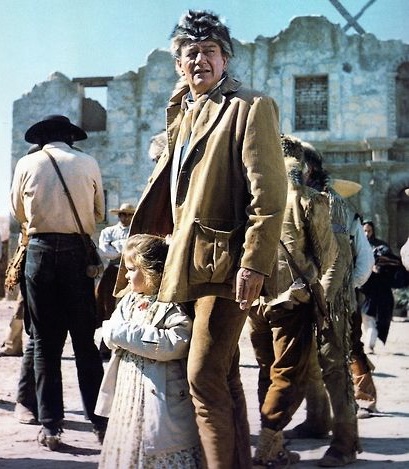
Wayne didn't just try for an All-Star cast, he made the production a family affair. Wayne's four-year-old daughter Aissa made her film debut as "Angelina `Lisa' Dickinson" and his son Patrick portrayed "Capt. James Butler Bonham." His daughter, Toni Wayne LaCava, had a one-line speaking role, and his wife Pilar was an extra in the film, as well. (Collection of the author) |
The Hollywood Reporter followed the production closely. The December 1959 issue reported that a total of 200 players and 5,000 extras appeared in the picture. According to an August 1959 news item, John Gavin was on loan from Universal with Linda Cristal for the film; however, a September 1959 news item reported that negotiations for Gavin to play the role of Dickinson were not completed and that Ken Curtis was cast in the role. Although negotiations for Wayne and Marlon Brando to "swap" cameos in their respective films, The Alamo and The Ugly American, were reported in an August 1959 Hollywood Reporter news item, neither actor appeared in the other's film.
Other people up for roles included Clark Gable as either Davy Crockett or William Travis (he turned it down), Charlton Heston as Jim Bowie (he turned it down due to politics), Rock Hudson as Travis, William Holden as Sam Houston, and then James Arness as Sam Houston (Arness failed to show up for an interview, and Richard Boone got the part instead).
But through all of the talk about evil dictators and ox-goring, the greatest imperialist threat to Wayne may have been from his mentor, John Ford, who simply showed up on the set one day, set up a director's chair near the camera, and started barking orders. Not wanting to offend an old friend who had basically made his career with films like Stagecoach and The Searchers, Wayne sent him off with a second unit crew to film some scenes that Grant quickly cobbled together while he shot the actual movie. Insiders insist Ford's footage was never used, although onset photos show Ford bossing people around in a lot of the downtown Bexar scenes. In a November 1960 Los Angeles Mirror-News article, Ford shrugged off speculation about just how much he contributed to the final film and claimed that he was the "coach." But even if Ford's work was negligible, he still loomed large over the project... Variety even gave him a co-directing credit in its review!

John Ford looking over Wayne's shoulder during the shooting of the film, although by Cristal's expression and body language here, he may have just been looking down her top.
Reviews of the film were split. Variety said: "It is as actor that Wayne functions under his own direction in his least successful capacity. Generally playing with one expression on his face, he seems at times to be acting like a man with $12 million on his conscience." But the New York Herald-Tribune's four-star review hailed "A magnificent job...Visually and dramatically, The Alamo is top-flight." Time Magazine observed, "Released as a reserved-seat feature ($1.50-$3.50), it is said to have cost $12 million. Predicts one shrewd old Hollywood range rider, Director John (Stagecoach) Ford: 'It will run forever.' In the case of The Alamo, forever is almost attained in one projection; the film runs three hours and 38 minutes, including an intermission. The first three hours, moreover, are as flat as Texas." In October of 1960, a Los Angeles Herald Express reporter, believing that "Leftists and Communists" were attempting "to indoctrinate" the public, praised the "Americanism" of The Alamo in a lengthy editorial.
Wayne had made the most expensive movie in motion picture history up to that point, costing an estimated $10 million to $12 million. An October 5, 1960 Daily Variety news item reported that Wayne's "final tally" for the film was actually $14,000,000 and that the film would've had to gross $17,000,000 before Wayne netted a profit, which it still hadn't reached by the end of the sixties. But The Alamo was by no means the commercial disaster it has sometimes been called. In fact, the film finished in the top ten moneymakers for the year (placing 7th in the US), and fell right in line with the usual take for a Wayne film of that period. Released on 10/24/1960, The Alamo grossed $7,900,000-in box office receipts, it's nestled right between 1962's The Man Who Shot Liberty Valance ($8,000,000) and 1959's Rio Bravo ($5,800,000). The problem was that The Alamo cost a lot more to make.
The Alamo was a "special event" film distributed via Roadshow with advance ticket sales in limited markets. But that meant the profits would trickle in slowly. Wayne had paid for cost overruns out of his own pocket and was heavily in debt — he needed to make his money back — so after its initial release in 1960, at least 30 minutes was cut from the film, in order to add the number of showings possible per day. As Wayne was shooting Hatari! in Africa, the actual cutting was performed by his son, Michael, and the film's editor, Stuart Gilmore. Because the 6 track audio could only be either cut or slightly remixed, a detailed fine cut was not an option. The original negative and all protection elements were cut to conform to the new 161-minute length; the trims and deletions were discarded. So John Wayne's original vision was permanently destroyed, and muddled parts of the plot became even more confusing. (For over thirty years, the original road show version of the film was feared lost, until in 1991 a lone surviving 70mm print was found in remarkably pristine condition in a film exchange in Toronto, by fans Bob Bryden and Ashley Ward. MGM used this print to make a digital video transfer of the road show version for VHS and LaserDisc release. Unfortunately, the print was taken apart and deteriorated in storage. By 2007 it was unavailable in any useful form for subsequent digital releases.)
Eventually Wayne sold his partial ownership of the film to United Artists in order to pay his debts. Still, Duke saw his dream finally completed, and was proud of it. Wayne's son Patrick said, "my father had looked forward to that project for so long... In fact, the joke was that when he initially wanted to do The Alamo he was right for the part that Frankie Avalon played. That's an obvious exaggeration, but he ate, slept and dreamed that picture."
The Alamo was nominated for seven Academy Awards, including Best Picture — beating out films like Spartacus and Psycho. The Alamo may have lost in that category to Billy Wilder's The Apartment, but it took home one Oscar — for Best Sound. It wasn't the success that Wayne had wanted, but it eventually made money and is still shown every March 6th on television, over fifty years after its original release. Wayne himself said, "My politics interfered with the fucking critics on that one." He also blamed the lack of awards on the Communists.
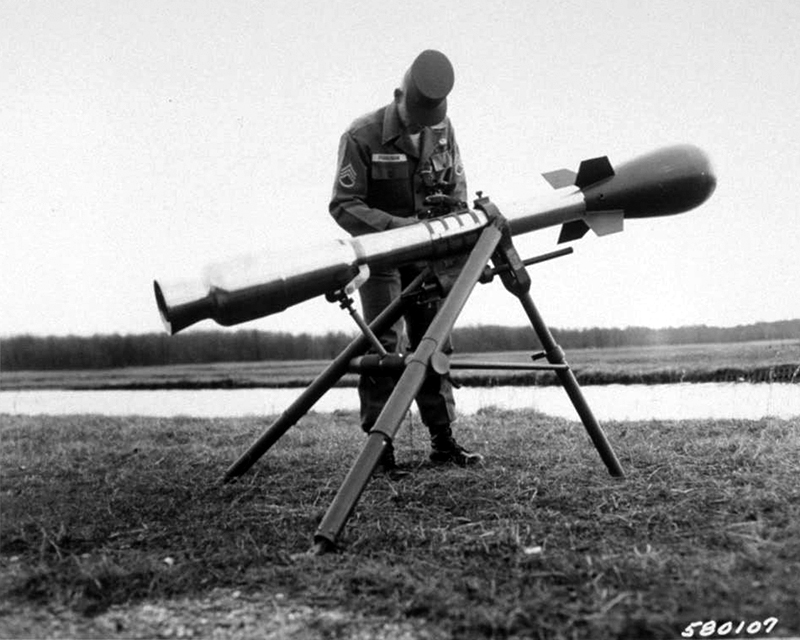
The M-28 Davy Crockett nuclear recoilless gun (smoothbore) for firing the M-388 nuclear projectile... RUN!!!!!
Through the efforts of Disney and Wayne, Davy Crockett and the Alamo became symbols for America at war. President Lyndon Johnson once told the National Security Council that the Vietnam war was "just like the Alamo." Furthermore, he told the soldiers in that war that his great, great-grandfather had fought and died in the siege (which was false).
Meanwhile, the US Army was developing the Davy Crockett Weapon System — a tactical recoilless gun for firing a nuclear projectile. A nuclear bazooka, it required a three-man team, and could be ground or vehicle mounted. The range was around 2.5 miles and fired a 10 to 25 ton nuclear projectile. Unlike the real Davy Crockett, it wasn't that accurate, but the radiation from the projectile explosion was high enough to irradiate anything in its blast radius, man or bear. Numerous Davy Crocketts were stationed with USAREUR along the German/DDR border. There were problems, though: Bob Quinn author of Rock and Rock Cable Ship, said the gun's maximum range was just 2.5 miles — which meant that the firing team would be well within the weapon's kill zone! All in all, John Wayne was probably better off shooting Ol' Betsy at the bad guys. The Davy Crocketts were removed from Europe in 1967, and were decommissioned in 1971.
Davy himself wasn't faring much better in the 1960's. Somehow the historical western frontiersman, wanderer and political outsider had become a symbol of the right-wing establishment and social conservatism during a period of growing protest. Either because of the reactionary politicizing, or because other studios noted that The Alamo was still trying to recoup its losses through re-releases, Davy was relegated to TV for the rest of the sixties.
Soon after Wayne's film there was an Alamo sketch on The Red Skelton Show, called, "Deadeye and the Alamo" (28 March 1961; Season 10, Episode 18). Red Skelton and Cesar Romero (as "General Santa Ana") starred in this episode, detailing what really happened at the Alamo. Crockett was played by John Wayne look-alike James Seay, a familiar figure in "B" sci-fi classics, notably The Day the Earth Stood Still (1951), When Worlds Collide (1951), The War of the Worlds (1953), and as the ill-fated officer who is fatally pierced by a humongous hypodermic needle in The Amazing Colossal Man (1957). The skit is one of the few Alamo productions that actually feels thirteen days long. Then nine years later, Davy returned to Red Skelton with the episode "He Died with His Boots on Cause He Had Cold Feet to Start or He Died with His Boots Off, That's Why He Stubbed His Toe" (CBS: 17 March 1970; Season 19, Episode 25), and this time Fess Parker returned as Crockett (side-note: Mac Davis was the guest vocalist and sang, 'In the Ghetto' and 'Memories.' Mac would go on to play Crockett once, himself).
I Terribili Sette (1963): Massimo Giuliani plays Crockett. A group of boys finds a newborn baby in a field. They bring him to their hideout and consider selling him to a band of gypsies, with the intended result of buying equipment for their soccer team. After various adventures they retrieve the baby and return him to his mother who, having gotten sick, had abandoned him in the park.
I took a look at the poster over at Intercard and it's got a group of little kids on it. My guess is that "Fantomas" and "Pecos Bill" et al are just the characters the kids imagine themselves to be. (Another name on the poster is "The Little Magnificent Seven.") It sounds kind of like Our Gang crossed with Dennis the Menace.
These are the little gang members' nick names. Another one's "Brains", as in a heist movie. Loris Loddi of Johnny Oro and other westerns is among the kid actors here, interestingly enough. He's Bibero', probably another name with connotations, though I don't know what they are (EDIT: I think his nickname means "Baby Bottle"). The actor 'playing' the newborn is actually identified, very curiously. He's Angelo Secchi. He made no further movies, at least not ones with him credited under that name(...if that name is really his in the first place and not just another moniker; he shares it with the Jesuit priest who has been named "The Father of astrophysics") There's also the connection via Fumeria d'Oppio/Opium Den, his 1947 revival of Za' - La - Mort, that early commercial rival of Fantomas and Judex. PRODUZIONE: GILBERTO CARBONE PER FILM COLUMBUS
The Time Tunnel was a TV Series by Irwin Allen telling the story of Dr. Tony Newman (James Darren) and Dr. Doug Phillips
(Robert Colbert), two research scientists who become entrapped in a top secret portal through time. In Episode 13. The Alamo, (12/9/1966), written by Bob Duncan and Wanda Duncan, Tony and Doug arrive outside the Alamo on March 6, 1836 and make it into the fort under cover fire from the garrison on the walls and meet Captain Reynerson (a good trick since in reality everybody was killed that morning by 6am)... who mentions that "the brave ones alway go first...Crockett was killed yesterday."
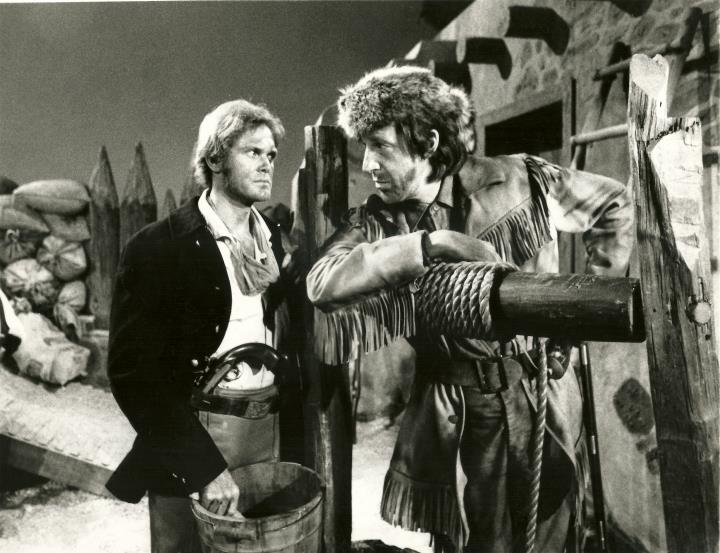
First broadcast on the radio in 1947, CBS is There was a summer replacement series for LUX Radio Theater, featured CBS news teams covering historic events as if they were actually occurring that day. It was very popular and in 1953, the program jumped to television with the new title, You Are There, airing Sunday evenings at 6:30pm. Each episode was hosted by Walter Cronkite, the network's evening news anchor, as if he was interrupting the regular programming with breaking news. It ran on TV for five seasons until of June 1957, and won an Emmy in 1956 and a Peabody Award in 1957.
The battle of the Alamo appeared in each run of the show. The radio broadcast aired on August 18, 1947. The first TV version was broadcast on Sunday, June 28th, 1953, and was directed by Sidney Lumet, but Crockett wasn't heavily featured.
Cronkite hosted a brief revival of the show in the 1970s, and the Alamo story was used again, this time with Crockett in a more prominent role. Fred Gwynne (Herman in The Munsters) played Crockett in "The Siege of the Alamo," directed by Burt Brinckerhoff, on June 21, 1971. The 13-day siege is covered in 21 minutes, in order to fit the show's 30-minute time slot. The Alamo mission itself was presented as a single wall and wooden palisade, flanked by a room belonging to Jim Bowie. When Bonham arrives with the news that no help is coming, Travis actually tells Crockett to assemble the men in Bowie's room (imagine 200 men fitting in a single room around Bowie's cot). Bowie reveals to the Texians that no reinforcements are coming. Crockett comments that none of the men ever did expect help to come, anyway. The defenders are offered a chance to escape before the final battle. Moses Rose chooses to leave but his decision is respected by the other men (all five of them). Soon thereafter, the deguello sounds — the real deguello is finally used for once in an Alamo production — and the defenders rush to the walls as the Mexican army attacks. It almost made you want to root for Santa Anna...
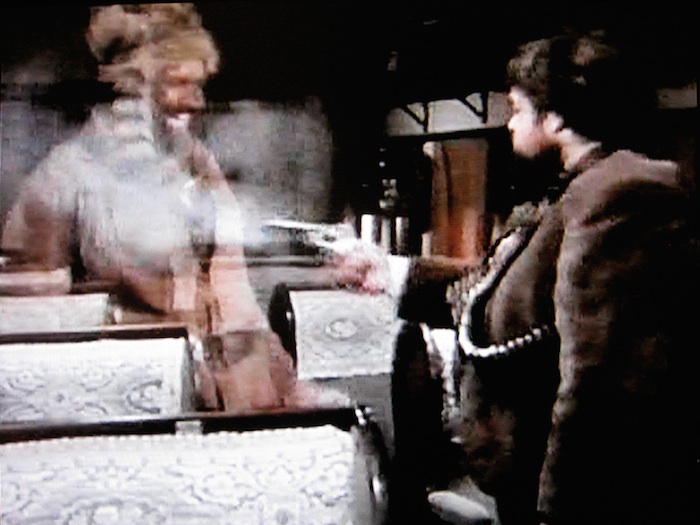
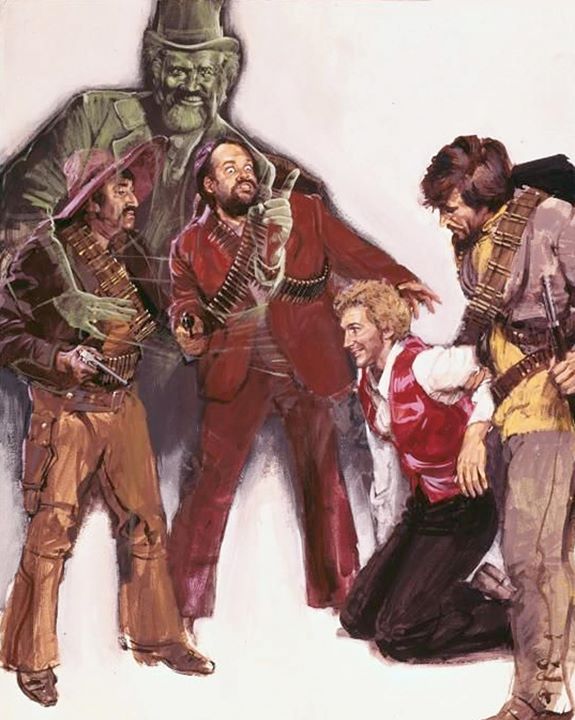
Production art from "Whiskey and Ghosts." In this image, Davy's ghost menaces some bandits who bought the hero's snake oil, which gave them diarrhea, so every time they try to ride after him they... well, you just have to see it, that's all... (Collection of the author) |
The weirdest Crockett movie ever made: Fantasma en el Oeste or Whiskey and Ghosts stars Fernando Arrien, aka Fred Harris, aka Fernando Bilbao, aka Ferdinando Bilbao, aka Fred Harrison, as "Il fantasma di Davy Crockett." This 1976 film is a latter-day Spanish-Italian Spaghetti Western shot in Almería, Spain. The story involves snake-oil salesman Napoleón Bonaparte Higgins, whose miracle cure actually gives everyone the runs. He is chased across the desert by angry Mexicans (with the runs, of course). He then hides out in a cave, where he accidentally releases the drunken ghost of a bushy-bearded, top-hat-wearing Davy Crockett, who was buried in the cave by some friendly Indians after his death at the Alamo.
This Davy is a burly, bushy-bearded "Senator" who wears a top hat. It isn't until an hour and a half into the movie that we see Davy in buckskins and a coonskin cap. Davy's ghost then introduces Higgins to the beautiful granddaughter of Davy's old girlfriend, then leads them on a hunt for a large buried treasure, hidden just before the Mexican army overtook the Alamo. Meanwhile, things get more complicated when Crockett's ghost is courted by famous western icons, including Pecos Bill and Johnny Appleseed, to join them as the 'Horse Riders In The Sky.' This film has it all: Banditos, buried treasure, drunken ghosts, diarrhea jokes, talking pigs, a heavenly mariachi band, all dressed in white... Crockett goes through most of the film dressed in a top hat and dirty suit, until confronted by Johnny Appleseed at the climax:
JOHNNY APPLESEED
Are you one of us?
Crockett grudgingly nods his head.
JOHNNY APPLESEED (Cont'd)
Then you gotta wear the appropriate outfit according to the legend...
Johnny pulls out a coonskin cap. Crockett removes his top hat.
DAVY CROCKETT
Awwww... You really want me to go around dressed like that?
He slips it over his head.
JOHNNY APPLESEED
What can I say? I'm to look like a scarecrow!
DAVY CROCKETT
(admiring himself)
Don't look bad after all, does it, Johnny?
Johnny then plants apple seeds in the train tracks, which immediately sprout into trees, stopping the bad guys in their getaway train, giving the hero time to rescue the girl and her grandmother. Crockett helps him separate their car with dynamite, and the train is destroyed on the bridge from explosives set by Pecos Bill. They uncover Crockett's treasure which turns out to be 1000 kegs of whiskey. They open a bar, and outside Davy plays poker with Pecos Bill, Johnny Appleseed and Napoleon's father, as the banditose serenade them as a mariachi band, dressed in white. No, I mean it — would I lie to you...?

Davy Crockett On the Mississippi (1976) was an animated Bicentennial TV presentation originally airing on the CBS anthology, "Famous Classic Tales." The story borrowed heavily from the Disney TV series of the fifties — but ignores the events of the first series, and steals the plot of "Davy Crockett and the River Pirates," featuring Mike Fink, instead. Lesson to Hanna-Barbera: If you're going to steal Disney's material, steal the material that was a hit. The still, above, does not feature the worst fur-skin cap that Davy ever wore; it's actually Davy just catching a cougar. It also introduces a new theme song: "Davy Crockett tall and tan, Davy Crockett wilderness man." Amazingly, it wasn't a hit.
Shelley Duvall's Tall Tales and Legends — "Davy Crockett" (11 November 1985). A cool 80's kid (you know: sunglasses, brightly colored pants, snaps his fingers and points a lot) is forced to study the Old West with a SPECIAL BOOK given to him by the history teacher, and finds himself back in the 1800's with Mr. David Crockett himself. Davy tells stories, hangs out with Andy Jackson, and gets angry that his pet bear isn't allowed to eat at the table during a White House dinner. Mac Davis plays Davy.
Amazing Stories: "Alamo Jobe" (20 October 1985; Season 1, Episode 3) Teleplay by Joshua Brand & John Falsey; Story by Steven Speilberg; Directed by Michael D. Moore. Alamo Jobe fights alongside Colonel Travis, Jim Bowie, and Davy Crockett (Richard Young) for the glory of Texas - and the entertainment of tourists. Alamo' Jobe Farnham (Kelly Reno, the star of The Black Stallion) is a defender in the battle of the Alamo-a volunteer and only about fifteen years old. During the battle, tourists (from the 1980s) start to appear inside the Alamo - the past and the present begin to mingle. One minute he's helping Davy Crockett and the boys defend the Alamo and the next minute he's zoomed ahead in time to modern-day San Antonio. Then — in a unique twist on a "time travel story" — we discover "Jobe" (Reno) is in both time "zones" at the same time. Colonel Travis tells him to deliver a message to General Lefferts on Shuttlecock Road. When Jobe leaves the Alamo, he finds himself in the San Antonio of the 1980s. He has to deliver this message from Travis but then winds up trying to do so in modern times, on a bus and other crazy things. Imagine a kid from the Alamo days suddenly in a big city watching some guy "break dance" on sidewalk! Looking at Jobe's coonskin cap, the guy says, "Hey, man, I dig your funky cap!" Reno mainly just stares at everything in disbelief, which I guess we would do, too. I might today if some dude, like the break dancer asked me, "I'm a lean, mean rappin' machine; ya know what I mean?" Then, the punk steals the cap.
Things get worse for the kid. A car nearly hits him so Jobe fires at the car. Now the police are after him. Can Jobe get his message to General Lefferts, when it's years past the real-time event? Can he get back to the Alamo? Since everyone died there, would be best if he's stuck in time and never gets back there? Will that happen? The answer to these questions are seen in the last half of this episode. Young, a character actor, went on to play the character of Fedora in Spielberg's film, Indiana Jones and the Last Crusade (1989). Footage from Wayne'a Alamo was interspersed with footage shot on the Universal Studios lot, including an Alamo church façade (which was used in a silent film sequence in The Three Amigos) and the interior of the chapel created for the spy film Cloak & Dagger.
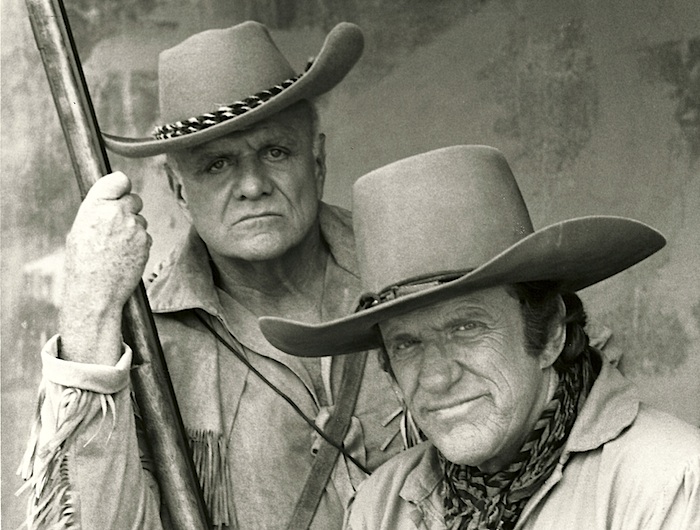
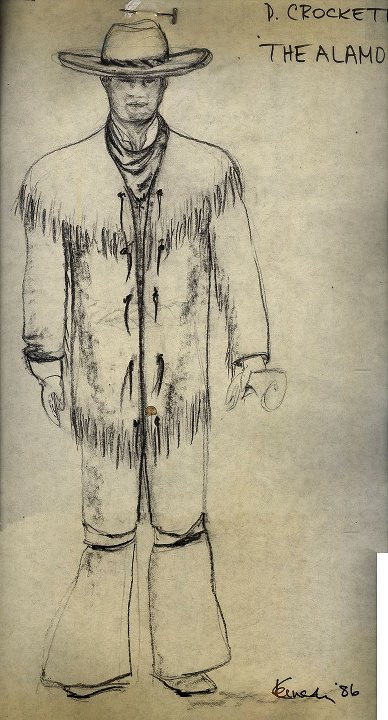
Fashion sketch for Brian Keith's Crockett in "The Alamo: 13 Days to Glory," signed by the costume designer Eileen Kennedy. (Collection of the author) |
The Alamo: 13 Days to Glory (1987) was directed by John Wayne friend and collaborator Burt Kennedy, with the idea that the film would be an alternative version of the battle compared to Wayne's 1960 version. John Wayne's youngest son, Ethan, even played one of Jim Bowie's volunteers. The film, shown over two nights on broadcast TV, starred James Arness (An August 5, 1959 Hollywood Reporter news item reported that James Arness lost the role of Sam Houston to Richard Boone in Wayne's film), Alec Baldwin, and Brian Keith (Uncle Bill from Family Affair) who played Crockett. Keith was about 20 years older than the real Crockett at the time of the battle. They decided to dress him like Wayne's Davy, right fown to the historically inaccurate wide-brimmed cowboy hat (see photo at right).
About this time, a nation-wide controversy arose over how Davy died at the Alamo, based on a claim made in the book La Rebellion de Texas — Manuscrito Inedito de 1836 por un Ofical de Santa Anna, purportedly the memoirs of José Enrique de la Peña, who was an officer in Santa Anna's army. The book was originally published in Spanish by Jesus Sanchez Garza in 1955. The book claims that Crockett had survived the siege and was either captured or surrendered. He and several other prisoners were then brought before Santa Anna. General Manuel Fernandez Castrillón attempted to intervene on the men's behalf, insisting their lives be spared. Santa Anna ignored Castrillón's plea and ordered Crockett and the others executed regardless. Although many of Santa Anna's officers were outraged by this order, Davy was summarily killed with the others. Since the book was published in Spanish, it caused little stir during the Crockett craze of the 1950s. But then it was translated into English in 1975 by Carmen Perry, who was formerly the librarian of the Daughters of the Republic of Texas. Her former job did little to protect her from angry Alamo fanatics who asserted that Davy would have only gone down fighting. They harrassed her with angry letters and anonymous late-night calls. The media wasn't much kinder: One article said that the book reports Crockett's last moments as, "grovelling in the Alamo corner." Meanwhile, People magazine ran a story on October 13, 1975, juxtaposing a photo of Perry with one of John Wayne, titled (incorrectly) "Did Crockett Die at the Alamo? Carmen Perry Says No!"
While that book sparked debate and criticism from many Alamo enthusiasts and some historians, it was nothing compared to the response for a book that followed called How Did Davy Die? by Dan Kilgore, published by Texas A&M University Press in 1978. The first book featured only a page describing Crockett's capture and execution, while this was an entire book on the subject. ("Them's Fighting Words; Davy's Legend Smudged," read the headline in the Corpus Christi Caller-Times, Kilgore's hometown newspaper.) The book compares de la Peña's account of Crockett's death to contemprary descriptions of the battle by six other Mexican soldiers, in an intentionally dispassionate, analytical manner (but all that being unemotional did for Kilgore was get a bunch of Crockett loonies to threaten his execution; it must have been pretty easy for him to identify with Davy barricaded inside a crumbling fort against a hostile army).
Despite all of the evidence and the ensuing publicity (and supposedly being an alternative history), the makers of The Alamo: 13 Days to Glory decided to have Keith's Davy go down swinging just like Wayne, anyway. In the end, they presented a John Wayne film with less style and no John Wayne. Still, the miniseries won an Emmy for Outstanding Cinematography For A Miniseries Or A Special — but the battle scenes were filled with footage lifted from The Last Command.
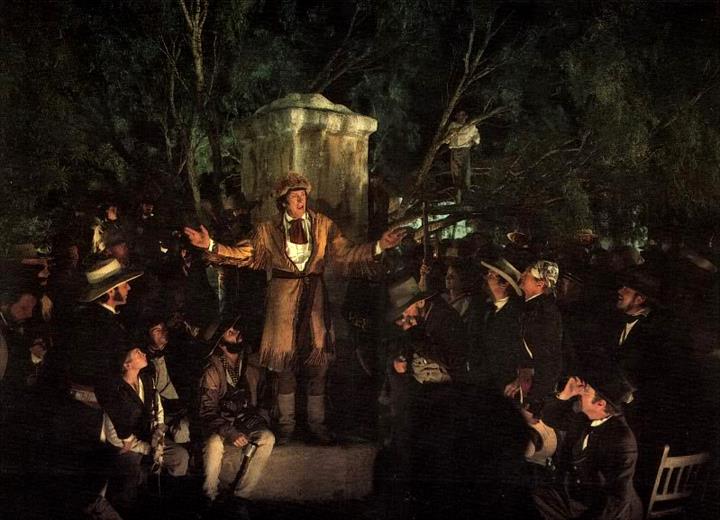
Also skipping the great Crockett death controversy was 1988's Alamo: The Price of Freedom, an IMAX movie that only shows near the Alamo in San Antonio. (I'm not sure about Freedom, but the Price of IMAX is pretty freaking high.) The film was made partially with state funding, and Crockett is played by the much-too-old brother of the then-Governor of Texas. (Gosh, I wonder how he got the part?)
Merrill Connally was a six-foot, four-inch, fifth generation Texan. The tall rancher, whose business interests were centered near San Antonio, made his acting debut with Goldie Hawn in The Sugarland Express, the first major film directed by Stephen Spielberg. Connally, former County Judge of Wilson County, recalls, "These Hollywood people were traveling through Texas preparing to film The Sugarland Express. They needed a tall, white haired Texan to play the foster father of Goldie's baby and someone led them to me." Spielberg later called him to play the leader of a military team preparing the first station for spacecraft landings on Earth in Close Encounters of the Third Kind. Recounting a part-time acting career that has never required him to leave Texas, Judge Connally remembered, "They called me to do something entitled Jaws, but I turned them down. I didn't see how a movie about a shark terrorizing a beach could amount to enough to warrant leaving the ranch!" Connally said at the time, "Thanks to Walt Disney, Crockett may be the most famous of the Alamo defenders, but they were all heroes equally. It would have been an honor to play any of the men because, hopefully, this film will outlast all of us who made it and inspire future generations to guard our special way of life." This Crockett goes down fighting, as well. Actually, three Crocketts go down: Connally was replaced by a stuntman in the battle scenes, and still another guy stood in as Davy when Connally just couldn't make it to the set.
"New findings by scholars indicate he may have survived the Alamo. I don't know if that's true, but I have a script treatment for what might have happened to Crockett if he did survive — purely fictional, set 25 years after the Alamo. The people I've shared the story line with have almost all found it fun and interesting."
—Fess Parker, quoted in "It's Rumored Davy Crockett survived the Alamo," by Jeff Weingrad, New York Daily News, January 8, 1987 |
After starring in, producing and sometimes directing the Daniel Boone TV series, Fess Parker had purchased a house overlooking the Pacific Ocean — which promptly fell down the cliff, into the water. He then liked to tell people that he took a career change into the wine business mainly because he was "homeless and unemployed."
But filmmaking, and Davy Crockett, were still on Parker's mind. He began crafting a scenario in which Davy was captured at the Alamo and actually survived the battle, without execution. He tied his scenario to newspaper reports contemporary with the battle, that claimed Crockett was working as a slave in the mines of Mexico. Parker mulled over the project for years, "But he never put pen to paper," said his daughter, Ashley Parker Snider. It involved Davy and Georgie escaping from the mines and riding off into new adventures. Author Frank Thompson remembers Fess telling him the proposed story, in which Davy and Georgie meet the pirate Jean Lafitte, among other adventures, then end up back in Texas where a monument is being erected to the great martyr Davy Crockett, and decide that — as far as the public goes — maybe Davy does more good being dead.
But Fess had precious little time for movie development — he was busy with real estate, hotels and winemaking, having diversified like his mentor, Walt Disney. "That 'Be Sure You're Right, then Go Ahead' thing — he took it to heart," Ashley said. "Especially the 'Go ahead' part" added his son, Eli. Parker expanded his winemaking business, opened luxury hotels and Inns, and never fell back into filmmaking.
But other people were pursuing a new Crockett story for the new generation.
"It's gonna be a drama, yeah, but the thing is that Crockett was not like Disney portrayed, or John Wayne. He was really a zany, crazy guy, like a Will Rogers type of guy. And he was popular because he went out and told the truth, no matter who it offended. His downfall was that he wouldn't compromise, and he wasn't really a very good congressman because he got nothing done for his district. And that's why he was defeated in his election and had to go to Texas, where he became involved in this big real-estate scheme; they were gonna take over Texas from the Mexicans and make it part of the United States. It's basically the same thing Daniel Boone did in Kentucky, which was all land speculation. It's kind of been handed down to us as a whole different thing; he wanted to be president one day, but he got trapped at the Alamo and couldn't leave because of his legend. Davy Crockett couldn't be seen to have escaped from the Alamo, and that's what I see as interesting about it—just to tell the truth about Davy Crockett."
—David Zucker, quoted in an interview with the Onion AV club in 1998 |
Paramount's Naked Gun 2 1/2: The Smell of Fear (1991) was not a Crockett film at all, but director David Zucker plays Crockett in a cameo. Also, in the prologue of the film, the main character is at a White House dinner, and all the art decorating the walls is of Crockett — pieces from Zucker's massive Crockett collection. If only the real Davy was around to see the sweet irony in that moment. His collection also shows up in other films he directed, like My Boss' Daughter and Scary Movie 3.
Zucker was a long-time Crockett fan. He told In Focus in September of 2003: "He was the Will Rogers of his day. He was a humorist — he was like Groucho Marx. He was zany and funny — a celebrity." Zucker said his obsession started, "just from the Disney television show back in the mid-'50s. I've always been interested in him. Then, in L.A. in the mid-'80s, I re-connected with some people who were also interested in him — and they introduced me to the national organization that was interested in the Alamo and Crockett and Bowie and Travis and all of those characters; they put out a little magazine called The Alamo Journal. And then I host a big 'Crockett Rifle Frolic' on my ranch in Ojai; every two years, we have one, where everybody dresses period — artisans, craftsmen, historians, teachers, gun nuts. I became best friends with the guy who's the editor of Guns & Ammo... And then I had all my entertainment-business friends over there — so it made for an interesting combination."
But Zucker wasn't through with Crockett. He developed a Crockett script for a film biography, rumored at various times to star Robin Williams, Mel Gibson and Tom Hanks.
The project, Crockett (Alternate Title: Sunrise in His Pocket) follows Crockett's son, John Wesley, after he reads a letter claiming that his father actually survived the battle of the Alamo and is working as a prisoner in the mines of Mexico.
Taking leave of Congress (where he is finally about to pass his late father's long-stalled land bill), John Wesley retraces the journey of David to Texas, and finally into Mexico. He learns more about his father through the stories of others (Thomas Chilton, Louis Rose), to finally uncover David's ultimate fate. The Chilton character especially stands out. An important person in both Crockett's life and in the building of his legend, he has never been used in Crockett fictions. Chilton has the strongest part in this story, gets fantastic dialogue, and carries the story in the kind of role that Charles Winninger once excelled at in screwball comedies.
This script also revives the character of Georgie Russell⁵ from the Disney films (and a brief mention or two in David's autobiography). It was written by Zucker, Crockett historian Paul Hutton, and Robert LoCash, who wrote the screenplays for Zucker's BASEketball, High School High, and Naked Gun 33 1/3: The Final Insult. A host of other writers would each take a crack at the script in the ensuing years.
| ANGLE - ANOTHER PART OF THE FOREST |
|
|
|
| RESUME - CROCKETT AND RUSSELL |
|
|
|
| EXT. FOREST - LATER SAME AFTERNOON |
|
|
|
|
|
But the project stalled. Zucker told Onion AV Club in 1998: "The problem is that what the business is nowadays is... This is the drill: You have to write a script, and once you have Tom Hanks, Harrison Ford, Jim Carrey, Bruce Willis, or Tom Cruise, you can shoot anything you want. But you first have to bring back the broom of the Wicked Witch Of The West. The first thing you do is write a script that will attract an actor, and that will get you... I think that doing the Davy Crockett script will involve probably a two-and-a-half-hour movie, and the budget is going to be at least $50 million. So that starts running into money. That means you need a major actor. But there are always people coming up."
However, another view of history, legend and heroism appeared in the years after Vietnam and the first Iraq war. Americans began to question our role in world politics, and their own history. Thought-provoking books by revisionist historians like Richard Slotkin and Andrew Saxton questioned the validity of the frontier legends like Crockett and Boone, arguing that they were all myths created to rationalize the repression and exploitation of Native Americans, Mexicans and other ethnic groups. Slotkin's award-winning trilogy on the myth of the frontier in America, which comprises Regeneration Through Violence, The Fatal Environment, and Gunfighter Nation, offers an original and highly provocative interpretation of the national experience.
Meanwhile, movies like Unforgiven deconstructed preconceived notions about the west. So Crockett would need to be handled differently than before: As Zucker told In Focus: "You know, [Davy Crockett's] a very hard story to tell, because people's lives don't fit neatly into a three-act structure. His first wife died, and his second wife, it's questionable whether he even lived with her…. It's tough. There's a struggle to, on one hand, make good drama, and on the other hand, to tell the truth. And I don't just want to do anything that's going to be some kind of fiction... The way to do it may be to portray Crockett telling it himself — because that gives me deniability. Then it would be Crockett putting a little frosting on his own story — which I'm sure he would have done."
Zucker was still working on the script as late as September of 2003, when he told In Focus: "I think it needs a re-write; I still think that it could be a great movie. I think part of the problem is that was that the story that we devised was one of Davy Crockett and his son, and it was a split focus — the son got the big speech at the end of the movie, so that's kind of difficult to sell to a major star. I'm anxious to see 'The Alamo' — that's going to have Billy Bob Thornton as Crockett... I think I'll enjoy the movie because I love that era of history. It may have an effect on my plans — whatever I do with Crockett. This is something I've been working on for 15 years."
Meanwhile, yet another 'Davy-escapes-the-Alamo' script was making the rounds, as the Boomer generation continued to grapple with the trauma of watching that last Disney show on TV in 1954, and trying to fix history:
"'Naked Gun' collaborators and longtime pals Pat Proft and David Zucker have competing Davy Crockett projects, sort of by default. Last week, Proft called Zucker — who has long been developing a movie about the king of the wild frontier — to inform him that Proft and Neal Israel had sold a more-than-a-decade-old script called 'Davy Crockett After the Alamo' to Rocket Pictures, headed by Jon Turtle and Tom Coleman. DISH heard that Zucker, who would not talk to us, was upset. Proft, who's at Fox readying 'Hot Shots Part Deux' for a May 21 release, admitted it's a 'strange thing that suddenly this happened, but I'm sure it won't hurt either project.'"
—"Dish" column of Variety on Tuesday, March 9, 1993 |
Davy Crockett After the Alamo (unproduced) was a spoof of Walt Disney's original Crockett series by the makers of Bachelor Party. The script was originally written in the 70s by Neal Israel, Pat Proft, Mike McManus, and Tom Sherohman, with the story credited to those men and Leonard Ripp. It explores what might have happened if Crockett had survived the Alamo siege. The script starts off as a social commentary, meditating on the nature of heroism and celebrity, but quickly turns into an Airplane-like spoof of Crockett and the Alamo films, and westerns in general.
The screenplay opens with Davy and Georgie Russell hurtling their way through the Mexican troops into the Alamo, as a chorus sings a variation on Disney's Davy Crockett theme song. Once inside, Bowie and Travis reveal that the Texians are hopelessly outnumbered. What follows is a good example of the film's style of humor:
| (yelling toward the Mexican camps) |
The film was nearly produced in the 1990s, as reported in the "Dish" column of Variety on Tuesday, March 9, 1993. Proft and Israel's script, which Rocket optioned for six months for $100,000 against a $1 million purchase price, is "a western spoof (aka The Naked Gun of Westerns) , while Zucker's is a straight dramatic treatment of the Crockett story."
Proft said his and Israel's late '70s script, also written by Mike McManus and Tom Sheroman and Lenny Ripps, is a satirical spoof "based on the truth that Davy Crockett did not die at the Alamo." The story finds Crockett awakening among the dead heroes to become a national figure.
As part of the deal, Proft and the other writers have agreed to contemporize the story, possibly spoofing some of the modern westerns like "Unforgiven" (which Proft said he hasn't seen yet) and "City Slickers."
| EXT. COURTYARD - THE ALAMO - LATER THAT DAY |
|
|
| EXT. PLAINS OUTSIDE THE ALAMO - LATER |
|
|
|
6: REVISIONISM
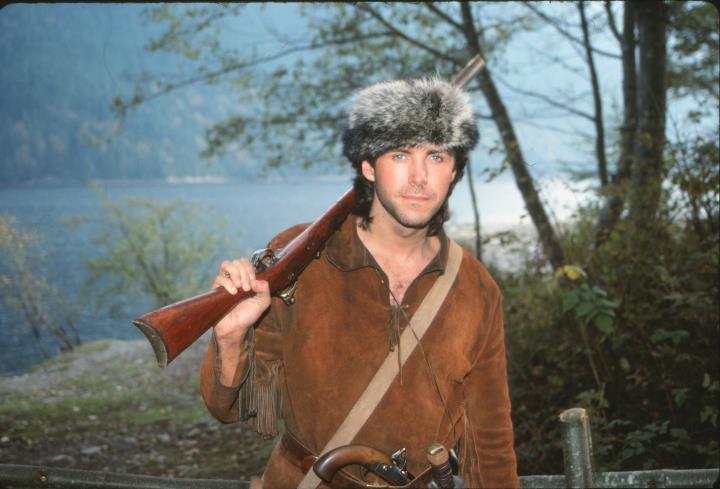

Collection of the author |
Disney revived Davy in 1988, when the company began a new anthology series on NBC, called "The Magical World of Disney". The strategy was to air continuing stories throughout different seasons, like the Crockett legends and remaking old Disney fare like The Shaggy Dog, The Absent Minded Professor, and cheap sequels like Splash Too.
During the 1980's, "political correctness" swept through the nation like a plague of neutered horny toads. (How Crockett-y does that sound?) This series therefore had a much different tone, however, than the series from the fifties. "In the 30 years since the first shows, we've become much more aware of ourselves," said writer/producer William Blinn. "Crockett will have a broader vision, and he'll have a more responsible attitude toward minorities." Blinn had worked in a lot of TV, creating shows like Starsky and Hutch, developing Eight is Enough, and writing the TV movie Brian's Song. He had written for Western TV shows like Bonanza, Rawhide, Custer, High Chaparral, and David Carradine's short-lived TV version of Shane.
The first show in the new Crockett series, Rainbow in the Thunder (Nov. 20, 1988), was a 2-hour film (the rest of the episodes were one hour) directed by the legendary David Hemmings, who rose to fame as the star of Michelangelo Antonioni's Blow-Up (1966), and Captain Nolan in Tony Richardson's The Charge of the Light Brigade (1968). Hemmings had formed the independent production company Hemdale Corp. with his business partner, John Daly, in the early 1970s as a tax shelter. After producing and directing Just a Gigolo (1978), and the 1981 adventure film Treasure of the Yankee Zephyr (1981), he focused on TV directing. He soon became one of the top directors of American action TV programs, including Airwolf, Magnum, P.I. and Quantum Leap. He once joked, "People thought I was dead. But I wasn't. I was just directing The A-Team."
Dunigan tried not to compare himself to Fess Parker — but the real David Crockett was fair game: "I saw a contemporary picture of him, and he was an ugly man... Boy, was he ugly! He was like a bad dream. Maybe he was just unphotogenic, but I would have shot the artist." ("Hot Line," by Frank Sanello. Lawrence Journal-World TV Update, November 13-19, 1988, Page 4) Noting that the first episode was about the Creek Indian War, he hoped the subsequent episodes would feature other aspects of Crockett's life: "I don't want to be killing Indians every week." (Ibid.)
Disney couldn't decide if they were shopping a new Davy Crockett to a young audience, or the 50's Davy Crockett to their parents: The original plan was to start the film with Fess Parker as an older Davy on his way to the Alamo, and have him meet up with Andy Jackson at the White House to exchange war stories. In doing so, Disney's original Davy would introduce the new actor playing a younger Davy (Dunigan) in flashback — but Fess backed out at the last minute, and was replaced by Johnny Cash... which kind of defeated the whole point of the flashback motif, and made audiences wonder if the star of the new series was Cash or Dunigan.
| EXT. WHITE HOUSE VERANDA — ON OLDER DAVY CROCKETT — NIGHT
Late forties, his face still taut with that indefinable mixture of laconic assessment and determination. Though that's somewhat diluted by the glazed emptiness of his glaze. Not empty of tension, but of awareness of present surroundings. He's looking out into the darkness of the night and seeing things normally glimpsed during a restless slumber which was preceded by a soufflé of bad salmon. |
Cash supplies dignity and authority to the character, if not the familiarity that Fess would have given to the continuity of the series. Without Fess, the wraparound does nothing to help us accept the new Crockett.
Jackson plies Crockett with liquor and tries to sway him on the latest Indian Removal bill (which follows the continuity of the old Crockett series, but seems kind of pointless here, as he's just driven Crockett out of office). As they imbibe in rotgut, they recall old times, and we finally meet Dunigan as the Young Davy Crockett, through flashback:
| YOUNG DAVY CROCKETT stands at the forefront of a group of ragtag Tennessee mountain MEN, most of them in their early and middle twenties, thin as whipcord, strong and at ease in this boundless terrain. If there's a difference in these young faces as contrasted with young men of a contemporary mold, it is the lack of selfdoubt. They've survived more than two decades in this brutal and beautiful land and that survival has taught them their worth. No arrogance here, but a good deal of appealing confidence. Davy steps forward to Lute, the easy grin on his tanned face testament to his acknowledged leadership of this ragged band. |

Dunigan recalls the experience of playing Davy fondly, especially working with Gary Grubbs as Georgie: "Gary Grubbs was and is, one of most gifted and giving actors in the business, and that doesn't even take into account that he is just a great guy. He was the source of many a fun day on the set for me, and was by far one of the best guys I've ever worked with." Collection of the author |
We then meet Georgie Russel (Gary Grubbs), who is older than Davy, and arriving from Georgia: "Middle thirties, a dark coating of stubble covering his rugged features. The manner is low-key and doesn't push, because there's enough strength and steadiness there not to need to push in order to get done what needs getting done." Davy and Georgie are meeting for the first time, which veers off from the continuity of the earlier series, in which Crockett and Russel were racing keelboats on the Mississippi River in 1810 — so he's not like Buddy Ebsen's character or the real George Russell.
Davy, Georgie, Lute and the other volunteers meet up with Andy Jackson (a colonel in this story, played by Matt Salinger), and fall in line behind the regulars. As they march, they run into a pioneer family that has been attacked by Creek Indians, including a beautiful girl named Ory Palmer (Cheryl Arutt).
Davy is elected sergeant by the volunteers in a near unanimous vote — except for Georgie, who thinks Davy is too foolhardy. Proving Georgie's point, Davy confronts him and takes him into the woods where they are about to square off, when they discover Ory skinny-dipping in the river — a sight they enjoy until spotting some Creek Indians on the other side of the river. (Nudity in a Disney show? What would Walt say!!!) Davy saves the girl, but in the end can't save the Indians, who are massacred by the younger Jackson and his troops.
This leads to the slaughter of an Indian village by Jackson's men. It is intimated that this is the battle of Tallusahatchee, as Davy tries to stop the fighting and we hear the screams of women and children. But Lute brings up the Fort Mimms massacre, and Davy follows him into the village. We don't see Davy shoot them down "like dogs" or eat potatoes stewed in human fat, but we do cut back to Old Davy in the White House, saying, "First time being good with a long rifle ever gave me pause." Old Davy and Old Jackson then argue over the events of that night — Old Davy saying he just wanted to defeat the Creeks, not wipe them off the face of the Earth, which was neither "possible or productive. Same reason I'm against this Indian Bill you're trying to ramrod through the House."
Just then a woman on the White House staff enters the room named Delia, who is the exact image of Ory (and is also played by Cheryl Arutt). It turns out she's Ory's daughter, and Ory is a staffer, too!
Old Davy tracks Old Ory (Samantha Eggar) down in the White House kitchen, where she recognizes him instantly (a good trick since Old Davy's six inches shorter than Young Davy). He tells her about his second wife, Elizabeth (in a rare mention in Crockett films). Ory is visibly disappointed that he has remarried, and we learn that they had a history together during the war. It turns out that Davy had to let her down then, too, because he was married to Polly.
The film then seems to lose course. Suddenly Georgie knows Davy so well that he's singing the Davy Crockett theme, and a jealous Lute goes from comic relief to villain: the Indian massacre has unhinged him. He disguises himself as a Creek warrior and kidnaps Ory, whom he plans to offer her to the Creeks in order to stop the war.
Davy tracks them alone to a cabin, where Lute is killed by Creek warriors surrounding the building. Then, in a nod to the TV trends of the time, Davy does an impression of MacGyver: He pretends to shoot Ory in front of the warriors, then buries her as they watch, placing a wicker basket over her head out of their view as a sort of oxygen tank before covering her in soil; he then goes back into the cabin, slathers himself in grease, sets the cabin on fire, then busts out of the cabin, knocking the Indians over like a greasy pinball, and running down the hill.
We the script gives us the one great comic bit of the show that truly captures the tone and creativity of the original show — and it's with Georgie Russel (as it should be) who has gone AWOL from the army in order to help his new friend. He tracks Davy, who suddenly runs past him, pointing behind him. Georgie turns to see the pursuing Creek warriors, headed in his direction. Georgie then runs to catch up with Davy, and sees Old Betsy left behind on a cliff overlooking a raging river. Georgie follows his friend over the cliff in true Butch and Sundance-style — then as he jumps looks up to see that Davy is actually hiding in a tree, and has only staged the jump. Georgie falls to the water far below, cursing the whole way. (I wrote that the script gives us this bit because unfortunately, the stunt wasn't used in the broadcast show.) The Creeks think Davy has escaped down the rapids and leave. Davy climbs down and returns to the cabin to unearth Ory.
We then return to the White House in 1836, and Davy is saying his goodbyes, about to meet up with Georgie and head to Texas. As Davy leaves, Ory tells him, "A man like you needs to know the thunder and lightnin'. A woman like me, well, we just come out with the rainbows, just in time to see you move off toward the next storm, the next batch of thunder." With that, Old Davy heads down the long White House corridor, and the scene dissolves to Young Davy heading into the wilderness, the Davy Crockett theme blaring in the background. Proving that Hollywood never learns from its mistakes, Disney went from prematurely sending their hero to his death at the Alamo in the third episode of the original series, to doing it in the FIRST episode of this update!
The critics seemed to like it: The Los Angeles Times reported that, "the show is solidly crafted by writer William Blinn and director David Hemmings." But the Orlando Sentinal was unimpressed: "The new Crockett, which premiered Sunday and will return periodically on The Magical World of Disney, is a crock, a mishmash of 19th-century history and 20th-century attitudes. How the West Was Won, according to (Phil) Donahue." But People Magazine gave the show a 'B', saying: "The new series does a good job of raising Davy's consciousness without turning him into a dullard ... what's clear is that this Davy, like the original Davy, manages to be a show for kids without looking like a show for kids. It's not twinkie like an afterschool special. It has drama and excitement like a real show. It is a real show." Variety agreed, saying; "Old Hickory... doesn't much resemble himself, young Davy Crockett (Tim Dunigan) at times strains too hard to be verbally colorful, and the Creek Indians seem a trifle silly in this version, but that historical figure of early 1830's, one-time Disneyland character who thrived on ABC 1954-55, jumps into another series. The quality returns with it, and, despite some historical nitpicking, should do well in its allotted spots."
More shows followed, sans-Cash, all centering on Crockett during the Creek Indian War. Dunigan recalls, "What was really nice was after the initial two hour film, I felt like the writers were starting to write for me, so it fit, it felt like a glove. I wasn't churning for lines anymore, the lines fit myself, they started watching the character, they started understanding the character that I was choosing to play and they kind of wrote for that character which made it a lot easier."
The next episode, Davy Crockett: A Natural Man (broadcast 18 December 1988), was directed by Charles Braverman (who went on to become an Oscar-nominated documentarian) and written by Steven Baum and Neil Alan Levy, who had just worked on Dirty Dozen, the Series and The Munsters Today. While on a scouting mission, Davy saves Georgie's life when he's attacked by a Grizzly Bear. Davy first tries to shoot the massive beast, but his rifle misfires — leaving Davy with only his vocal cords to scare the bear away (and missed a great grinning call-back to the first episode in the fifties). They then discover Davy's uncle Jimmy (Barry Corbin), who had vanished over 20 years previous after a Indian raid, but now lives with the Creeks. Davy and Georgie bring Jimmy back to camp, where his stories of Indian life inspire a group of soldiers to search for gold hidden by Jimmy's tribe, but they're ambushed by Creek warriors — one of them being Jimmy's half-breed son, Logan. When the army attacks the village for retribution over the ambush, Georgie captures Logan, but Davy lets him go free. (On a side-note, James Crockett was the real David's uncle, and was indeed captured by Indians during a raid. A deaf mute, he was spared by the attackers, who killed David's grandparents. David's father, John, and his uncle William actually discovered James eighteen years after the kidnapping, and negotiated his release (the real David was just a small boy at the time). David describes in the Narrative how he would assist his uncle in the woods, where they would try unsuccessfully to relocate the gold and silver mines in which the Indians had once hidden James. No mention of a son, though.)
That was followed by Davy Crockett: Guardian Spirit (13 January 1989), directed by Harry Falk (who also directed episodes of Dynasty) and written by Trapper John, M.D. scribes Deborah Gilliland and Robert Sonntag, which was shown on a different night in order to find an audience that the Disney anthology programs weren't bringing in in the normal timeslot. In this story, Davy finds soldiers preparing for an attack by massing Creek warriors. He explains that the Indians are actually gathering for a religious ceremony, hoping to prevent needless bloodshed. But Major Benteen (Garry Chalk) sends Davy and Russell to search out the location for an attack, but Davy just plans to tell him he can't find the location, but then has to save an Indian boy (Evan Adams) from a wolf during a ritual gone wrong, and they take him back to the army camp. The boy is imprisoned, but Crockett lets him go (you'd think the army would start doing something about all of these Creeks that Davy is letting escape). Soldiers chase after the boy and run directly into an ambush. Crockett is wounded and feigns blindness, allowing him to return the boy to his village.
In Davy Crockett: A Letter To Polly (11 June 1989), also directed by Harry Falk and written by Paul Savage, Davy is distracted with homesickness for his wife and kids when he's almost killed while out scouting with Georgie. He requests family leave when he returns to camp, but is denied by Major Benteen, who needs Davy for an upcoming raid. So Davy volunteers to get supplies from a nearby fort, hoping to get a letter sent to his wife Polly. Along the way he has to help a stranded settler and deliver a Creek baby. With these distractions, he fails to get the letter sent, but makes it back to camp in time to avoid a court martial.
The last show, Davy Crockett: Warrior's Farewell (18 June 1989) was directed by James J. Quinn (who also directed episodes of Miami Vice), with another script by Blinn. The story starts with an Indian medicine man standing over the soldiers' encampment chanting spells while an earthquake strikes. The camp is soon full of rumors about this Indian's power. Meanwhile, Davy works in camp with a man named Callahan, who plans to shoot the Indian with a new Ferguson rifle. Davy destroys the rifle in the Indian Village (not Old Betsy!!!), and the Creeks are so moved by his act of good will that they move for a peace treaty.
Sadly, despite strong promotion, the show quietly disappeared on NBC-TV after the original five episodes had aired, along with the entire anthology format, which was dumped in 1990. The New Adventures of Davy Crockett seemed more intent (in both story and style) on copying conventional '80's TV action fare of the time than to tell the story of David Crockett—it came about as close to the original series in humor and storytelling as, well, as Johnny Cash's acting does to Fess Parker's. Beyond sending the character to his doom at the Alamo in the first episode, the revolving anthology format made it too hard for the show to build a dependable audience, going weeks between airings, and the show ended after six episodes, along with the entire anthology series.
The show also never emerged from the mouse-eared shadow of Disney's iconic fifties series with Fess Parker—even to Dunigan: "Fess Parker is the guy, I mean he's Davy Crockett, that's who we all remember, and he's Davy Crockett to me too. Even when I played the role, I thought of him." To this day, however, Dunigan still keeps the buckskin outfit he wore: "I got the whole buckskins, yep I got them in my closet. Yeah, you know you hang on to that kind of stuff, I had a guy offer me about three grand for them one time. I told him no way, no way I'd never sell it, that's mine, its part of my history. When I die you know, maybe they'll bury me in it!"
Strangely, Disney (which loves to repackage its old shows and movies) has never released this series via tape, disc or streaming in the United States—even as an extra to the original Crockett series. (Could it be because the rights are tied up with another network?) Hopefully, they will one day correct this, and let the show find an audience.

Davy Crockett: Rabbit Ears is a remarkable 20-minute animated film released in 1992, written by James Howard Kunstler, illustrated by Steve Brodner, and voiced by Nicolas Cage. Add music by David Bromberg, and you have the best dramatization of the life of Crockett in many years.
Not only does it work as an entertainment, but both the book and film capture the frontier brag better than just about any other representation of Crockett. The writing is true to the old Crockett storytelling traditions, but doesn't just repeat the same old copy from the almanacs: Crockett's words seem to spring organically from the situations—he's a fully realized character. Kunstler did a great job of capturing the frontier brag: "I picked up the rhythm and flow of the Crockettisms like a kind of music. Yes, I did a lot of research. A long time ago — 1984 — I wrote a comic novel set in the Southern US frontier in 1805 (An Embarrassment of Riches, Dial Press/Doubleday) and I was reading all kinds of frontier material ranging from the annals of William Bartram, Alexander Wilson, and Audubon to the court proceedings of the Ohio River counties of Kentucky. I absorbed a lot by osmosis."
Illustrator Steve Brodner wrote after the death of Fess Parker: "About 20 years ago, I got to draw the animated Davy for Rabbit Ears Productions. He was voiced by Nicolas Cage, with music by David Bromberg. I wanted a new Davy and redesigned him for the fun of it...But Fess Parker is the Davy Crockett for all time, brave and decent all the way." He also noted, "Fess as Davy, like a lot of the cowboy heroes in movies and on TV, stood for moral values. These included caring for one another (Davy opposed the Indian Removal Act) as well as thinking before you act ('make sure you're right and then go ahead'). Such a liberal mensch. His values are still here, although they're hard to find. One place is in the history books where the great progressive tradition of social justice can be learned, from Jefferson to Lincoln to Roosevelt to King. Except in Texas, where the school board is blue-penciling history into a story concocted by the extreme right, celebrating Jefferson Davis and Phyllis Schlafly! That's in Davy's adopted home state, the one he died for at the Alamo. Davy would be a-gunnin' for those varmints, for sure. First, I think he would grin 'em out of countenance."
The highlight of the book is a perfect marriage of words and pictures: Brodner's Crockett rails against Santa Anna on the Alamo walls is beautifully rendered (his gift for savage exaggeration and color make the images in this story like no other work about Crockett), with Cage expertly bringing Kunstler's words to life. After his rant on the walls, he concludes: "The boys on the ramparts gave a yell of delight. But mostly, they were less frightened, A good round of brag almost always fortifies the heart." Those few lines (and a great drawing) say more than most Alamo films do in 2 hours. (It's available on DVD again and in book form—go buy it.)
On December 1, 1990, TV's Saturday Night Live even took a swipe—"Davy Crockett's Son" featured John Goodman as Davy, who is embarrassed of his nerdy son, Waldo (Mike Myers). Crockett has to explain his son away to Jim Bowie (Phil Hartman) and his rugged son Jed (Chris Farley), and Daniel Boone (Kevin Nealon) and his son, Hank (Rob Schneider).
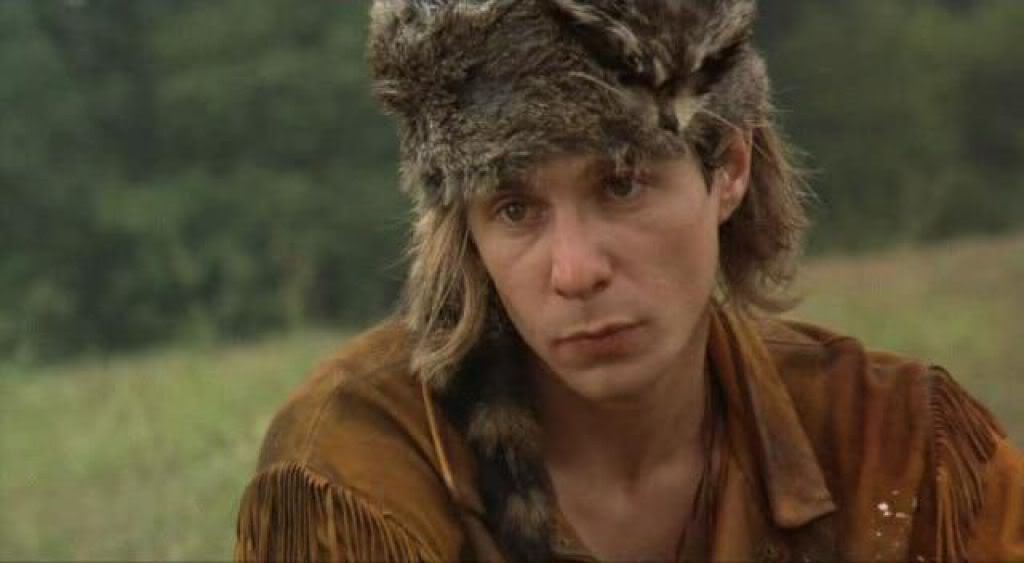
In the 1996 film, Box of Moon Light, Sam Rockwell plays a faux-Crockett—just a guy who lives "off the grid" wearing a Crockett outfit from a play reenactment—but who embodies a lot of the legendary qualities of Crockett that have been lost over the decades—that of a trickster and a wild man living in the wilderness, away from civilization. The story, filmed in Tennessee, revolves around Al Fountain (John Turturro), a middle-aged electrical engineer, who has a mid-life crisis and decides to take his time coming home from a business trip, rents a car, and heads out looking for a lake he remembers from his childhood. But his wandering takes him into the life of Buck, who likes to be called "the Kid," a free spirit with a Davy Crockett outfit (complete with buckskins and a coonskin cap) and a busted distributor under his hood. The Kid prevails on Al for a little automobile assistance, then tricks him into driving him back home and actually bankrolling him for a few days.
What starts out as a chance encounter turns into a several day odyssey. Al stays at the Kid's home—a trailer (or the front of one, anyway) in the woods where the Kid is "off the grid." Al sleeps on the kid's bed, underneath a bumper sticker reading "THE NEW AMERICAN FRONTIER." The Kid is like a reincarnated Crockett from the 19th Century a trickster, a creator of mischief; conning the Yankee; he lives deep in the wilderness, drinks when he shouldn't, makes grand pronouncements about the government like, "This country's being taken over by smart people with no common sense," but mostly is just out to have a good time. He explains why he wears the buckskins and coonskin cap this way:
AL
What's with the costume, Buck?
THE KID
How'd you know it was a costume?
AL
(feigning ignorance)
Is it?
THE KID
Yeah! Yeah! Yeah! I was an actor for a while, in this play about Davy Crockett, you know--
AL
--You played Davy Crockett?
THE KID
Yeah! ... No, I mean I played some guy standin' around with a rifle. But one night I tried on Davy's costume, and it fit me so perfect... I just took it...
The Kid is a free spirit, who encourages Al to bathe in ponds, drink bad liquor, steal food, shoot at stuff, and go to a bar and overall, just break the rules of polite society. Among the Kid's possessions is a box of moonlight (remiscent of Crockett keeping a bit of sunrise in his pocket).
"I wanted to bring two opposites together by accident and see what happens," DiCillo said. “I see the film as a kind of adult cartoon. It's exaggerated, it has slightly surreal elements, it's goofy. The human behavior is slightly exaggerated to tell this dented fable... Al and Kid represent the duality within most of us, DiCillo said. Most of us are Al, with his by-the-book approach to life. But deep down we wish we were Kid."
Tuturro was nominated for an Independent Spirit Award. The ensuing acclaim put him front and center with casting agents and new-found fans alike, with Rockwell himself acknowledging that "That film was definitely a turning point....I was sort of put on some independent film map after 10 years in New York." Janet Maslin of The New York Times called Rockwell, "this film's big find. The wiry, jubilant Kid wears a baggy Davy Crockett suit and lives in a backwoods amusement park of his own making. (Breakfast menu: chocolate cookies and milk in a dog bowl.) The Kid survives by stealing and selling ceramic lawn ornaments, among other pursuits, and something about prim, hopeless Al just tickles him."
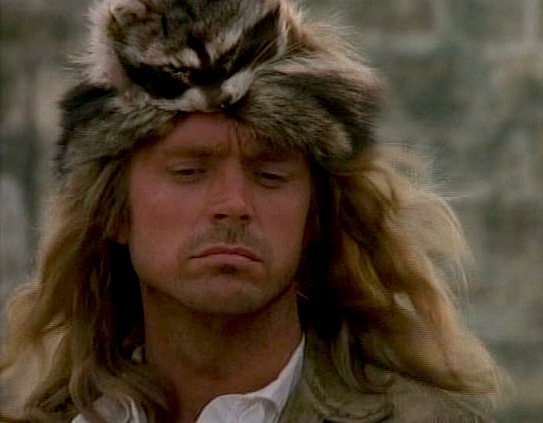
John Schneider playing the original Duke boy. |
Republic finally made one more film involving the Alamo, entitled James A. Michener's Texas, which premiered in the US on 16 Apr 1995, to celebrate the 150th anniversary of Texas' admission to Union. Davy is played by John Schneider, one of the Dukes of Hazzard. (Schneider has the distinction of having played both Davy Crockett and Sam Houston, in True Women.)
To spice up sales for the VHS release (VHS 9724), Republic added gratuitous shots of topless women, doing such dramatically important things as looking out of doorways after Santa Anna has walked through... this was done in order to, I suppose, appeal to adults who have never heard of buying pornography when they want to see nude women.
As the baby boomer generation aged from the 1950s to the 1980's, so did Davy's target audience. Films of the Alamo and Crockett were no longer being aimed at a youth market. Now they were aimed at an older, nostalgia-oriented viewer.
But all of that looking back to a simpler time was about to be challenged.
7: POST-MODERN WILDERNESS
"I really don't think it's possible to make a historically accurate Alamo movie. There are two primary reasons. One is all the things that we don't know about what happened. The other is the things that we do know. There are too many people pulling and tugging at the facts, trying to make political issues out of them."
—Dr. Ricardo Romo, president of the University of Texas at San Antonio |
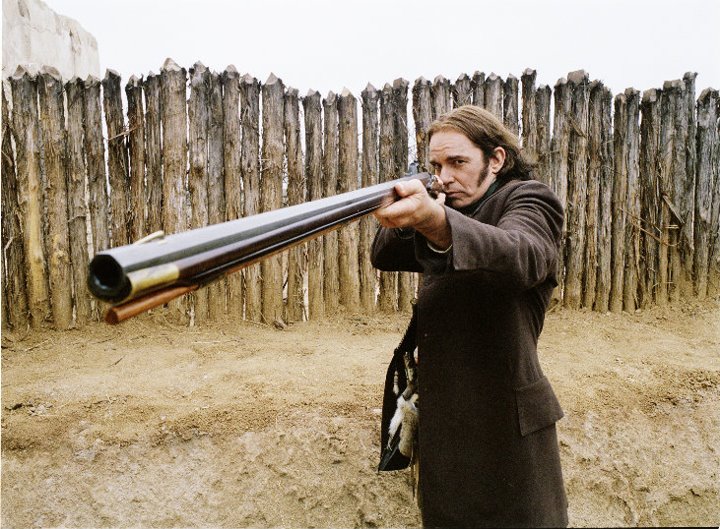

Billy Bob Thornton in 2004's "The Alamo." This is one of the only scenes where he wears the legendary Crockett garb. (Collection of the author) |
The Alamo (2004) starts off with an actor playing Davy Crockett onstage—and who should be watching in bemused silence but Crockett himself (Billy Bob Thornton as Davy Crockett watching Lynn Mathis as James Hackett as Nimrod Wildfire imitating Crockett—Crockett himself would have loved the layers of satire).
This Crockett was a post-modern meditation on his own legend. Mike Clark of USA TODAY wrote: "Reflecting decades of Hollywood's recycled reverence, The Alamo arrives in theaters just as John Wayne's eponymous 1960 epic is being reissued on DVD, and just two weeks after Fess Parker (or Davy Crockett to a generation) donated his coonskin cap to the Smithsonian. The torch is passed—when it's not igniting a cannon."
In fact, the film itself is an exploration of celebrity: After the opening, Crockett heads to San Antonio, where he's mistaken for Nimrod Wildfire (a man says, "I saw you onstage"); he asks Boewie about a historical murder and calls it the story "that got you written up"; and he dies watching his legend begin (a Mexican soldier watching Crockett's execution in a coonskin cap, etc.) and repeating lines from the play as he's bayoneted!
The original script, dated September 22, 1998, was written by Leslie Bohem. His writing credits include A Nightmare on Elm Street 5: The Dream Child, Dante's Peak, and Daylight. Bohem also played bass in the 1980s with the pop group Sparks. Bohem started with a "schoolboy interest" in the Alamo that was fired by Disney's original Davy Crockett and, later, Wayne's version. "But I always knew that the reality had to be more complex than what I was seeing on the screen. I started digging for more facts. It didn't take me long to realize that the Alamo was a major source of historical contention and that the debate is as heated today as it was 150 years ago. What drives you nuts is not that everyone seems to disagree but that you can often find conflicting accounts taken from the same sources."
In the mid-Nineties, Bohem met Randall Wallace, the screenwriter of Braveheart, at the Austin Film Festival. Wallace confessed had driven down to San Antonio to take a look at the Alamo, but said he wasn't going to do anything with the story (given how fast and loose Wallace played with history in Braveheart, this is probably a good thing), and Bohem decided that he would and set to work on a script. It occurred to Bohem that the time might be right for a new movie about the battle of the Alamo. He spent four years doing research on the battle. "The Texians who fought at the Alamo were a diverse bunch of men. There were patriots, who saw themselves as the heirs to the American Revolution, some of whom hated the idea of slavery; Davy Crockett, for all his faults, had a strong idealistic streak on the subject of fair treatment for other races. Some were scoundrels and pirates and slave traders; Jim Bowie trafficked in slaves. Not all these men were even there for the same political reasons. Some wanted Mexico to live up to its original constitutional promises, some wanted Texas to become part of the United States, and still others wanted Texas to become a separate country."
Bohem's script sets out to shock the reader, and begins with Crockett "torn limb from limb. Hacked, dismembered, eviscerated." Bohem told Scr(i)pt Magazine: "I started my script at the end of the battle. You see Davy Crockett, Jim Bowie and William Travis among the dead. I imagined that these would be the familiar faces of movie stars... To my mind, Crockett was a man forced by circumstances into becoming this legend that he traded on and resented, both because he suspected that people liked Davy a lot better than they would like him and because he was afraid that he could never do the same things that Davy was supposed to be able to do."
| EXT.
ALAMO COURTYARD - DAY | | |
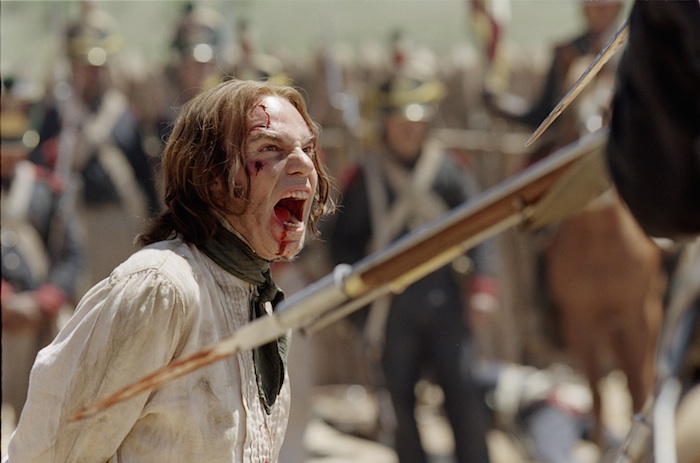
"Later, Americans would claim there was no surrender, that Crockett went down like Hercules, clubbing Mexican soldiers into a bony mash at his feet with the shattered stump of old Betsy. They would dress him up like Natty Bumpo in buckskin and a raccoon cap, put oaths on his lips and a dripping Bowie knife in his hands. They would name steamboats, railroad trains, frontier towns, and a marching song after him. They would anoint this day, March 6, 1836, the inaugural moment of Manifest Destiny. As it was, in the end, shortly after six o'clock in the morning, David Crockett made a choice. The Go Ahead man quit. He did more than quit. He lied. He dodged. He denied his role in the fighting."
—Jeff Long, "Duel of Eagles," 1990
|
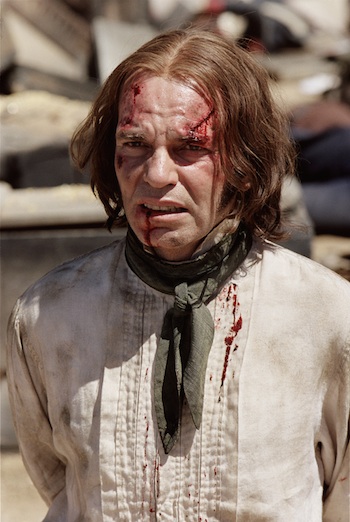
Collection of the author |
This version of the siege was the first to show Crockett being executed as a prisoner, adapted from the account written by José Enrique de la Peña (which reported that the defenders died courageously). It also has similarities to Jeff Long's book, Duel of Eagles, in which Crockett surrenders (with the now-famous line, "the 'go-ahead' man quit"), and then lies to Santa Anna about his reasons for being in the Alamo before he is executed. Bohem takes Long's idea even farther: Bohem puts Crockett on his knees, begging Santa Anna to let him live. He even adds a new wrinkle to the surrender theory: Not only can Castrillon speak English in this version, he winds up slitting Crockett's throat himself!
The script ends with a short scene taking place five days later in front of a cantina in the town of Gonzalez. Travis' slave, "Joe," and the other survivors roll up the muddy street in a wagon. A crowd gathers and they are greeted by General Sam Houston, described as "big man, dressed in a beaded Cherokee shirt, with large iron earrings in both ears, rings on all his fingers, and hair slicked back with bear grease. He looks drunker than Jim Bowie ever looked." Stepping out of the cantina, Houston says, "Tell me that Davy died taking at least a dozen of them with him. That he fired that rifle of his and then turned it around and used it for a club. That he beat the soldiers off until there was nothing left but the butt end of that old gun. They tell me that Davy died like a hero."
Bohem writes that Joe takes a long moment, noticing the people listening (who could possibly turn into a lynch mob if he gives the wrong answer), and replies, "Yes, sir. That's the truth. Davy Crockett was a hero. And that's exactly how he died." There's a "last moment of respectful silence," then the listeners begin to hoot, and slap each other on the back and say, "I told you so" as Joe and the others are helped away. Disney's Davy had come a long way from the fade-out of the Crockett mini-series in the mid-50's.
This version of the story may seem exceptionally violent and cruel to Davy-lovers (or anybody who doesn't appreciate scripts like Bohem's A Nightmare on Elm Street 5: The Dream Child), but it has to be placed into the context of the film business in the late 20th Century, in which screenwriters made their money off "spec" screenplays that they sold to studios. So it has to be considered that Bohem was trying to create a buzz, turn heads, and generate studio interest in his spec script — and the sensationalism worked. In 1998, Touchstone Pictures, a subsidiary of none other than Disney, and director Ron Howard became interested in the project and bought Bohem's screenplay. Howard may have liked the take on Crockett — or he may have been interested in the character because of his first film appearance in the 1956 exploitation film, Frontier Woman: Daughter of Davy Crockett. (Okay, maybe not.)
When re-writes were initiated, says Les Bohem, there was pressure to add fictional characters. "A producer said to me, 'Can't we have a romance where the girl leaves and the guy stays?' I just looked at him for a moment and asked, 'When does the iceberg hit the Alamo?'" There were five years of revisions to Bohem's original script, with millions of dollars spent on some of the best writers in Hollywood to revise the story, including John Sayles, Stephen Gaghan and John Lee Hancock (who also directed). And the character of Crockett changed with each writer's take on the story, in service to whatever themes that particular scribe was trying to convey.
The story also changed with world events during those five years, as its pre-production coincided with a terrorist attack killing thousands of US citizens, the resulting wars in Afghanistan and Iraq, and then the public questioning the wars, and the nation's responsibility to the rest of the world.
During pre-production, the September 11, 2001 attack on the World Trade Centre occurred, with thousands of Americans dying in the World Trade Center and Pentagon attacks. There was a surge of patriotism throughout the United States, and
Michael Eisner, chairman and CEO of the Walt Disney Company, now proclaimed that the film intended to "capture the post-September 11 surge in patriotism."
The new draft was written by John Sayles (who wrote and directed a very interesting Alamo-themed film called Lone Star in 1996 with the tag, "Forget the Alamo"), and the script became more heroic, expanding the story to include the entire Texas revolution, with the defeat of Santa Anna added to the ending. It evolved into a story about taking a stand, and the nature of war. Sayles' draft opens on the famous incident of Crockett watching James Hackett perform Nimrod Wildfire onstage in Washington. Crockett is described as "a well-dressed, pleasant-looking man in his late 40's watching the show." He has "a pained smile on his face, embarrassed but keeping up a good front." By the end of the screenplay, however, he has become Wildfire, and goes down fighting. As the Mexican troops surge into the Alamo chapel, "Crockett is smeared with gunpowder and blood, hatless, waiting." The camera tightens on his face as we hear the words of Wildfire: "I'm a ring-tailed roarer. I'm half cyclone, half snappin turtle with a dash of wolverine on my Mama's side..." The actor's voice continues as we hear applause — which is quickly drowned out as fifty Mexican soldados charge through the smoke, bayonets in hand, and the screen goes red.

The film was originally set up at Imagine Entertainment, with Ron Howard in the director's chair to make the film for Disney. In May of 2002, Howard assembled a group of eight Alamo historians in an Austin hotel, to get the historical truth. The historians present for that meeting were Stephen L. Hardin (historian, author and professor), Alan Huffines (historian and military expert), Frank Thompson (author of the book Alamo Movies), Jesús de la Teja, James Crisp, Andrés Tijerina, Bruce Winders, and Gates of the Alamo novelist and screenwriter Stephen Harrigan. Thompson said that he and the other historians "urged Howard for as accurate a retelling as possible." But Howard soon realized that when he asked a question to the eight historians, he would receive eight subtly different answers. "On some points, the authorities disagreed vehemently." However, Thompson noted that beyond history, every Alamo movie has the same problem: The hero and the villain never actually face off. Therefore, in terms of drama, Crockett and Santa Anna needed to meet face to face.
Stephen Gaghan, who had just won an Academy Award for Best Adapted Screenplay for the film Traffic, was the next writer to tackle the script. His draft enhances Sayles's vision by sharpening the characters and reinforces the fame/infamy theme. His revisions, dated 7/22/2002, don't introduce Crockett until page 31, when he adapts a scene from Sayles' revisions, in which Crockett and Bowie meet outside of town in a graveyard. Crockett's death isn't completely written in Gaghan's draft. The battle goes much as Sayles had written, with Crockett and a few survivors preparing for a last stand in the chapel. This time, we hear Crockett's voice reciting the bragging of Nimrod Wildfire as he becomes the legend, and swings his rifle as a club, mirroring the heroic last shots of Disney's version of the battle from the 1950's:
The script finishes in outline form, and argues that it's imperative for Crockett and Santa Anna to meet face-to-face, as in the original draft.
| Last point of business before leaving Alamo is to execute the three captives. See Crockett killed in a way, without gore, that emphasizes the stupidity of Santa Anna's mostly emotional need to teach the Anglos a lesson, it's just a toss-off, one word on Santa Anna's part, and a hero and good man is murdered, almost offstage, shots fired in the background or soldiers raising bayonets to begin hacking away... You don't have to see it directly, but this incident, with Crockett having been captured then killed horrifically, is about an eighty percent historical certainty. Why ignore it? It will really make us hate Santa Anna and root for Houston. |
According to Entertainment Weekly, Russell Crowe was originally cast as Sam Houston, and discussions were under way for Billy Bob Thornton and Ethan Hawke to costar as Davy Crockett and William Travis, respectively. Sean Penn was rumored to be playing Jim Bowie... but there were financial and creative disagreements between Imagine and Disney, particularly with Howard wanting a $200 million budget. According to Entertainment Weekly, as reported by Josh Young in August of 2002:
Fresh from "A Beautiful Mind," the Oscar-winning drama that grossed $171 million domestically, the trio made some pretty hefty demands, according to sources involved in the deal. They included salary guarantees of $20 million for Crowe, $10 million for Howard, and $7 million for Howard and Grazer's Imagine Entertainment — or 37 cents of every dollar that Disney collected from theaters, whichever was greater. (The studio declined to comment for this story.) While many stars command a share of so-called first-dollar gross, few companies have been willing to part with such a high percentage of a film's earnings — particularly one without sequel potential.
Disney apparently balked at both the production budget, which it hoped to slash to $105 million, and at forfeiting a whopping 37 percent of the first-dollar gross before recouping its investment. The studio also fretted about the international appeal of such a uniquely American story and Howard's desire to shoot bloody R-rated fighting sequences. Meanwhile, the "Mind" team held its ground. "Russell and Ron were wed together as an entity and as a loyal unit," explains Grazer. Translation: Without Howard in the director's chair, there'd be no Crowe on the marquee. |
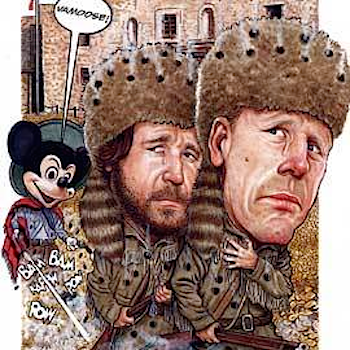
Illustration by Drew Friedman, for "Entertainment Weekly." |
So Disney rejected Imagine's proposal for the film, and Howard, Grazer, Crowe and Hawke left the project. According to EW, By the time That Howard and Crowe withdrew, Disney had already spent "more than $10 million building sets in Austin, and paying for script rewrites." The entire town of San Antonio was being rebuilt as it looked in 1836, on a huge ranch near Austin called Dripping Springs. There was no going back.
Disney and Imagine looked for another studio to share the cost, but there were no takers. Then Disney switched tactics, going forward with a projected $75 million, PG-13 Alamo under writer/director John Lee Hancock, whose first directoral effort, The Rookie, had been a surprise hit for the studio. Grazer and Howard stayed on to produce, but received a significantly smaller portion of the first-dollar gross (to say the least).
Thornton was the only member of the original team to remain throughout the project, in the role of Crockett. Meanwhile, Hancock, a reknowned script doctor, did his own rewrite, masterfully combining elements from all three of the previous scripts, while adding important elements to enhance the film's theme of fame vs. infamy, its character arcs, and story resolution.
By the time of Hancock's rewrite, the nation had very conflicted feelings about its role in the war caused by the terrorist attack, which revealed itself in a very conflicted Crockett. Billy Bob Thornton was the most authentic-looking of all the cinematic Davy Crocketts — dressed semi-respectably with the onlybit of flair being an Indian vest copied from one on display in the Alamo... which means that nobody watching the previews or TV ads even recognized him as the Crockett they had seen played by Parker and Wayne.
Billy Bob and Hancock succeed in making the myth a living, breathing man again, and in the process David actually becomes MORE heroic. In this version, he is now a brave, courageous, intelligent man trapped by his own fame, and forced to act out his own myth. You buy this David as a backwoodsman AND as a Congressman, and most importantly as a real man. Say what you want about whether or not Crockett's death really happened as portrayed in this film — Fess Parker⁸ and John Wayne would have killed (or more accurately, been killed) to play this scene. It is the emotional climax of the film, and all of the themes and storylines come together as the two main antagonists finally meeting face-to-face. We see:
- Heroism: David Crockett is on his knees, bound, unarmed, and battered. Before him stands Santa Anna and a thousand Mexican soldiers, as well as a squad of executioners with weapons drawn, ready to impale him on their bayonets. David is given the translation and surveys the scene. Crockett had earlier said that other politicians had made "good sport" of him, but they had taught him how to speak and present himself. All of that has been stripped away, here. A bloody, battered Crockett's shirt is in tatters and his hands are bound, and a self-satisfied, triumphant Santa Anna stands before him, dressed impeccably and speaking in a language that David doesn't understand. Santa Anna, through an interpreter, then offers to let David Crockett surrender — or at least beg for mercy. David surveys the dead men around him and knows what's about to happen: Santa Anna is making "good sport" of him, and he's about to die.
- Fame vs. Infamy: One aspect of the Alamo story that cripples most of the films on the subject is that the army overpowering the mission is faceless: Crockett, Bowie and Travis never actually get to face off with the "villain" (for lack of a better word, but that's how Santa Anna is used in most Alamo stories.) So the audience never gets a pay-off to the build-up. Santa Anna is a tyrant, and he sends in 1500 soldados to butcher the Texians before they can face the bad guy. Fighting against a faceless enemy in the darkness works well if you're writing a Kafka novel, but it's not very dramatic in an action movie. So Hancock overcomes this by placing the famous Crockett and the infamous Santa Anna twenty feet from each other. "I thought he'd be taller," Crockett says. It's a brilliant line in the context of the movie's theme, not to mention very funny in the moment.
- Mythmaking: David gets a peek into the future! He sees the Mexican soldiers donning his cap and vest, and he laughs to himself, sighing, "Davy Crockett." Not only does this moment nicely summarize the film's theme of fame vs. infamy, it displays Crockett's courage in laughing in the face of death, his intuitiveness, and, of course, his insightful (if slightly morbid) sense of humor... and if you read back over the history of the true Crockett, you'll see all of those qualities in the real man.
- Living up to the Legend: David's story climaxes beautifully. He straightens up and announces he will discuss the terms of surrender... their surrender. Then he promises that he will try to save most of their lives. It's a heroic, funny, outrageous line in such a hopeless situation. Santa Anna, outraged, calls for David's death. General Castrillón steps in and begs Santa Anna to let this brave man live. But Santa Anna has been insulted — too consumed by his own ego to see where this action will lead, like Crockett can — and he orders Crockett's execution. As death bears down on Crockett, he recalls the words of the Lion of the West that we first heard through an actor portraying Crockett at the start of the film: "I'm a screamer." Crockett then roars like a panther as the bayonets slam into him, the camera panning up from the carnage as birds take to the sky from the cacophony, released into the heavens with the spirit of Crockett.
No matter what Alamo-mania buffs want to argue about Davy going down swinging, Hancock is the best writer to ever tackle a Crockett death scene, and this is much more heroic and well-written than any before. It may be the single finest scene ever written for an Alamo film. Although this Davy technically dies the same way that Wayne's character did (being impaled by Mexican bayonets), he does it with a poignant self-knowledge and bravery (and without blowing up the building holding the women, children, and injured soldiers). Of course, it is a scene that would have been impossible to create without Parker or Wayne, as their portrayals created the myth that this film plays off, and are in fact the future that Thornton's Crockett foresees. How the real Davy died really doesn't enter into this argument (one, because we don't know how he really died, and two, because the death presented by Hancock fits this story perfectly).
Hancock the director isn't up to Hancock the writer's standards, yet. For instance, the Wildfire line that Thornton's Crockett recites, "I'm a screamer," was first said offscreen at the start of the film. Anybody reading the script would get the call-back, but the audience probably might not remember it without a visual attached, so the line wouldn't have registered. Without that context, the phrase "I'm a screamer" was mistaken as cowardice in some reviews, interpreted in the context of the English language in 2004 instead of 1836. Overall, information in the film is often told rather than played out. For instance, the coda for Santa Anna, in which he exchanges Texas for his life (as opposed to what Crockett did), is written in a scroll instead of being played out onscreen — although that may have been due more to post-production time-trimming than anything else.
Despite saving cash with the budget cuts, Touchstone Pictures took a bath on the project, opening on Easter weekend in 2004, when it earned $9.1 million but was clobbered by a resurgent The Passion of the Christ. The film cost over $140 million to make and market, but earned less than $25 million domestically, and $3,405,000 overseas. Audiences weren't unhappy with the film, they never showed up for it in the first place. The problem was that the film's prospective audience was too small. Like the Wayne film, its grosses fell right in line with the usual box office returns from its biggest star. As a lead actor, Thornton's highest grossing film up to that time was Bad Santa, at $60,060,328 — released during the Christmas season of 2003 to sterling reviews (which The Alamo didn't get). Other than that, Billy Bob Thornton's films had a history of 20-30 million-dollar grosses. The gross of The Alamo fell right between Thornton's critically acclaimed films Monster's Ball ($31,273,922) from 2001 and the Cohen Brothers' The Man Who Wasn't There ($7,494,849) from 2002, and right in line with his most famous film, Sling Blade ($24,475,416)... good receipts if you're an art house film. And that's just what kind of business The Alamo did — it wasn't Billy Bob's fault that they spent another hundred million on production.⁹
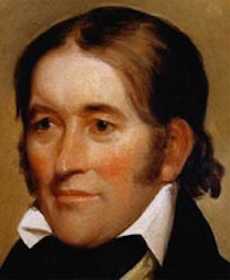
DAVID CROCKETT ON THE REPUBLICAN IDEAL:
"I am a republican, and believe in a republican form of government. And if any other kind of government results from this revolution, I will never support nor defend it."
—David Crockett, refusing to sign to an oath of allegiance to Texas, requiring the soldiers to defend "the Republic of Texas, or any other government that might be established." (Sources: Niles Register, June 23, 1838; Richard Dorson, "America in Legend: Folklore from the Colonial Period to the Present," 1973) |

DUKE CROCKETT ON THE REPUBLICAN IDEAL:
"Republic.' I like the sound of the word. It means people can live free, talk free, go or come, buy or sell, be drunk or sober, however they choose. Some words give you a feeling. Republic is one of those words that makes me tight in the throat. The same tightness a man gets when his baby takes his first step, or his first baby shaves, and makes his first sound like a man. Some words can give you a feeling that make your heart warm. Republic is one of those words."
—John Wayne as Crockett, to Travis in "The Alamo" (1960) |
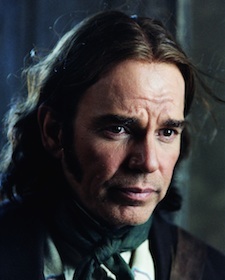
BILLY BOB CROCKETT ON THE REPUBLICAN IDEAL:
"You figger this new Republic is gonna need a President?"
—Billy Bob Thornton as Crockett, to Sam Houston after learning that Texas will declare an independent government from Mexico, in "The Alamo" (2004) |
But Alamo-nerd musings aside, Thornton's Crockett received almost unanimously positive reviews, despite the mixed notices for the film: Mark Caro of the Chicago Tribune noted that Crockett was "played with an appealing, myth-debunking looseness." Lisa Schwarzbaum of Entertainment Weekly wrote, "as played by Billy Bob Thornton with an oaken bucketful of born-on-a-mountaintop charisma, the Tennessee native emerges as a legend more stirring than that of the battle itself. And when he gives up his life in the wreckage of the Alamo (in a grand-gesture demise of debatable historical accuracy that, according to the director, is the most 'heroic' of three credible scenarios), so goes the picture." Mike Clark of USA TODAY wrote that, "the movie seems human only when Billy Bob Thornton's heavily homespun Crockett is onscreen .... Thornton is excellent and now seems genetically incapable of being anything less than great in any role he takes. Bring on France's King Louis XVI." But Lou Lumenick of the The New York Post summed it up the general reaction when he wrote: "Thornton lends gravity, focus and humor that are otherwise in short supply in this serious-minded but meandering, talky and action-deficient epic... Despite Thornton's yeoman efforts and a remarkable 52-acre set, you're more apt to forget The Alamo than to remember it."
"The real Alamo fighters knew of Santa Anna's approach for quite a while, but in the movie it's presented as a rude shock — most of all to Crockett (Billy Bob Thornton), who enlisted in the Texas militia to revitalize his political career and hadn't figured on being at the wrong end of a siege. This is a little unfair to the actual man, who stuck around for months in San Antonio, but it's the best part of The Alamo — this conception of Crockett as a semi-fraud trapped by his own mythic persona who rises to the occasion and fulfills his destiny. It gives Thornton a chance to be the anti-John Wayne, dryly funny in his modesty, a natural politician and unnatural man of action," said David Edelstein of Slate.com.
Rene Rodriguez of the Miami Herald wrote, "There is so much that is wrong with The Alamo that it is easier to begin with what the movie gets right: Davy Crockett. As played by Billy Bob Thornton."
Chris Kaltenbach of the Baltimore Sun wrote, "Thank goodness for Davy Crockett; without him, The Alamo could have proven the blandest heroic siege in movie history."
Entertainment Weekly's Lisa Schwarzbaum wrote: "Even before Quaid's drink-fueled Houston storms in, with furrowed brow and tight jaw, to defeat Mexican general Antonio López de Santa Anna (Emilio Echevarría) at the Battle of San Jacinto, the momentum dies with Crockett and the loss of Thornton's easy, ol' boy magnetism. No wonder the final, victorious fight for Texas has been cut to a coda-size minimum."
"Don't go lookin' for your opium, Davey. Travis smoked it all up."
—Jim Bowie (Johnny Hardwick), "King of the Hill: How I Learned to Stop Worrying and Love the Alamo" 2004
|
The animated series King of the Hill from Fox Television took place in Texas, and the Alamo was mentioned or appeared many times. For instance, in one episode, the main character, Hank Hill is tied up in his underwear by his father and then is dropped off at the Alamo. Hank goes inside the church and cuts his bonds with a knife on a Jim Bowie statue. He then takes the clothing off of the Davy Crockett figure. But the teleplay for the one hundred-sixty-sixth episode, "How I Learned to Stop Worrying and Love the Alamo" (airing 18 April 2004; Season 8, Episode 17), The episode was written by Christy Stratton, and directed by Brian Sheesley, was obviously created to exploit the controversy over the historical accuracy of Disney's The Alamo, and it delivered one of the funniest episodes of the series. In the story, Hank finds out that his son Bobby's new Texas History textbook hardly even mentions the Alamo, so he teams up with Bruce Tuttle, an aspiring writer-director who writes a newsletter for the local feed store, to produce a play about the siege.
Hank builds a beautiful, elaborate set for the play, but when he sees a rehearsal, he discovers that Bruce has created a revisionist version of the battle: Davy Crockett (David Herman) writes at a desk onstage, reading aloud: "It has become clear that I will never make it back to my beloved Tennessee. If I were a stronger man, I guess I wouldn't be here. I would have faced up to my demons instead of using dead Indians and Mexicans as stepping stones back to the Senate." (It was the House, and his views on Native Americans cost him the seat, and he wasn't planning on going back because he was guaranteed Texas land with a new government, and... never mind, let's just assume it was poor research on Bruce Tuttle's part.)
Travis then enters, wearing a "frilly calico dress" and holding a jug. "Vengeance is the Lord's and he has sent his army to vanquish us for our transgressions! We're all damned-ed!" Travis collapses onstage as Bowie appears, brandishing a knife and calling to Crockett. "Don't go looking for your opium, Davy — Travis smoked it all up!" Travis counters, "I gave half to the prostitutes!" Crockett stands, shouting: "Surrender or die? Why start being a hero now?" He picks up a white flag ans runs around the stage. "General Santa Anna! General Santa Anna! I surrender! Oh, general...?"
Hanks protests what he is witnessing, but Bruce refuses to be censored. He addresses the actors, saying, "That was perfect! Now, once again, from the top: We're angry, we're drunk, we're slave-holders... and, ACTION!!!"
Despite Hank's disgust with the play, Bobby must participate in the production to get extra credit and avoid summer school. So on opening night, Hank steps onstage before the play begins and addresses the crowd, saying: "I know there are a lot of details in history that are up for grabs — like what Jim Bowie was thinking about right before he died, or whether Davy Crockett surrendered... but these are the undisputed facts: In March of 1836, nearly 200 men volunteered so that Texas could become a Republic. Even though they were under-trained, out-numbered and completely surrounded, they fought on and died for what they believed in. And I've always found that inspiring."
Hank leaves the stage and the ampitheater as Crockett staggers onstage, vomiting into a bucket, then sees Bobby, playing Bonham: "Is that a messenger bringing news from General Houston?" Bobby informs Crockett there will be no help, and Crockett vomits again. "Whoooo — if this siege continues, I may have to surrender sober!"
Later, Bobby comes home from school with an 'F' in History, anyway — not because of the play, but because he wrote Hank's explanation of the Alamo siege into his pristine history book. There will be no revising revisionism, I guess...
Next came a real play about the Alamo and Davy, and the actor playing him...

Davy's journey from stage to screen came full-circle in 2010. Davy returned to the theater in the Off-Broadway production, The Burnt Part Boys (Playwrights Horizons/ Mainstage Theater). Over the course of the play, the main character is guided by characters from John Wayne's film The Alamo. Michael Park played all of the fantasy characters, and here plays Wayne... playing Crockett. So we have an actor onstage playing an actor onscreen playing Crockett — layers upon layers... The original Davy would have liked that. (Photo © 2010, Joan Marcus)
Playwrights Horizons and Vineyard Theatre are presenting the New York premiere of the new musical THE BURNT PART BOYS. With a book by Mariana Elder, music by Chris Miller, lyrics by Nathan Tysen and direction and musical staging by four-time Helen Hayes Award winner Joe Calarco (Shakespeare's R&J), the joint production opened on Tuesday, May 25 at 7PM. The limited engagement will run through Sunday, June 13 at Playwrights Horizons' Mainstage Theatre (416 West 42nd Street).
THE BURNT PART BOYS is set in coal country, West Virginia, 1962. Fourteen year-old Pete's fighting to claim his past. His older brother Jake's hoping to forge a future. With their friends, they've embarked on a life-altering journey to the mine that took their father's life. Featuring a vibrant, haunting bluegrass and pop-inspired score, this gripping new musical from an acclaimed new team will capture your heart as it finds the streaks of light within the darkness.
The cast features Charlie Brady (South Pacific), Al Calderon (13), Andrew Durand (Spring Awakening, Yank!), Steve French (Manifesto at Second Stage), Noah Galvin (Cirque du Soleil's Wintuk), Michael Park (Smokey Joe's Café, the recent Applause for Encores!, three-time Daytime Emmy nominee as Jack Snyder on As the World Turns), Molly Ranson (August: Osage County), Randy Redd (Some Men, Parade, Ring of Fire) and Asa Somers (Grey Gardens, Next to Normal).
The production features scenic design by Brian Prather, costume design by Elizabeth Flauto, lighting design by Chris Lee and sound design by Lindsay Jones. Orchestrations are by Tony Award winner Bruce Coughlin (The Light in the Piazza) and Musical Direction is by Vadim Feichtner. Production Stage Manager is Lori Lundquist.
The creative team behind the bluegrass-flavored show — the composer Chris Miller, the lyricist Nathan Tysen and the book writer Mariana Elder — are former musical theater graduate students at New York University taught by William Finn. It was Mr. Finn, the composer of Falsettos, who first fostered The Burnt Part Boys in a 2006 incarnation in the musical theater lab at Barrington Stage Company.
MARIANA ELDER (Book) Credits include THE BURNT PART BOYS (New York Stage and Film, Vineyard Theatre, Barrington Stage Company, Theatreworks Palo Alto, University of Nebraska: Lincoln, National Endowment of the Arts Grant, American Critics New Play Finalist); THIS SIDE OF PARADISE (Theater for a New City, Bank Street Theater, Hudson Backstage Theater, Manhattan Theatre Source, published Estrogenius Sourcebook); RUN TEDDY RUN (Electric Pear, NYU/Playwrights Horizons, Musical Theater Works, Ensemble Studio Theatre Rusty Magee Fellowship, Daryl Roth Award). Graduate of NYU Tisch (Dean's Fellow) and Grinnell College, teaching artist for Lincoln Center Theater and Dreamyard Project.
Nathan: "Pete, because he hasn't had a father figure — he lost his father when he was six years old — um, goes into these fantasies, and throughout the show when he is in moments of stress, has lost his direction — doesn't know what to do, he calls upon this fantasy figure, um, that his father (the amazing soap opera star Michael Park, an unbelievable singer, plays in the show) and Michael Park plays different, uh, movie characters that help Pete along the way. Now, Chris and I, and Mariana, have written probably 15 different cinematic movie sequences for this show, you know, making the father do all sorts of crazy things."
Mariana: "After my dad died, you know, the first thing I realized was that I couldn't call him, and I've read and I've talked to many people who've also, you know, who've lost their parents — the first thing they wanna do is call their cell phone an listen to the voicemail."
Nathan: "And what we finally realized — I think the biggest breakthrough of 2010, was that the fantasy sequences should all revolve around one movie instead of a bunch of different genres of movies — there shouldn't be a Hitchcock movie, there shouldn't be a science fiction, uh, sequence, there shouldn't be a cowboy, uh, film — there should just be one movie, and he's calling upon major characters from this movie. The movie that we picked was The Alamo, which was a very popular movie in 1960, starring John Wayne, uh, and, what's amazing about The Alamo is that there are fantastic parallels between the story of The Alamo and the story that Pete is building in his head, because what Pete decides to do is once he finds out that the mine is being reopened is to steal a bunch of dynamite and take it up to the top of the mountain and try to blow it up to make sure that no one will ever go in that mine again — so it's all about kind of saving a shrine."
Mariana: "In the latest draft, there's a line where he says he's calling to his father and General Sam Houston appears, and that was very exciting to me — that I actually was able to combine that and have it actually play out."
The show opened at the Park Theatre in London, in August 2016.
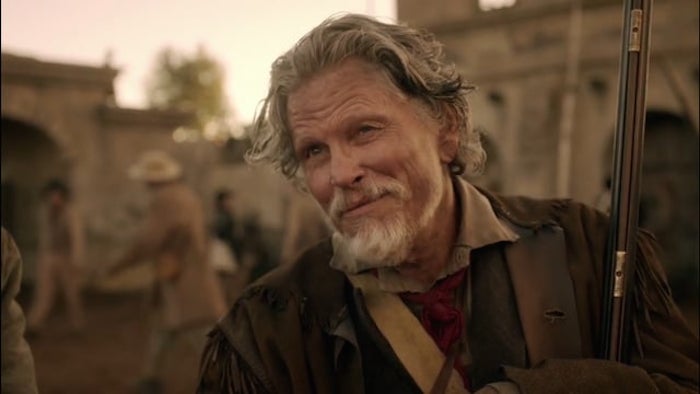
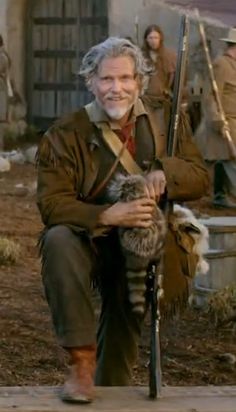
Jeff Kober as Crockett |
Timeless is an American science fiction drama series that premiered on NBC on October 3, 2016. "The Alamo" episode (31 Oct 2016, NBC) was directed by John Terlesky and written by Anne Cofell Saunders and Kent Rotherham; The series was created by Shawn Ryan and Eric Kripke and also stars Paterson Joseph and Sakina Jaffrey. Executive producers include John Davis and John Fox of The Blacklist. Long considered one of NBC's hot pilots, it was ordered to series on May 13, 2016, after lengthy negotiations to obtain the series' "in-season stacking rights", which allow a network to stream all episodes of a series' current season via all the network's online platforms. The show follows the adventures of an unusual trio-a history professor (Abigail Spencer), a scientist (Malcolm Barrett) and a soldier (Matt Lanter)-as they attempt to stop Garcia Flynn (Goran Visnjic), a time-traveling criminal, from changing the course of American history.
In this series, an experimental time machine is stolen by ex-NSA asset Garcia Flynn, who mysteriously goes off the grid after allegedly killing his wife and child. A team consisting of history professor Lucy Preston, soldier Wyatt Logan, and engineer Rufus Carlin is sent back in time using a prototype machine to capture him. However, they soon realize that Flynn and his associates are plotting to rewrite American history, and that each of them has a connection to his plan. Lucy's primary concern is for her ailing mother. Wyatt is shown grieving over the recent demise of his wife. Rufus, the scientist who helped develop the time machine, is distressed over the fact that Flynn stole his invention.
Wyatt receives word that the NSA is bringing in another operative to replace him, as he has failed to take down Flynn. Flynn travels to March 2, 1836 and makes a deal with Mexican President General Antonio López de Santa Anna to help bring down the Texas Revolution three days before the original end date of the Battle of the Alamo. Lucy, Wyatt, and Rufus follow suit and enter the Alamo Mission, but Flynn kills William B. Travis, preventing him from finishing his "Victory or Death" letter. Making matters worse is the Mexican Army waving the red flag to take no prisoners in their siege. Before the Mexicans begin their attack, Wyatt and Rufus dig an underground passageway to the aqueduct while Lucy overcomes writer's block and finishes Travis' letter before entrusting it to John William Smith, a young soldier who would later become the first mayor of present-day San Antonio, Texas, who escapes with the women and children while James Bowie and Davy Crockett (Jeff Kober) fend off against the invading Mexicans. In the present day, Lucy and Rufus inform Agent Christopher that they will not continue their mission without Wyatt; as a result, Wyatt stays with the team.
Abigail Spencer plays Lucy, as a quirky-hip-plucky-but-sad-inside-history-teacher-with-mom-issues-and-boss-boyfriend. Wyatt Logan (Matt Lanter) isn't Lucy's only companion, and Rufus (Malcolm Barrett) proves a much more interesting time-travel buddy. Like Spencer, Barrett's saddled with some truly silly stuff (Michael Jordan, Michael Jackson, Mike Tyson...), but he also benefits from the one substantive element that actually works. Acknowledging the very real dangers to a person of color traveling in time may seem like a no-brainer, but not every show would bother. Frankly, most shows would probably avoid that problem by casting another white dude.
They fudge history a little. The character of Rufus walks into the fort and is told that slavery is illegal in Texas, avoiding the uncomfortable fact that there were slaves in the Alamo, and it was one of the issues the defenders were fighting for. Shades of Martyrs of the Alamo, there's an aqueduct running under the stone floors that allows the women and children to escape. Bowie is healthy and leading the defenders in the final battle, but since history has been changed and Santa Ana attacks early who knows — maybe Bowie was healthy at that point in the siege. One more question: Why don't they just go back in time earlier than Flynn and capture him when he shows up? Kober is terrific as Crockett.
Savage Lands was shot as an independent production in filmed in Crockett's home state of Tennessee in 2022. Crockett is played by William Moseley, best known for his role as Peter in the Chronicles of Narnia film series. The film's antagonist, Caleb, is played by Colm Meany, best known for his role in the Star Trek: Deep Space Nine series as well as feature films such as Con Air, Under Siege and Layer Cake. A press release proclaimed, "Savage Lands brings an American legend to life with a story you haven't heard. How did a member of Congress from Tennessee perish in the Alamo? How did his heart change towards the native peoples he encountered? Savage Lands is the incredible story of Davy Crockett's journey to save his family, befriend the Cherokee, and ultimately realize that savagery is more than skin deep." It was written and produced by Derek Estlin Purvis (born November 27, 1972) is an American screenwriter, film director, producer, executive producer and entrepreneur. He has financed, produced or directed 13 feature films of various genres, including The Ten starring Paul Rudd and Jessica Alba. Purvis directed and executive produced The Love Guide starring Parker Posey. Purvis is a founder of the mobile app Movie Pitch Pro.
Davy Crockett film in production in Middle Tennessee, most of crew made up of Tennesseans, by Forrest Sanders (WTVF, News Channel 5, Nashville); Posted at 7:29 PM, Nov 11, 2022. KINGSTON SPRINGS, Tenn. — A name you know well is having his story told in a film shooting in Middle Tennessee right now. The filmmakers say there's a reason why they wanted to make the movie here and employ a mostly-Tennessee crew.
Work was underway Friday in Kingston Springs. Crew members worked hard to prepare to shoot a scene for the upcoming film, Savage Lands. It's a story with deep ties to this state. Actor William Moseley is playing Davy Crockett.
"I want this film to be an action/adventure, swashbuckling Crockett," Moseley smiled.
"It's a movie that begins with Davy's break with Andrew Jackson," said producer Michael Mailer. "[Crockett] was opposed to the Indian Removal Act. He's a great American hero, and I think it's a good time to revisit his story."
"The First Nation characters in our story are represented as equals," said director Derek Purvis.
"Here, you can see a trapper coat," said costume designer Susanna Puisto, grabbing things off of a rack. "We got them in multiples because we have a lot of stunts."
Puisto said a project like this demands a certain authenticity.
"We've got the First Nations guys," she continued, showing another set of costumes. "We've got the chaps with lovely details. There's a lot of amazing leathers that they wear."
The crew believes something else contributing to authenticity is making the film in Tennessee.
"If we'd been filming in, say, New Zealand or South Africa, I wouldn't be able to connect in the same way as being in Tennessee where Davy Crockett lived and where he's very well known," said Moseley.
"This was his home," Purvis added. "This is where he was created as a legend and raised as a child."
Purvis himself is a Tennessee-based director. He said more than 80% of his more than 115-person crew is based in the state as well.
"This team has been unbelievably good," he said.
"It's a true honor to work with people from Tennessee, to use a crew from Tennessee," Moseley added.
Once completed, Savage Lands will be pitched to major streaming services. The hope is for a warm reception, one in which the crew can get back together and continue making Crockett films and series.
"We hope to do all that here in Tennessee," said Purvis.
"I hope familiarity doesn't breed contempt, so I hope people like seeing me here," laughed Moseley. "Tennessee is absolutely beautiful. I'm honored to be here. The people are kind. They're warm. They've welcomed me in. I truly hope that people will sit down and say, 'they got the spirit of Davy Crockett.'"
Purvis also told us that production is feeling some effects of inflation. They're selling merchandise on the film's site, with the money going to support the production. You can find that site here.
8: CODA
"David Crockett went to check out his alter ego at a Washington theater in December 1833. Congressman and actor exchanged bows... Twenty-eight months later, the real man would be dead and Mythic Davy would take his place. Over the next 175 years, this Crockett would shift his shape from Texas martyr to tall-tale super-hero, from silent-movie star to icon of the TV generation — and, more recently, to symbolic flash point of the culture wars. Elusive and immortal, an Everyman who is also larger than life, Mythic Davy has always reflected Americans' evolving sense of who we are."
—Bob Thompson, "Born On A Mountaintop: On The Road With Davy Crockett And The Ghosts Of The Wild Frontier." Random House Inc, 2013 |
"I made a couple of trips to Vietnam — in '68 and again in '70 — and these were the same little kids that I was shaking hands with in Oklahoma and Arkansas, and I felt so bad that this was what they inherited."
—Fess Parker on visiting troops in Vietnam in 1968, from "The Alcalde," July/August 2003
|
For 200 years, historians and critics have struggled to understand David "Davy" Crockett, often because they measured him to standards that no longer applied — meanwhile, those same fish-out-of-water qualities made him more compelling to audiences. While society changes, Davy keeps changing with the times. Billy Bob Thornton's characterization of Crockett is no more or less related to the real man than Fess Parker's or John Wayne's. Each performance has highlighted different aspects of a complicated man, in order to fit the needs of a particular story, told in a particular time — that was considered to be the truth for that time.
Davy has become more than just a character — he is the national identity. The story of Davy, the first celebrity of the United States, has gone through a myriad of retellings, rewrites and revisionist histories, but has never made more sense than today. Now anybody can become a celebrity if they're publicized correctly. Comedians are as respected as some of the wisest people in our society, political pundits — and even royalty. Now actors, sports stars — even reality TV show hosts — are elected to the highest public offices. Davy Crockett set the stage (and screen) for all of this.
If there were just one truth to be told about Crockett, there'd be no need to make another movie about him. The truly important thing is not what these films reveal about Crockett, but what they reveal about us.
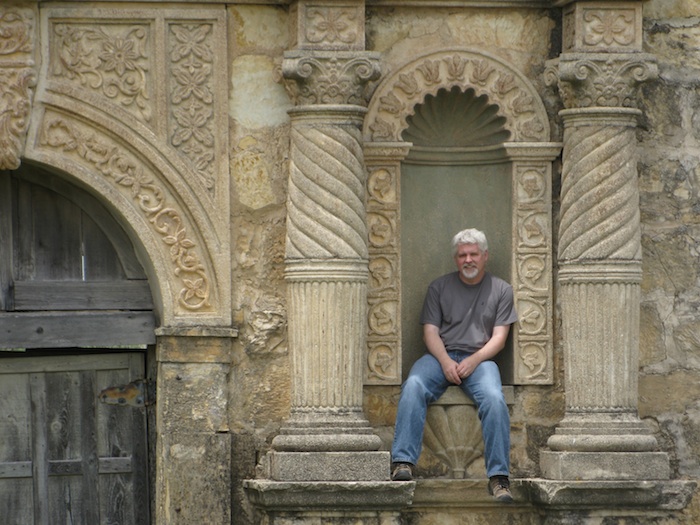
The author on the set of Wayne's Alamo movie in 2010, right before it closed for good. The property once contained the entire San Antonio location for the film and became the "Alamo Village" tourist stop with a downtown stunt show, functioning church (for weddings), cantina (with musical entertainment), museum and gift shops, but except for the stone chapel facade here, most of the fort and town either crumbled away or was sold off to pay property tax fees by 2018.
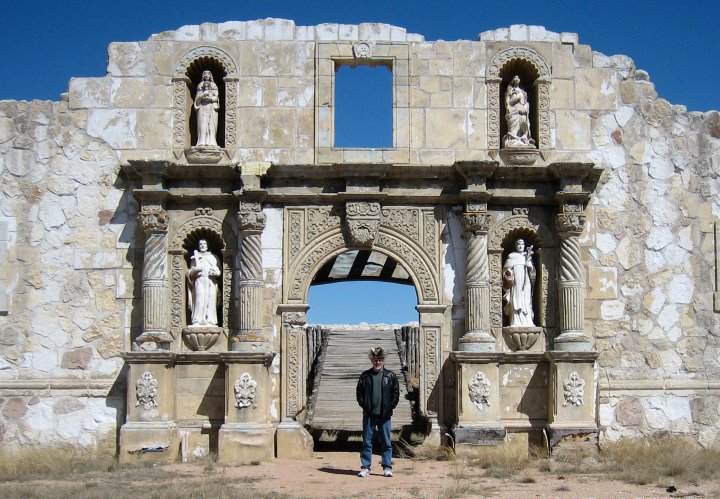
The author on the set of The Alamo (2004). The pelt on my head belonged to opera singer Jerry Hadley, after belonging, presumably, to a raccoon. The location, which contained sets for downtown San Antonio, Gonzales and the Alamo fort, was destroyed by a wildfire in September of 2011.
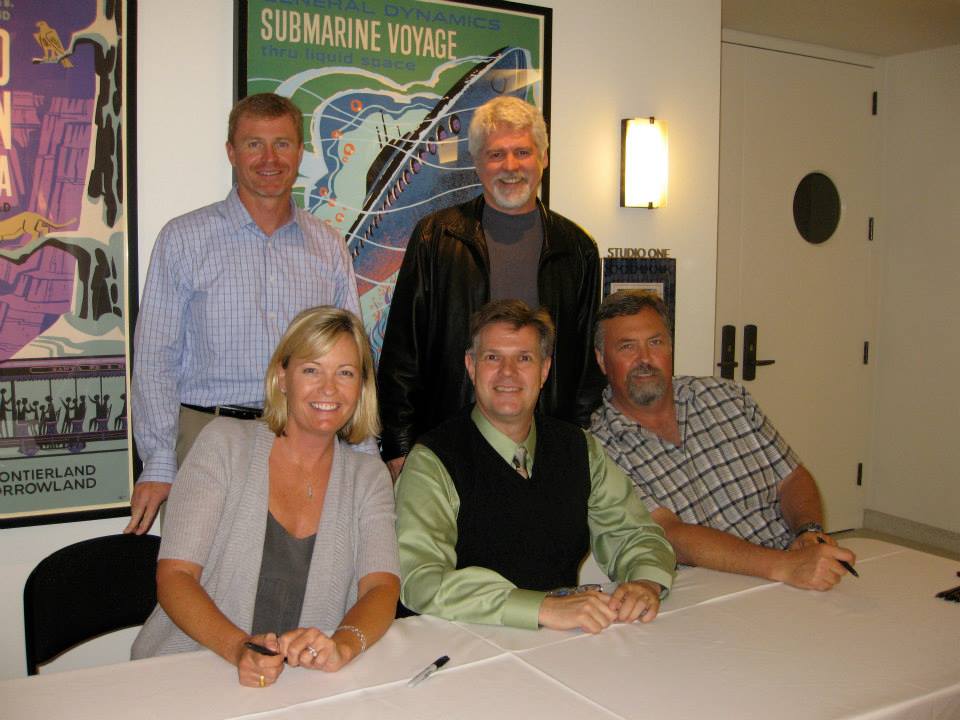
The author posing with Fess Parker's kids (Ashley Snider, front-row, left; Eli Parker, font-row, right, and son-in-law Tim Snider, back-row, left) in 2011 at the Disney Museum in San Francisco. The Parker family makes top-notch wine (that Davy would have approved of, I'm sure) at a beautiful facility near Santa Barbara, California. I think the host, front-center, was audio-animatronic.
Notes
¹—Marcus Brutus Winchester (1796-1856) is a fascinating character who has never been featured in Crockett stage or screen narratives. As a teenager Marcus fought in the War of 1812, was captured at the battle of River Raisin, and was sent to prison in Quebec. In October of 1818, Winchester accompanied Andrew Jackson to the signing of the Chickasaw Cession (Jackson Purchase) owned by Jackson, John Overton and Winchester's father, which eventually became the town of Memphis, Tennessee. Marcus opened the first store in the town. In about 1823, he married Amarante "Mary" Loiselle of New Orleans. Most historians now agree that she was black — which Crockett did not mention in his Narrative. When Memphis was incorporated in 1826, Winchester became the town's first mayor. However, his loyalty to the Jacksonians came under question when he supported Crockett for Congress, and Winchester's career declined. He and Mary had six daughters and two sons. After Mary's death in 1840, Winchester married nineteen-year-old Lucy Lenore Ferguson McLean, in 1842. Winchester was elected to the state legislature in 1851, then died in 1856.
²—One character who is neglected in Crockett dramatizations (other than the real Crockett, some would say) has to be Thomas Chilton, a Congressman from Kentucky, a prominent Baptist clergyman, and collaborator (and possibly the main author) of David Crockett's autobiography. Chilton was born near Lancaster, Kentucky, to Rev. Thomas John Chilton and Margaret Bledsoe. One week before his seventeenth birthday he married Frances Tribble Stoner and commenced study for ordination as a Baptist minister. After setting up a law practice, Chilton was elected to the State House of Representatives at the age of 21. Chilton became a Jacksonite and rode his coattails to the Twenty-first U.S. House of Representatives. He and Crockett became staunch allies and left Jackson's party together in March 1830. Chilton failed in his bid for reelection, but was later elected as an Anti-Jacksonian to the Twenty-third Congress and joined Crockett again on Capitol Hill. Together they wrote Crockett's autobiography, Narrative of the Life of David Crockett of the State of Tennessee. It was crafted by Chilton from Crockett's written material and in response to questioning. The collaboration was never made public, but a letter written by Crockett to his son John, dated January 10, 1834, states: "I am ingaged in writing a history of my life and I have completed one hundred and ten pages and I have Mr. Chlton [sic] to Correct as I write it." Another letter, written to publishers Cary & Hart, instructed that Chilton should be paid half of the royalties due to Crockett in their agreement. Crockett added, "The manuscript of the Book is in his hand writing though the entire Substance of it is truly my own. The aid which I needed was to Classify the matter but the Style was not altered." Chilton never publicly revealed his part in the creation of his friend's book. By the end of that Congressional term, both Chilton and Crockett were tired of dealing with the Jackson machine and turned their backs on Washington — Chilton even chose to resume the Baptist ministry in addition to his law practice. After relocating to Alabama, Chilton’s first wife died in 1842, and he married Louisa Conklin from his congregation. In 1846 he became General Agent of the Alabama Baptist Convention, and he pastored churches throughout Kentucky and Alabama. In 1851, Chilton finally followed Crockett to Texas with his wife and their six young children when he was invited to pastor in Houston. While delivering a sermon in Montgomery, Texas, on August 15, 1854, he suddenly clutched his chest, collapsed, and died of a heart attack before the congregation, proving that the kingdom of God was indeed at hand. His grandson, Horace Chilton became a U.S. Senator and was the first native born Texan to serve in Congress.
³—Frances Milton Trollope (10 March 1779 - 6 October 1863) was an English novelist and writer who published as 'Mrs. Trollope' or 'Mrs. Frances Trollope'. She wrote of Americans, "I do not like them. I do not like their principles; I do not like their manners, I do not like their opinions." (Domestic Manners, p. 321). She accused Thomas Jefferson of being "an unprincipled tyrant, and most heartless libertine" sleeping with his slaves, and that she "heard his name coupled with deeds which would make the sons of Europe shudder." She added, "Mr. Jefferson is said to have been the father of children by almost all his numerous gang of female slaves. These wretched offspring were also the lawful slaves of their father, and worked in his house and plantations as such; in particular, it is recorded that it was his especial pleasure to be waited upon by them at table, and the hospitable orgies for which his Montecielo was so celebrated, were incomplete, unless the goblet he quaffed were tendered by the trembling hand of his own slavish offspring." Of the American people, she wrote:
"You will see them with one hand hoisting the cap of liberty, and with the other flogging their slaves. You will see them one hour lecturing their mob on the indefeasible rights of man, and the next driving from their homes the children of the soil, whom they have bound themselves to protect by the most solemn treaties." (Domestic Manners, p. 180.)
She visited Congress and wrote, "The extreme beauty of the chamber was of itself a reason for going again and again. It was, however, really mortifying to see this splendid hall, fitted up in so stately and sumptuous a manner, filled with men, sitting in the most unseemly attitudes, a large majority with their hats on, and nearly all, spitting to an excess that decency forbids me to describe." She includes a description of a man who could be Crockett's literary collaborator, Thomas Chilton: "But in our places on the sofas we found we heard very much better than up stairs, and well enough to be extremely amused by the rude eloquence of a thorough horse and alligator orator from Kentucky, who entreated the house repeatedly to 'go the whole hog.'"
⁴—Selig opened a temporary Los Angeles studio in a small building behind a Chinese laundry on Olive Street between Seventh and Eighth Streets in the spring of 1909. The first movie was called In the Power of the Sultan, and its star was Hobart Bosworth — but he was so ashamed of his 'degradation' that he refused to let the company use his name in the film credits. Bosworth later recalled that his chief memory was the smell of wet clothes downstairs at the laundry. (Source: L.A. Times, Monday, May 19, 1949)
⁵—The real George Russell (played by Buddy Ebsen for Disney during the 1950s and Gary Grubbs during the 1980s) was born near the Walker Daniel Line in North Carolina about 1795, the son of Major William Russell. According to Crockett's Narrative, he chose the young Russell to accompany him on a scouting mission during the War of 1812. Their superior, Major Gibson, disapproved and said Russell didn't have "enough beard to please him" and wanted men, not boys. But Crockett recounted, "I knew George Russell, and I know'd there was no mistake in him ; and I didn't think that courage ought to be measured by the beard, for fear a goat would have the preference over a man." (He's never mentioned again in Crockett's book.) Russell fought in the war from 1 Oct 1812 to 1 Jan 1814. "Georgie" married his first wife, Nancy Brooks, about 1814 in Franklin County, Tennessee, and they had two sons. He lived in Franklin County, TN, near Winchester, from the date of his military discharge until 1818, when he moved to Franklin County, AL. Nancy died, and he married again about 1820 to Leah Jackson. He had about 6 or 7 more children with Leah. He was about five feet tall, with dark hair, dark eyes, a dark complexion, and worked as a farmer. (Description given by his widow Leah in her pension application). George died on 17 Oct 1831 near Newburg, Franklin County, AL., (National Archives, WO 18015), so he never really followed Davy to Texas — but his grandson finally did, and served as the Attorney General of the State.
⁶—Helene made major, if invisible, contributions to Disney animated features, which used live-action films as the basis for animation. In 1949, Walt Disney tests more than 400 applicants before picking Helene as the model for Cinderella's looks and personality. After modeling Cinderella (1950), she was used for Sleeping Beauty (1959), and the young wife Anita Radcliff in One Hundred and One Dalmatians (1961). In a less-wholesome anecdote, Helene was (briefly) the third wife of handsome underwold figure Johnny Stompanato, Jr., also known as "Handsome Harry", "Johnny Stomp", "John Steele", and "Oscar" and the ex of actress Helen Gilbert. In October of 1952, Stampanato severed his ties with mobster Mickey Cohen, for whom he had been a bodyguard and moneyman, and started dating Helene steadily. In December, Stompanato (now her manager) presented her with a big, fat star sapphire. In January of 1953, columnist Erskine Johnson reported that she and Stompanato had set the wedding date for April 13, 1953. By, 1954, he was living with Helene and her parents... and he was raising parakeets in the back of the house. Also in 1954 came her role as Polly Crockett, but her marriage was breaking up. In 1955 she divorced Stompanato, and by June of 1955, she was in the cast of the New Frontier show in Las Vegas; columnist Erskine Johnson reported that "although she won't see him, estranged hubby Johnny Stompanato is trying for a reconciliation" Then in December of 1956, she was seen at the Luau with her fiancé, Dr. David Niemetz, a Beverly Hills physician, and announced that they plan to be married in June. (But they wouldn't marry until after Stompanato was stabbed to death on Good Friday 4 April 1958 by Lana Turner's daughter, Cheryl Crane.)
⁷—Wayne traded shots with Khrushchev in person, but not in the way you think. When the Soviet premier visited Hollywood in 1959, a luncheon was thrown in his honor, and hundreds of stars appealed for tickets. He met Marilyn Monroe, Bob Hope, Gary Cooper, and Frank Sinatra. Wayne, filming The Alamo at the time, agreed to fly out from Texas for the luncheon. Khrushchev asked to meet Wayne privately later, and the star agreed.
Khrushchev led his hero to the bar and said through his interpreter, "I am told that you like to drink and that you can hold your liquor." Wayne admitted that he could, and they went on to compare the virtues of Russian vodka vs. Mexican tequila, and started to match each other, drink-for-drink, ending in a Cold War draw. But three months later, a large wooden crate was delivered to Wayne's Beverly Hills offices, stamped with the letters CCCP (USSR). "It's too damn big for a bomb," Wayne decided, and pried it open with a crowbar. It was filled with Russian vodka and a note reading, "Duke. Merry Christmas. Nikita." Wayne had a couple cases of Sauza Conmemorativo tequila sent to Khrushchev with the note, "Nikita. Thanks. Duke." I could make comments about a SALT treaty on tequila shots, but who needs to? This situation is funny enough on its own.
⁸—Billy Bob Thornton actually met Fess Parker during the shooting of the 2004 film. Parker was in Austin to be awarded the Texas Cultural Trust's "Texas Medal of Arts Award," along with his daughter, Ashley. "Billy Bob Thornton is a small man. Here comes my dad 6'7" in his boots, and Billy Bob's sitting there with a knit cap on. It was so hilarious to see him stand up and shake Fess' hand." Ashley enjoyed the finished film, but recalled that her father turned down an opportunity for a cameo in the film. "The flight was booked, and it was all set up," she remembered. Her husband Tim added that Fess turned it down because "It just didn't feel right." Frank Thompson, who was to be in the scene with Parker, said: "He was supposed to be in my scene as another one of the politicians. He actually got to Austin before changing his mind. Nobody ever knew why. I was pretty bummed out... although in retrospect he probably would have gotten my close-up, so good riddance!"
⁹—When Disney lost Russell Crowe and Ron Howard, they lost their chance for a large audience (and gained a lot of negative publicity). As a point of reference, an epic $175,000,000 war film, Troy, opened a month later and made $133 million, with its opening weekend gross basically equaling the entire run of The Alamo. Historians slammed Troy for bad revisionism, and it received mixed reviews from critics for the usual costume drama dopiness (nobles with British accents even though they live in ancient Greece, etc.). Anyway, teenagers on date night weren't bigger fans of The Iliad than of the Alamo — heck, they probably didn't know anything about either story. The difference is that Troy's star was Brad Pitt, who was coming off a string of hundred million dollar-grossing films. Audiences don't pick which film to see by the size of the set, but by the size of the star. When the big moneymakers loudly backed out of The Alamo, it was doomed. On a side note, Troy: Director's Cut was screened at the 57th Berlin International Film Festival on February 17, 2007 and received a limited release in Germany in April 2007. Warner Home Video reportedly spent more than $1 million for the director's cut, which includes a different opening, with a soldier's dog finding its dead master... just like Hancock's Alamo (there's no word on whether the first film had any effect on the other's edit). A director's cut for The Alamo, reinserting Bonham's ride, Houston among the Indians, and other events of the Texas revolution that were edited out for time considerations, has been talked about, but so far has not materialized.
Appendices
Appendix A: Comparison of Alamo Movies
ASPECT
 |
GRIFFITH'S ALAMO (1915)
 |
WALT'S ALAMO (1955)
 |
WAYNE'S ALAMO (1960)
 |
DISNEY'S ALAMO (2004)
 |
| LENGTH |
71 minutes |
60 minutes |
192 minutes plus Overture, Entr'acte and Exit music, then cut to 161 minutes |
180 minutes... then cut to 145 minutes... then cut to 137 minutes |
| CROCKETT |
A.D. [Alfred] Sears, showy but silent |
Fess Parker, strong but silent |
John Wayne, strong but not-so-silent |
Billy Bob Thornton, neither strong nor silent |
| CONTEMPORARY WAR |
Mexican Revolution; Undeclared war against Mexico, leading to a large military force under General Pershing invading northern Mexico. |
Cold War against communist Soviet Union, just exiting Korea. |
Cold War against communist Soviet Union, just entering Vietnam. |
Undeclared war against radical Islam in Afghanistan, leading to a large military force invading... Iraq (imagine Mexico invading New Jersey instead of Texas in 1836). |
| SIZE OF OPPONENT |
A cast of dozens |
A cast of hundreds |
A cast of thousands |
A cast of thousands of CGI effects |
| WHY ARE WE FIGHTING? |
"Under the dictator's rule the honor and life of American womanhood was held in contempt." |
"Americans in trouble." |
Mexicans in trouble |
"I understood the fighting was over... Ain't it?" |
| WHO WINS? |
The Texians win at San Jacinto; Santa Ana loses Texas. |
Morey Swartz, who owned the patent for "Davy Crockett, Frontiersman" before Walt could acquire it. |
Santa Ana, but after a great victory he still gets blown off by the hot blonde at the end of the movie. |
The Texians win at San Jacinto; Disney loses $100 million at the box office. |
| WRITER |
Christy Cabanne, from a novel by Theodosia Harris |
Thomas W. Blackburn... from "Davy Crockett's own journal," though, right? |
James Edward Grant, from novels by (names removed by authors' request) |
A cast of thousands |
| PROMISE |
The most historically accurate version yet! |
The most historically accurate version yet! |
The most historically accurate version yet! |
The most historically accurate version yet! |
Appendix B: "Lochinvar"
The following poem is from Sir Walter Scott's epic narrative poem Marmion. One of the most famous quotations in English poetry is derived from Canto VI, XVII of the piece:
Oh, what a tangled web we weave
When first we practise to deceive!
The stanzas telling the story of "young Lochinvar," excerpted from Canto V, were widely published in anthologies, and is read to Davy in the Mayo play by his secret love:
LOCHINVAR
by: Sir Walter Scott (1771-1832)
O young Lochinvar is come out of the west,
Through all the wide Border his steed was the best;
And save his good broadsword he weapons had none,
He rode all unarm'd, and he rode all alone.
So faithful in love, and so dauntless in war,
There never was knight like the young Lochinvar.
He staid not for brake, and he stopp'd not for stone,
He swam the Eske river where ford there was none;
But ere he alighted at Netherby gate,
The bride had consented, the gallant came late:
For a laggard in love, and a dastard in war,
Was to wed the fair Ellen of brave Lochinvar.
So boldly he enter'd the Netherby Hall,
Among bride's-men, and kinsmen, and brothers and all:
Then spoke the bride's father, his hand on his sword,
(For the poor craven bridegroom said never a word,)
"O come ye in peace here, or come ye in war,
Or to dance at our bridal, young Lord Lochinvar?"
"I long woo'd your daughter, my suit you denied; —
Love swells like the Solway, but ebbs like its tide —
And now I am come, with this lost love of mine,
To lead but one measure, drink one cup of wine.
There are maidens in Scotland more lovely by far,
That would gladly be bride to the young Lochinvar."
The bride kiss'd the goblet: the knight took it up,
He quaff'd off the wine, and he threw down the cup.
She look'd down to blush, and she look'd up to sigh,
With a smile on her lips and a tear in her eye.
He took her soft hand, ere her mother could bar, —
"Now tread we a measure!" said young Lochinvar.
So stately his form, and so lovely her face,
That never a hall such a gailiard did grace;
While her mother did fret, and her father did fume
And the bridegroom stood dangling his bonnet and plume;
And the bride-maidens whisper'd, "'twere better by far
To have match'd our fair cousin with young Lochinvar."
One touch to her hand, and one word in her ear,
When they reach'd the hall-door, and the charger stood near;
So light to the croupe the fair lady he swung,
So light to the saddle before her he sprung!
"She is won! we are gone, over bank, bush, and scaur;
They'll have fleet steeds that follow," quoth young Lochinvar.
There was mounting 'mong Graemes of the Netherby clan;
Forsters, Fenwicks, and Musgraves, they rode and they ran:
There was racing and chasing on Cannobie Lee,
But the lost bride of Netherby ne'er did they see.
So daring in love, and so dauntless in war,
Have ye e'er heard of gallant like young Lochinvar?
—Scott, Walter. Marmion: A Tale of Flodden Field (Edinburgh: Printed by J. Ballantyne and Co. For Archibald Constable and Company, Edinburgh; and William Miller, and John Murray, London, 1808).
Appendix C: 19th Century Crockett Songs
 |
The first popular song about David Crockett was "'Go Ahead' — A March Dedicated to Colonel Crockett" (also known as "The Crockett Victory March"), written in the early 1830's. Copies of the sheet music from Firth and Hall in New York date the song to 1835. Then George P. Knauff created a fiddle tune called, "Colonel Crockett: A Virginia Reel" in 1839, which was still in basic fiddle repertoires well into the 20th Century.
Meanwhile, Crockett was the subject of tall tales and minstrel shows, where he was featured in a verse of the popular song, Zip Coon, which appears to have originated around 1833. The song goes:
That tarnal critter Crockett, he never say his prayers,
He kill all de wild Cats, de Coons and de bears,
And den he go to Washington to make de laws,
And dere he find de Congress men sucking deir paws.
"Zip Coon" led to another famous song about Davy — maybe the most popular of all. It became a runaway hit and could be heard everywhere across the United States for years... and it wasn't "The Ballad of Davy Crockett."
"Pompey Smash" can be traced back to the mid-1830's, when David was still alive and his legend was just getting national exposure (the Halley's Comet lyrics place it around the time of 1834). It was played everywhere in the mid 19th Century, and experienced a rebirth in the 1920's, retitled as "Davy Crockett," and is still a part of many folk collections and songbooks.
"Pompey Smash" dealt more with Crockett as the legendary wild man. It concerns a fight between Crockett and Pompey, a minstrel character who was sort of the black version of Crockett. It's even speculated that Crockett (or his ghost writer) might have borrowed the story of grinning the bark off a tree from the song in his Sketches and Eccentricities book.
Here are a few stanzas (This version of "POMPEY SMASH: The Everlastin and Unkonkerable Skreamer," is from Lloyd's Ethiopian Song Book, published in London, 1847, and The Negro Singers Own Book, Philadelphia, 1846):
Now I'll tell you 'bout a fight I had wid Davy Crockett
Dat haff hoss, haff kune, an haff sky rocket,
I met him one day as I go out a gunnin'
I ax him whar he guine, an he say he guine a kunein.
Den I ax him whar he gun, and he say he got nun,
Den I say, Davy, how you guine to hunt widout one.
Den says he, Pompey Smash, just come along ob Davy
An I'll dam soon show you how to grin a koon crazy
Well, I follow on arter, till Davy seed a squirrel,
Settin on a pine log, eatin sheep sorrel,
Den he stop rite still, and he gin for me to feel,
Says he, Pompey Smash, let me brace agin your heel.
I stuck out my heel, an I brace up de sinner,
An den Davy gun to grin hard for his dinner,
But de critter didn't move — nor didn't seem to mine him,
But seem to keep a eatin, and neber look behine him.
At lass, Davy sed, he ralely must be dead,
For I seed de bark fly all 'bout de kritter's head.
Den we boph started up, de truth to diskiver,
An may de debil roast ole Pompei Smash's liber,
If it wa'nt a great not, 'bout as big as a punkin,
Saz I, kurnel Davy, does you call dis skunkin._Heah! Heah! Heah!!!
Den sez he, you black kaff, now I tell you doan laff,
If you do I'll pin your ears back, an bite you in haff.
I throde down my gun, an I drop my amynishin,
Sez I, kurnel Davy, I'll cool you ambishun,
He back both his years, an puff like a steamer,
Sez he, Pompey Smash, I'm a Tennessee skreemer,
Den we boph lock horn, an I tink my breph gone,
I was neber hug so close, since de day I was born.
We fought haff a day, an den we greed to stop it,
For I was badly whipt, an so was Davy Crockett,
When we look for our heds, gosh, we found 'em boph missen,
For he'd bit off mine, an' I'd swallow'd hissen.
Den boph did agree for to leff de oder be,
For I was rather hard for him, an so was he for me.
David Crockett was reportedly very musical and a pretty decent fiddle player (unverified) — but only one song has held up at all to any scrutiny at all, although even that is somewhat dubious: "Farewell to the Mountains," was supposedly penned by David, and edited by "Pegleg" Longfellow. It was reportedly quoted from the Republican Banner newspaper in Nashville shortly after Crockett's death, but the particular newspaper has never been found. It was then reprinted by Austin P. Foster in Tennessee Historical Magazine, October, 1925. Lines 1-2 of verse 1, lines 3-4, 7-8 of verse 2, have been set to music; and were heard in Disney's Davy Crockett, King of the Wild Frontier.
FAREWELL TO THE MOUNTAINS
By David Crockett
Farewell to the mountains whose mazes to me
Were more beautiful far than Eden could be;
No fruit was forbidden, but Nature had spread
Her bountiful board, and her children were fed.
The hills were our garners — our herds wildly grew,
And Nature was shepherd and husbandman too.
I felt like a monarch, yet thought like a man,
As I thank'd the Great Giver, and worshipped his plan.
The home I forsake where my offspring arose:
The graves I forsake where my children repose,
The home I redeem'd from the savage and wild;
The home I have loved as a father his child;
The corn that I planted, the fields that I cleared,
The flocks that I raised and the cabin I rear'd;
The wife of my bosom — Farewell to ye all!
In the land of the stranger I rise — or I fall.
Farewell to my country! —I fought for thee well,
When the savage rushed forth like the demons from hell.
In peace or in war I have stood by thy side—
My country for thee I have lived — would have died!
But I am cast off —My career now is run,
And I wander abroad like the prodigal son—
Where the wild savage roves, and the broad praries spread,
The fallen despised — will again go ahead!
Well, whoever wrote it, it has pretty lyrics. It was later published in Story of the Wild West and Camp-Fire Chats, by Buffalo Bill (Hon. W.F. Cody): A Full and Complete History of the Renowned Pioneer Quartette, Boone, Crockett, Carson and Cody, by William F. Cody. Philadelphia: Historical Publishing Company, 1888.
Appendix D: Davy Throws His Coonskin Cap Back in the Ring
Not even the political arena was immune to the Crockett craze of the nineteen fifties. Davy Crockett, once again, entered public service — not of his own volition, however. Pittsburgh voters, discouraged with their elected officials, took the opportunity to write-in Davy's name in several primary elections. In one case, in a district election, Crockett actually won the post of Judge of Elections.
Noting the success that the Whigs had in using Crockett against President Andrew Jackson, the Republican Party considered using the Crockett image in much the same way. That was until Democratic Vice-Presidential Candidate Estes Kefauver, who was from Tennessee, beat them to it by donning (numerous times) the Coonskin cap. It did not help the Democratic ticket win the 1956 election, however.
Crockett eventually found his way to the floor of the House of Representatives again — at least his words did. During deliberation on the use of atomic energy, Texas Representative Martin Dies, read from Crockett's 1830 speech to the House. Dies used the speech to emphasize the motto, "Be sure you're right, then go ahead." He further proposed that "these immortal words could be inscribed on a tablet and placed in the House of Representatives. I am sure that if they are practiced by you and me, the security, the liberty, and happiness of the Republic would be insure for all generations to come."
An amusing situation arose from Dies proposal, as Representatives from Texas, North Carolina, and Tennessee engaged in a spirited debate over the right to "claim credit for this great American." The debate even lead to a dispute over the birth of Crockett when Representative Jones of North Carolina submitted that Davy was born in the North Carolina territory before Tennessee had become a state. A Tennessee Congressman took exception to this. The Congressional Record chronicles his startling response, "I appreciate that what the gentleman has said is historically correct, but in view of the popularity of the present song ["The Ballad of Davy Crockett"] the record of history will probably show that he was born on a mountaintop in Tennessee." The New York Times reported on this great debate on the floor of the House of Representatives: "Presumably fifty million kids can't be wrong, but Davy Crockett has finally been asked to do something beyond his power. He has been asked to reform Congress."
 |
Jeffrey C. Hause
Jeffrey C. Hause (left) and partner Dave Hines (less left)
pose for the The San Diego Union upon the
release of their #1 movie at the US box office, Once Bitten... before Jeff
leaves to work at the video counter in Sam Goody. Today, Jeff and Dave have been writing professionally (in a
very amateur fashion) for thirty years. They've written
screenplays at film studios like Warner Brothers, Disney,
Universal, Columbia, and Interscope; on films like Desperate But Not Serious (aka Reckless & Wild) and Tales from the Cryptkeeper, for producers such as
Ivan Reitman, Samuel Goldwyn Jr. and Ray Stark. Jeff and Dave's most recents works are BachelorMan (2006) and Pirate Camp (2008). Jeff has also written for
entertainers such as Rodney Dangerfield, Gabe
Kaplan, Rick Dees, and Jay Leno. He also worked on the Lifetime Channel movie Holiday Baggage (2010) and is currently working on a book entitled, Davy Crockett on Stump, Stage, and Screen.
|

How bad could it be? It's Bozo approved! Woody says, "I'm the biggest crackpot — I mean the greatest crack shot — in these here parts!" (While Davy perished at the Alamo, sadly, Woody survived.)
| |





























































 Ollen George Dunn was born in Brownwood, Texas, and made his way to New York City to perform in vaudeville. From there, he went on to Hollywood, where he appeared in twenty five motion pictures and more than one hundred television shows. Some of his appearances were uncredited bit parts. One of his major roles was "The Prophet" in Operation Petticoat, alongside Tony Curtis and Gavin MacLeod. Dunn also appeared in several other well-known films, including Giant, Inherit the Wind, The Long, Hot Summer, The Kettles on Old MacDonald's Farm, and Shenandoah. In another phase of his career, he appeared in a number of John Cassavetes films, including Faces and A Woman Under the Influence. Dunn's final role was in fellow-Davy John Wayne's final film, The Shootist. Dunn died on April 27, 1982 in Los Angeles.
Ollen George Dunn was born in Brownwood, Texas, and made his way to New York City to perform in vaudeville. From there, he went on to Hollywood, where he appeared in twenty five motion pictures and more than one hundred television shows. Some of his appearances were uncredited bit parts. One of his major roles was "The Prophet" in Operation Petticoat, alongside Tony Curtis and Gavin MacLeod. Dunn also appeared in several other well-known films, including Giant, Inherit the Wind, The Long, Hot Summer, The Kettles on Old MacDonald's Farm, and Shenandoah. In another phase of his career, he appeared in a number of John Cassavetes films, including Faces and A Woman Under the Influence. Dunn's final role was in fellow-Davy John Wayne's final film, The Shootist. Dunn died on April 27, 1982 in Los Angeles.










































